The Ultimate Guide to Sail Types and Rigs (with Pictures)
What's that sail for? Generally, I don't know. So I've come up with a system. I'll explain you everything there is to know about sails and rigs in this article.
What are the different types of sails? Most sailboats have one mainsail and one headsail. Typically, the mainsail is a fore-and-aft bermuda rig (triangular shaped). A jib or genoa is used for the headsail. Most sailors use additional sails for different conditions: the spinnaker (a common downwind sail), gennaker, code zero (for upwind use), and stormsail.
Each sail has its own use. Want to go downwind fast? Use a spinnaker. But you can't just raise any sail and go for it. It's important to understand when (and how) to use each sail. Your rigging also impacts what sails you can use.


On this page:
Different sail types, the sail plan of a bermuda sloop, mainsail designs, headsail options, specialty sails, complete overview of sail uses, mast configurations and rig types.
This article is part 1 of my series on sails and rig types. Part 2 is all about the different types of rigging. If you want to learn to identify every boat you see quickly, make sure to read it. It really explains the different sail plans and types of rigging clearly.

Guide to Understanding Sail Rig Types (with Pictures)
First I'll give you a quick and dirty overview of sails in this list below. Then, I'll walk you through the details of each sail type, and the sail plan, which is the godfather of sail type selection so to speak.
Click here if you just want to scroll through a bunch of pictures .
Here's a list of different models of sails: (Don't worry if you don't yet understand some of the words, I'll explain all of them in a bit)
- Jib - triangular staysail
- Genoa - large jib that overlaps the mainsail
- Spinnaker - large balloon-shaped downwind sail for light airs
- Gennaker - crossover between a Genoa and Spinnaker
- Code Zero or Screecher - upwind spinnaker
- Drifter or reacher - a large, powerful, hanked on genoa, but made from lightweight fabric
- Windseeker - tall, narrow, high-clewed, and lightweight jib
- Trysail - smaller front-and-aft mainsail for heavy weather
- Storm jib - small jib for heavy weather
I have a big table below that explains the sail types and uses in detail .
I know, I know ... this list is kind of messy, so to understand each sail, let's place them in a system.
The first important distinction between sail types is the placement . The mainsail is placed aft of the mast, which simply means behind. The headsail is in front of the mast.
Generally, we have three sorts of sails on our boat:
- Mainsail: The large sail behind the mast which is attached to the mast and boom
- Headsail: The small sail in front of the mast, attached to the mast and forestay (ie. jib or genoa)
- Specialty sails: Any special utility sails, like spinnakers - large, balloon-shaped sails for downwind use
The second important distinction we need to make is the functionality . Specialty sails (just a name I came up with) each have different functionalities and are used for very specific conditions. So they're not always up, but most sailors carry one or more of these sails.
They are mostly attached in front of the headsail, or used as a headsail replacement.
The specialty sails can be divided into three different categories:
- downwind sails - like a spinnaker
- light air or reacher sails - like a code zero
- storm sails

The parts of any sail
Whether large or small, each sail consists roughly of the same elements. For clarity's sake I've took an image of a sail from the world wide webs and added the different part names to it:

- Head: Top of the sail
- Tack: Lower front corner of the sail
- Foot: Bottom of the sail
- Luff: Forward edge of the sail
- Leech: Back edge of the sail
- Clew: Bottom back corner of the sail
So now we speak the same language, let's dive into the real nitty gritty.
Basic sail shapes
Roughly speaking, there are actually just two sail shapes, so that's easy enough. You get to choose from:
- square rigged sails
- fore-and-aft rigged sails
I would definitely recommend fore-and-aft rigged sails. Square shaped sails are pretty outdated. The fore-and-aft rig offers unbeatable maneuverability, so that's what most sailing yachts use nowadays.

Square sails were used on Viking longships and are good at sailing downwind. They run from side to side. However, they're pretty useless upwind.
A fore-and-aft sail runs from the front of the mast to the stern. Fore-and-aft literally means 'in front and behind'. Boats with fore-and-aft rigged sails are better at sailing upwind and maneuvering in general. This type of sail was first used on Arabic boats.
As a beginner sailor I confuse the type of sail with rigging all the time. But I should cut myself some slack, because the rigging and sails on a boat are very closely related. They are all part of the sail plan .
A sail plan is made up of:
- Mast configuration - refers to the number of masts and where they are placed
- Sail type - refers to the sail shape and functionality
- Rig type - refers to the way these sails are set up on your boat
There are dozens of sails and hundreds of possible configurations (or sail plans).
For example, depending on your mast configuration, you can have extra headsails (which then are called staysails).
The shape of the sails depends on the rigging, so they overlap a bit. To keep it simple I'll first go over the different sail types based on the most common rig. I'll go over the other rig types later in the article.
Bermuda Sloop: the most common rig
Most modern small and mid-sized sailboats have a Bermuda sloop configuration . The sloop is one-masted and has two sails, which are front-and-aft rigged. This type of rig is also called a Marconi Rig. The Bermuda rig uses a triangular sail, with just one side of the sail attached to the mast.
The mainsail is in use most of the time. It can be reefed down, making it smaller depending on the wind conditions. It can be reefed down completely, which is more common in heavy weather. (If you didn't know already: reefing is skipper terms for rolling or folding down a sail.)
In very strong winds (above 30 knots), most sailors only use the headsail or switch to a trysail.

The headsail powers your bow, the mainsail powers your stern (rear). By having two sails, you can steer by using only your sails (in theory - it requires experience). In any case, two sails gives you better handling than one, but is still easy to operate.
Let's get to the actual sails. The mainsail is attached behind the mast and to the boom, running to the stern. There are multiple designs, but they actually don't differ that much. So the following list is a bit boring. Feel free to skip it or quickly glance over it.
- Square Top racing mainsail - has a high performance profile thanks to the square top, optional reef points
- Racing mainsail - made for speed, optional reef points
- Cruising mainsail - low-maintenance, easy to use, made to last. Generally have one or multiple reef points.
- Full-Batten Cruising mainsail - cruising mainsail with better shape control. Eliminates flogging. Full-length battens means the sail is reinforced over the entire length. Generally have one or multiple reef points.
- High Roach mainsail - crossover between square top racing and cruising mainsail, used mostly on cats and multihulls. Generally have one or multiple reef points.
- Mast Furling mainsail - sails specially made to roll up inside the mast - very convenient but less control; of sail shape. Have no reef points
- Boom Furling mainsail - sails specially made to roll up inside the boom. Have no reef points.
The headsail is the front sail in a front-and-aft rig. The sail is fixed on a stay (rope, wire or rod) which runs forward to the deck or bowsprit. It's almost always triangular (Dutch fishermen are known to use rectangular headsail). A triangular headsail is also called a jib .
Headsails can be attached in two ways:
- using roller furlings - the sail rolls around the headstay
- hank on - fixed attachment
Types of jibs:
Typically a sloop carries a regular jib as its headsail. It can also use a genoa.
- A jib is a triangular staysail set in front of the mast. It's the same size as the fore-triangle.
- A genoa is a large jib that overlaps the mainsail.
What's the purpose of a jib sail? A jib is used to improve handling and to increase sail area on a sailboat. This helps to increase speed. The jib gives control over the bow (front) of the ship, making it easier to maneuver the ship. The mainsail gives control over the stern of the ship. The jib is the headsail (frontsail) on a front-and-aft rig.
The size of the jib is generally indicated by a number - J1, 2, 3, and so on. The number tells us the attachment point. The order of attachment points may differ per sailmaker, so sometimes J1 is the largest jib (on the longest stay) and sometimes it's the smallest (on the shortest stay). Typically the J1 jib is the largest - and the J3 jib the smallest.
Most jibs are roller furling jibs: this means they are attached to a stay and can be reefed down single-handedly. If you have a roller furling you can reef down the jib to all three positions and don't need to carry different sizes.

Originally called the 'overlapping jib', the leech of the genoa extends aft of the mast. This increases speed in light and moderate winds. A genoa is larger than the total size of the fore-triangle. How large exactly is indicated by a percentage.
- A number 1 genoa is typically 155% (it used to be 180%)
- A number 2 genoa is typically 125-140%
Genoas are typically made from 1.5US/oz polyester spinnaker cloth, or very light laminate.

This is where it gets pretty interesting. You can use all kinds of sails to increase speed, handling, and performance for different weather conditions.
Some rules of thumb:
- Large sails are typically good for downwind use, small sails are good for upwind use.
- Large sails are good for weak winds (light air), small sails are good for strong winds (storms).
Downwind sails
Thanks to the front-and-aft rig sailboats are easier to maneuver, but they catch less wind as well. Downwind sails are used to offset this by using a large sail surface, pulling a sailboat downwind. They can be hanked on when needed and are typically balloon shaped.
Here are the most common downwind sails:
- Big gennaker
- Small gennaker
A free-flying sail that fills up with air, giving it a balloon shape. Spinnakers are generally colorful, which is why they look like kites. This downwind sail has the largest sail area, and it's capable of moving a boat with very light wind. They are amazing to use on trade wind routes, where they can help you make quick progress.
Spinnakers require special rigging. You need a special pole and track on your mast. You attach the sail at three points: in the mast head using a halyard, on a pole, and on a sheet.
The spinnaker is symmetrical, meaning the luff is as long as its leech. It's designed for broad reaching.

Gennaker or cruising spinnaker
The Gennaker is a cross between the genoa and the spinnaker. It has less downwind performance than the spinnaker. It is a bit smaller, making it slower, but also easier to handle - while it remains very capable. The cruising spinnaker is designed for broad reaching.
The gennaker is a smaller, asymmetric spinnaker that's doesn't require a pole or track on the mast. Like the spinnaker, and unlike the genoa, the gennaker is set flying. Asymmetric means its luff is longer than its leech.
You can get big and small gennakers (roughly 75% and 50% the size of a true spinnaker).
Also called ...
- the cruising spinnaker
- cruising chute
- pole-less spinnaker
- SpinDrifter
... it's all the same sail.

Light air sails
There's a bit of overlap between the downwind sails and light air sails. Downwind sails can be used as light air sails, but not all light air sails can be used downwind.
Here are the most common light air sails:
- Spinnaker and gennaker
Drifter reacher
Code zero reacher.
A drifter (also called a reacher) is a lightweight, larger genoa for use in light winds. It's roughly 150-170% the size of a genoa. It's made from very lightweight laminated spinnaker fabric (1.5US/oz).
Thanks to the extra sail area the sail offers better downwind performance than a genoa. It's generally made from lightweight nylon. Thanks to it's genoa characteristics the sail is easier to use than a cruising spinnaker.
The code zero reacher is officially a type of spinnaker, but it looks a lot like a large genoa. And that's exactly what it is: a hybrid cross between the genoa and the asymmetrical spinnaker (gennaker). The code zero however is designed for close reaching, making it much flatter than the spinnaker. It's about twice the size of a non-overlapping jib.

A windseeker is a small, free-flying staysail for super light air. It's tall and thin. It's freestanding, so it's not attached to the headstay. The tack attaches to a deck pad-eye. Use your spinnakers' halyard to raise it and tension the luff.
It's made from nylon or polyester spinnaker cloth (0.75 to 1.5US/oz).
It's designed to guide light air onto the lee side of the main sail, ensuring a more even, smooth flow of air.
Stormsails are stronger than regular sails, and are designed to handle winds of over 45 knots. You carry them to spare the mainsail. Sails
A storm jib is a small triangular staysail for use in heavy weather. If you participate in offshore racing you need a mandatory orange storm jib. It's part of ISAF's requirements.
A trysail is a storm replacement for the mainsail. It's small, triangular, and it uses a permanently attached pennant. This allows it to be set above the gooseneck. It's recommended to have a separate track on your mast for it - you don't want to fiddle around when you actually really need it to be raised ... now.

| Sail | Type | Shape | Wind speed | Size | Wind angle |
|---|---|---|---|---|---|
| Bermuda | mainsail | triangular, high sail | < 30 kts | ||
| Jib | headsail | small triangular foresail | < 45 kts | 100% of foretriangle | |
| Genoa | headsail | jib that overlaps mainsail | < 30 kts | 125-155% of foretriangle | |
| Spinnaker | downwind | free-flying, balloon shape | 1-15 kts | 200% or more of mainsail | 90°–180° |
| Gennaker | downwind | free-flying, balloon shape | 1-20 kts | 85% of spinnaker | 75°-165° |
| Code Zero or screecher | light air & upwind | tight luffed, upwind spinnaker | 1-16 kts | 70-75% of spinnaker | |
| Storm Trysail | mainsail | small triangular mainsail replacement | > 45 kts | 17.5% of mainsail | |
| Drifter reacher | light air | large, light-weight genoa | 1-15 kts | 150-170% of genoa | 30°-90° |
| Windseeker | light air | free-flying staysail | 0-6 kts | 85-100% of foretriangle | |
| Storm jib | strong wind headsail | low triangular staysail | > 45 kts | < 65% height foretriangle |
Why Use Different Sails At All?
You could just get the largest furling genoa and use it on all positions. So why would you actually use different types of sails?
The main answer to that is efficiency . Some situations require other characteristics.
Having a deeply reefed genoa isn't as efficient as having a small J3. The reef creates too much draft in the sail, which increases heeling. A reefed down mainsail in strong winds also increases heeling. So having dedicated (storm) sails is probably a good thing, especially if you're planning more demanding passages or crossings.
But it's not just strong winds, but also light winds that can cause problems. Heavy sails will just flap around like laundry in very light air. So you need more lightweight fabrics to get you moving.
What Are Sails Made Of?
The most used materials for sails nowadays are:
- Dacron - woven polyester
- woven nylon
- laminated fabrics - increasingly popular
Sails used to be made of linen. As you can imagine, this is terrible material on open seas. Sails were rotting due to UV and saltwater. In the 19th century linen was replaced by cotton.
It was only in the 20th century that sails were made from synthetic fibers, which were much stronger and durable. Up until the 1980s most sails were made from Dacron. Nowadays, laminates using yellow aramids, Black Technora, carbon fiber and Spectra yarns are more and more used.
Laminates are as strong as Dacron, but a lot lighter - which matters with sails weighing up to 100 kg (220 pounds).
By the way: we think that Viking sails were made from wool and leather, which is quite impressive if you ask me.
In this section of the article I give you a quick and dirty summary of different sail plans or rig types which will help you to identify boats quickly. But if you want to really understand it clearly, I really recommend you read part 2 of this series, which is all about different rig types.
You can't simply count the number of masts to identify rig type But you can identify any rig type if you know what to look for. We've created an entire system for recognizing rig types. Let us walk you through it. Read all about sail rig types
As I've said earlier, there are two major rig types: square rigged and fore-and-aft. We can divide the fore-and-aft rigs into three groups:
- Bermuda rig (we have talked about this one the whole time) - has a three-sided mainsail
- Gaff rig - has a four-sided mainsail, the head of the mainsail is guided by a gaff
- Lateen rig - has a three-sided mainsail on a long yard

There are roughly four types of boats:
- one masted boats - sloop, cutter
- two masted boats - ketch, schooner, brig
- three masted - barque
- fully rigged or ship rigged - tall ship
Everything with four masts is called a (tall) ship. I think it's outside the scope of this article, but I have written a comprehensive guide to rigging. I'll leave the three and four-masted rigs for now. If you want to know more, I encourage you to read part 2 of this series.
One-masted rigs
Boats with one mast can have either one sail, two sails, or three or more sails.
The 3 most common one-masted rigs are:
- Cat - one mast, one sail
- Sloop - one mast, two sails
- Cutter - one mast, three or more sails
1. Gaff Cat

2. Gaff Sloop

Two-masted rigs
Two-masted boats can have an extra mast in front or behind the main mast. Behind (aft of) the main mast is called a mizzen mast . In front of the main mast is called a foremast .
The 5 most common two-masted rigs are:
- Lugger - two masts (mizzen), with lugsail (cross between gaff rig and lateen rig) on both masts
- Yawl - two masts (mizzen), fore-and-aft rigged on both masts. Main mast much taller than mizzen. Mizzen without mainsail.
- Ketch - two masts (mizzen), fore-and-aft rigged on both masts. Main mast with only slightly smaller mizzen. Mizzen has mainsail.
- Schooner - two masts (foremast), generally gaff rig on both masts. Main mast with only slightly smaller foremast. Sometimes build with three masts, up to seven in the age of sail.
- Brig - two masts (foremast), partially square-rigged. Main mast carries small lateen rigged sail.

4. Schooner

5. Brigantine

This article is part 1 of a series about sails and rig types If you want to read on and learn to identify any sail plans and rig type, we've found a series of questions that will help you do that quickly. Read all about recognizing rig types
Related Questions
What is the difference between a gennaker & spinnaker? Typically, a gennaker is smaller than a spinnaker. Unlike a spinnaker, a gennaker isn't symmetric. It's asymmetric like a genoa. It is however rigged like a spinnaker; it's not attached to the forestay (like a jib or a genoa). It's a downwind sail, and a cross between the genoa and the spinnaker (hence the name).
What is a Yankee sail? A Yankee sail is a jib with a high-cut clew of about 3' above the boom. A higher-clewed jib is good for reaching and is better in high waves, preventing the waves crash into the jibs foot. Yankee jibs are mostly used on traditional sailboats.
How much does a sail weigh? Sails weigh anywhere between 4.5-155 lbs (2-70 kg). The reason is that weight goes up exponentially with size. Small boats carry smaller sails (100 sq. ft.) made from thinner cloth (3.5 oz). Large racing yachts can carry sails of up to 400 sq. ft., made from heavy fabric (14 oz), totaling at 155 lbs (70 kg).
What's the difference between a headsail and a staysail? The headsail is the most forward of the staysails. A boat can only have one headsail, but it can have multiple staysails. Every staysail is attached to a forward running stay. However, not every staysail is located at the bow. A stay can run from the mizzen mast to the main mast as well.
What is a mizzenmast? A mizzenmast is the mast aft of the main mast (behind; at the stern) in a two or three-masted sailing rig. The mizzenmast is shorter than the main mast. It may carry a mainsail, for example with a ketch or lugger. It sometimes doesn't carry a mainsail, for example with a yawl, allowing it to be much shorter.
Special thanks to the following people for letting me use their quality photos: Bill Abbott - True Spinnaker with pole - CC BY-SA 2.0 lotsemann - Volvo Ocean Race Alvimedica and the Code Zero versus SCA and the J1 - CC BY-SA 2.0 Lisa Bat - US Naval Academy Trysail and Storm Jib dry fit - CC BY-SA 2.0 Mike Powell - White gaff cat - CC BY-SA 2.0 Anne Burgess - Lugger The Reaper at Scottish Traditional Boat Festival
Hi, I stumbled upon your page and couldn’t help but notice some mistakes in your description of spinnakers and gennakers. First of all, in the main photo on top of this page the small yacht is sailing a spinnaker, not a gennaker. If you look closely you can see the spinnaker pole standing on the mast, visible between the main and headsail. Further down, the discription of the picture with the two German dinghies is incorrect. They are sailing spinnakers, on a spinnaker pole. In the farthest boat, you can see a small piece of the pole. If needed I can give you the details on the difference between gennakers and spinnakers correctly?
Hi Shawn, I am living in Utrecht I have an old gulf 32 and I am sailing in merkmeer I find your articles very helpful Thanks
Thank you for helping me under stand all the sails there names and what there functions were and how to use them. I am planning to build a trimaran 30’ what would be the best sails to have I plan to be coastal sailing with it. Thank you
Hey Comrade!
Well done with your master piece blogging. Just a small feedback. “The jib gives control over the bow of the ship, making it easier to maneuver the ship. The mainsail gives control over the stern of the ship.” Can you please first tell the different part of a sail boat earlier and then talk about bow and stern later in the paragraph. A reader has no clue on the newly introduced terms. It helps to keep laser focused and not forget main concepts.
Shawn, I am currently reading How to sail around the World” by Hal Roth. Yes, I want to sail around the world. His book is truly grounded in real world experience but like a lot of very knowledgable people discussing their area of expertise, Hal uses a lot of terms that I probably should have known but didn’t, until now. I am now off to read your second article. Thank You for this very enlightening article on Sail types and their uses.
Shawn Buckles
HI CVB, that’s a cool plan. Thanks, I really love to hear that. I’m happy that it was helpful to you and I hope you are of to a great start for your new adventure!
Hi GOWTHAM, thanks for the tip, I sometimes forget I haven’t specified the new term. I’ve added it to the article.
Nice article and video; however, you’re mixing up the spinnaker and the gennaker.
A started out with a question. What distinguishes a brig from a schooner? Which in turn led to follow-up questions: I know there are Bermuda rigs and Latin rig, are there more? Which in turn led to further questions, and further, and further… This site answers them all. Wonderful work. Thank you.
Great post and video! One thing was I was surprised how little you mentioned the Ketch here and not at all in the video or chart, and your sample image is a large ship with many sails. Some may think Ketch’s are uncommon, old fashioned or only for large boats. Actually Ketch’s are quite common for cruisers and live-aboards, especially since they often result in a center cockpit layout which makes for a very nice aft stateroom inside. These are almost exclusively the boats we are looking at, so I was surprised you glossed over them.
Love the article and am finding it quite informative.
While I know it may seem obvious to 99% of your readers, I wish you had defined the terms “upwind” and “downwind.” I’m in the 1% that isn’t sure which one means “with the wind” (or in the direction the wind is blowing) and which one means “against the wind” (or opposite to the way the wind is blowing.)
paul adriaan kleimeer
like in all fields of syntax and terminology the terms are colouual meaning local and then spead as the technology spread so an history lesson gives a floral bouque its colour and in the case of notical terms span culture and history adds an detail that bring reverence to the study simply more memorable.
Hi, I have a small yacht sail which was left in my lock-up over 30 years ago I basically know nothing about sails and wondered if you could spread any light as to the make and use of said sail. Someone said it was probably originally from a Wayfayer wooden yacht but wasn’t sure. Any info would be must appreciated and indeed if would be of any use to your followers? I can provide pics but don’t see how to include them at present
kind regards
Leave a comment
You may also like, 17 sailboat types explained: how to recognize them.
Ever wondered what type of sailboat you're looking at? Identifying sailboats isn't hard, you just have to know what to look for. In this article, I'll help you.

How Much Sailboats Cost On Average (380+ Prices Compared)
- Navigating the High Seas: A Comprehensive Guide to Sailboat Masts
Sailboat masts are the unsung heroes of the sailing world, silently supporting the sails and ensuring a smooth journey across the open waters. Whether you're a seasoned sailor or a novice, understanding the intricacies of sailboat masts is essential for a safe and enjoyable voyage. In this comprehensive guide, we will delve into the world of sailboat masts, discussing their types, maintenance, and everything in between.
Types of Sailboat Masts
Sailboat masts come in various configurations, each with its advantages and drawbacks. The two primary types are keel-stepped and deck-stepped masts.
Keel-Stepped Masts
Keel-stepped masts are the most common type, extending through the deck and resting on the boat's keel. They provide excellent stability and are suitable for larger sailboats. However, they require careful maintenance to prevent water intrusion into the boat's cabin.
Deck-Stepped Masts
Deck-stepped masts rest on the deck of the boat, making them easier to install and remove. They are commonly found on smaller sailboats and are more forgiving in terms of maintenance. However, they may offer slightly less stability than keel-stepped masts.
Components of a Sailboat Mast
To understand mast maintenance better, it's essential to know the various components of a sailboat mast. The key parts include the masthead, spreaders, shrouds, and halyard sheaves.
The masthead is the topmost section of the mast, where the halyards are attached to raise and lower the sails. It also often houses instruments such as wind indicators and lights.
Spreaders and Shrouds
Spreaders are horizontal supports attached to the mast to help maintain the proper angle of the shrouds (cables or rods that provide lateral support to the mast). Properly adjusted spreaders and shrouds are crucial for mast stability and sail performance.
Mast Materials: Choosing the Right One
Sailboat masts are typically constructed from three primary materials: aluminum, wood, and carbon fiber. Each material has its unique characteristics and is suited to different sailing preferences.
Aluminum Masts
Aluminum masts are lightweight, durable, and relatively easy to maintain. They are commonly used in modern sailboats due to their cost-effectiveness and longevity.
Wooden Masts
Wooden masts, while classic and beautiful, require more maintenance than other materials. They are best suited for traditional or vintage sailboats, where aesthetics outweigh convenience.
Carbon Fiber Masts
Carbon fiber masts are the pinnacle of mast technology. They are incredibly lightweight and strong, enhancing a sailboat's performance. However, they come at a premium price.
Mast Maintenance
Proper mast maintenance is essential for safety and longevity. Regular cleaning, inspection, and addressing minor issues promptly can prevent costly repairs down the line.
Cleaning and Inspection
Regularly clean your mast to remove salt, dirt, and grime. Inspect it for signs of corrosion, wear, or damage, paying close attention to the masthead, spreaders, and shrouds.
Common Repairs and Their Costs
Common mast repairs include fixing corroded areas, replacing damaged spreaders, or repairing shrouds. The cost of repairs can vary widely, depending on the extent of the damage and the materials used.
Extending the Lifespan of Your Mast
Taking steps to prevent damage is essential. Avoid over-tightening halyards, protect your mast from UV radiation, and keep an eye on corrosion-prone areas.
Read our top notch articles on topics such as sailing, sailing tips and destinations in our Magazine .
Check out our latest sailing content:
Stepping and Unstepping a Mast
Stepping and unstepping a mast is a crucial skill for any sailboat owner. This process involves removing or installing the mast on your boat. Here's a step-by-step guide for safe mast handling.
Step-by-Step Guide for Safe Mast Handling
- Gather the necessary tools and equipment.
- Disconnect all electrical and rigging connections.
- Use a crane or mast-stepping system to safely lower or raise the mast.
- Secure the mast in its proper place.
- Reconnect all electrical and rigging connections.
When and Why to Unstep a Mast
You may need to unstep your mast for various reasons, such as transporting your sailboat or performing extensive maintenance. It's crucial to follow the manufacturer's recommendations and ensure a safe unstepping process.
Sailboat Mast Boot: Protecting Your Mast
A mast boot is a simple yet effective way to protect your mast from water intrusion and damage caused by the elements. Here's what you need to know.
The Purpose of a Mast Boot
A mast boot is a flexible material that wraps around the mast at the deck level. It prevents water from entering the cabin through the mast opening, keeping your boat dry and comfortable.
Installing and Maintaining a Mast Boot
Installing a mast boot is a straightforward DIY task. Regularly inspect and replace it if you notice any signs of wear or damage.
Replacing a Sailboat Mast
Despite your best efforts in maintenance, there may come a time when you need to replace your sailboat mast. Here's what you should consider.
Signs That Your Mast Needs Replacement
Common signs include severe corrosion, structural damage, or fatigue cracks. If your mast is beyond repair, it's essential to invest in a replacement promptly.
The Cost of Mast Replacement
The cost of mast replacement can vary significantly depending on the type of mast, materials, and additional rigging needed. It's advisable to obtain multiple quotes from reputable marine professionals.
Yacht Masts: Sailing in Style
For those looking to take their sailing experience to the next level, upgrading to a yacht mast can be a game-changer.
Differences Between Sailboat and Yacht Masts
Yacht masts are typically taller and offer enhanced sail performance. They are often equipped with advanced rigging systems and technology for a more luxurious sailing experience.
Upgrading to a Yacht Mast
Consult with a marine professional to determine if upgrading to a yacht mast is feasible for your sailboat. It can be a significant investment but can transform your sailing adventures.
Sailboat Mast Steps: Climbing to the Top
Mast steps are handy additions to your mast, allowing easier access to perform maintenance or enjoy panoramic views. Here's how to use them safely.
Using Mast Steps Safely
Always use proper safety equipment when climbing mast steps. Make sure they are securely attached to the mast and regularly inspect them for wear or damage.
The Advantages of Mast Steps
Mast steps provide convenience and accessibility, making sailboat maintenance tasks more manageable. They also offer an elevated vantage point for breathtaking views while at anchor.
Mast Maintenance Tips for Beginners
If you're new to sailboat ownership, these mast maintenance tips will help you get started on the right foot.
Essential Care for First-Time Sailboat Owners
- Establish a regular maintenance schedule.
- Seek advice from experienced sailors.
- Invest in quality cleaning and maintenance products.
Preventing Common Mistakes
Avoid common pitfalls, such as neglecting inspections or using harsh cleaning agents that can damage your mast's finish.
Sailing with a Mast in Top Condition
A well-maintained mast contributes to a safer and more enjoyable sailing experience. It enhances your boat's performance and ensures you can rely on it in various weather conditions.
How a Well-Maintained Mast Improves Performance
A properly maintained mast helps maintain sail shape, reducing drag and improving speed. It also ensures that your rigging remains strong and secure.
Safety Considerations
Never compromise on safety. Regularly inspect your mast, rigging, and all associated components to prevent accidents while at sea.
Sailboat masts are the backbone of any sailing adventure, and understanding their intricacies is crucial for a successful voyage. From choosing the right mast material to proper maintenance and upgrading options, this guide has covered it all. By following these guidelines, you can sail the high seas with confidence, knowing that your mast is in top condition.
So what are you waiting for? Take a look at our range of charter boats and head to some of our favourite sailing destinations.
I am ready to help you with booking a boat for your dream vacation. Contact me.

Denisa Nguyenová
Sailboat Mast: A Comprehensive Guide to Understanding and Maintaining
by Emma Sullivan | Jul 14, 2023 | Sailboat Maintenance
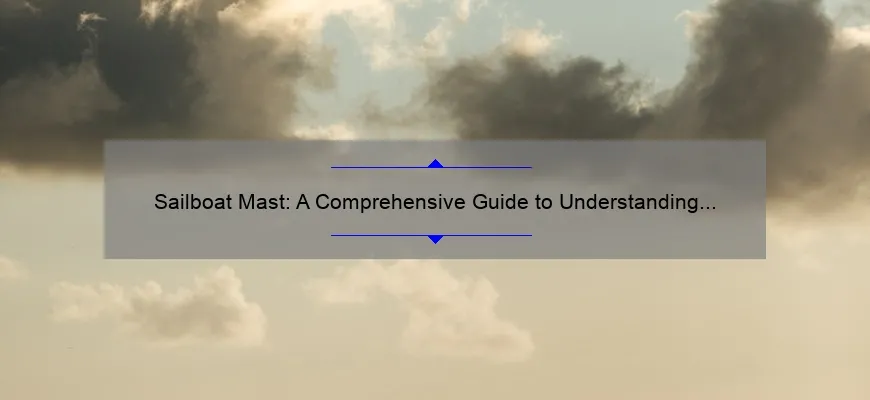
== Short answer: Sailboat mast == A sailboat mast is a vertical pole or spar that supports the sails of a sailboat. It provides structural stability and allows for adjustment of the sail position to effectively harness wind power. Typically made of aluminum or carbon fiber, mast design varies based on boat size, sailing conditions, and intended use.
The Sailboat Mast: A Comprehensive Guide for Beginners
Title: The Sailboat Mast: A Comprehensive Guide for Beginners
Introduction: Ah, the majestic sailboat mast! Like the beating heart of a ship, it stands tall and proud, guiding us through the vast ocean. But what does it actually do? How does it work its magic to harness the power of wind and propel us across water? In this comprehensive guide for beginners, we’ll dive deep into the world of sailboat masts to unravel their secrets and discover why they are indeed a sailor’s best friend.
1. Anatomy of a Sailboat Mast: To understand how a sailboat mast functions, let’s start by dissecting its anatomy. The mast consists of several essential components such as: – Luff track: This vertical groove allows the mainsail to slide up or down smoothly. – Spreaders: These diagonal bars help strengthen and stabilize the mast. – Shrouds and stays: These supportive cables hold the mast in position while also countering sideways forces. – Sheave boxes: Found at strategic points on the mast, these small wheel-like mechanisms assist with hoisting sails or other rigging tasks. By familiarizing ourselves with these various parts, we can appreciate how each plays a crucial role in maintaining balance and stability.
2. Materials Matter: Masts can be constructed from different materials including wood, aluminum alloy, carbon fiber composite, or even stainless steel. While wooden masts exude classic charm, modern technologies have introduced lighter options like carbon fiber that enhance performance and durability. The choice of material depends on factors such as boat size, sailing purpose (racing or cruising), budget constraints, and personal preferences.
3. Setting Sail: Hoisting Techniques Hoisting your sails is an art in itself – a symphony between wind and rigging systems. When raising your main sail, you can rely on either external halyards run externally to pulleys at deck level or internal halyards hidden inside the mast. The former allows for easy maintenance and inspection, whereas the latter provides a sleeker aesthetic appeal. Whichever method you choose, proper hoisting techniques are crucial to avoid tangling or jamming.
4. Sail Control: Mast Dynamics Understanding how the sail interacts with the mast is essential for optimizing performance. Controlling sail shape is achieved through tensioning and releasing various lines such as halyards, cunninghams, and outhauls. These adjustments influence mast bend, which in turn affects the distribution of power and aerodynamic efficiency of your sails. A well-tuned mast ensures efficient sailing in different wind conditions.
5. Stepping Up: Installing a Sailboat Mast Stepping a mast may provoke anxiety among beginners, but fear not! With careful planning and some assistance, it can be an invigorating part of preparing your sailboat for action. From proper alignment to securely attaching shrouds and stays, following step-by-step procedures helps avoid mishaps during this critical process.
6. Maintenance Matters: Regular maintenance extends the lifespan of your sailboat mast while ensuring safety on the water. Frequent inspections for corrosion, cracks, or loose fittings are essential. Additionally, lubricating moving parts like sheaves and checking tension in standing rigging help guarantee smooth sailing adventures.
Conclusion: Congratulations! As you reach the end of this comprehensive guide on sailboat masts, you’ve gained invaluable insights into their anatomy, materials used in construction, hoisting techniques, dynamics correlation with sails – all topped off with stepping tips and maintenance reminders. Now equipped with this knowledge foundation, novice sailors can embark confidently upon their seafaring journeys armed with an understanding of just how crucial the majestic sailboat mast truly is – a steadfast partner harnessing wind power while propelling us towards endless maritime horizons!
How to Choose the Perfect Sailboat Mast for Your Vessel
When it comes to sailing, one of the most crucial components of your vessel is undoubtedly the sailboat mast. It serves as the backbone and lifeline of your boat, allowing you to harness the power of the wind and navigate through the vast open waters. Choosing the perfect sailboat mast is not a decision to be taken lightly; it requires careful consideration of various factors to ensure optimal performance and safety.
Firstly, before delving into the specifics, it’s important to understand that sailboat masts come in different materials, each with its unique set of characteristics. The most common options are aluminum and carbon fiber. While aluminum masts offer durability at a lower cost, carbon fiber masts are lighter and stiffer, providing enhanced performance on the water.
Now let’s embark on our journey to select the ideal sailboat mast for your vessel! The first crucial factor to consider is your boat’s size and weight. A larger, heavier vessel would require a mast with greater strength and rigidity to withstand increased loads from larger sails. On the other hand, smaller boats may benefit from a lighter mast that allows for more flexibility in sail adjustments.
Next up is understanding your sailing goals – are you more inclined towards leisurely cruising or competitive racing? If you’re an avid racer seeking top-notch performance, a carbon fiber mast might be your best bet due to its stiffness and superior response to wind conditions. However, if you prioritize comfort and relaxation during casual sailing trips, an aluminum mast could provide suitable stability without compromising on enjoyment.
Another aspect not to be overlooked is ease of maintenance. Aluminum masts generally require less upkeep compared to their carbon counterparts as they are less prone to damage from UV rays or accidental impacts. Carbon fiber masts demand regular inspection for any signs of wear or stress fractures since they can’t handle excessive bending or compression forces as well as aluminum.
Moreover, think about where you’ll primarily be sailing – will it be in open, unrestricted waters or areas with low bridges and height restrictions? Mast height plays a significant role here. Ensure your chosen mast fits within the clearance limits to avoid any unpleasant surprises during your journeys.
Sailboat masts come in various configurations, including single-spreader, double-spreader, and even triple-spreader setups. The number of spreaders – horizontal struts that help support the mast – affects overall stability and rigging options. Generally, single-spreader masts are easier to handle for casual sailors, while double or triple spreads offer higher performance but demand more meticulous tuning.
Lastly, it’s worth noting that the perfect sailboat mast doesn’t necessarily mean splurging on the most expensive option available. A comprehensive comparison of prices and features from different manufacturers can lead you to an ideal balance between affordability and quality.
At this point in our mast-selection odyssey, you should have a clearer picture of what to consider when choosing the perfect sailboat mast for your vessel. Remember to evaluate factors such as materials (aluminum vs. carbon fiber), boat size/weight, sailing goals (cruising vs. racing), maintenance requirements, clearance restrictions, spreader configuration, and cost-effectiveness.
Now set sail confidently with a mast tailored precisely to meet your vessel’s needs and embark on countless unforgettable nautical adventures! Bon voyage!
Step-by-Step Installation of a Sailboat Mast: A Beginner’s Guide
Are you a sailing enthusiast who has always been fascinated by the graceful movement of sailboats gliding through the water? Do you dream of owning your own sailboat and embarking on exciting adventures in the open sea? If so, then one of the essential skills you need to acquire is how to install a mast on a sailboat. In this beginner’s guide, we will walk you through the process step-by-step, ensuring that even if you have never done it before, you will be able to tackle this task with confidence and expertise.
1. Tools and Preparation: First things first – gather all the necessary tools for the job. You will need a crane or hoist (if available), a torque wrench, mast wedges, shims, sail track lubricant, an adjustable wrench or socket set, and plenty of patience! Before starting the installation, ensure that both your boat deck and mast are clean and free from dirt or debris.
2. Preparing the Mast Step: The mast step is where your mast rests on your boat deck. Start by inspecting it thoroughly for any damage or wear that may compromise its integrity. If needed, reinforce or repair it before proceeding further. Place mast wedges under the front part of the mast step to act as support when installing.
3. Attach Necessary Fittings: Now it’s time to attach various fittings onto your mast which are crucial for rigging control lines and sails effectively. These include halyard sheaves (for raising and lowering sails), spreader brackets (providing horizontal support), and any other attachments specific to your sailboat model.
4. Hoisting with Precision: Here comes the exciting part – hoisting your sailboat mast into position! Ideally, use a crane or hoist designed explicitly for this purpose so that you can easily control its vertical movement while minimizing the risk of damage. Carefully guide the mast toward the mast step, ensuring it is centered and aligned correctly.
5. Adjusting for Precision: Once your mast is in place, it’s time to make fine adjustments to ensure its vertical alignment. Use shims or wedges as necessary to eliminate any gaps between the mast and mast step. This step is crucial as it ensures that your sailboat will perform optimally on the water without any unnecessary stress on either the mast or your rigging.
6. Securing with Confidence: Now that your mast is perfectly aligned, it’s time to secure it in place. Start by cautiously tightening the bolts on each side of the base using an adjustable wrench or socket set. Remember not to overtighten, as this can potentially damage both your boat and mast. Once done, check all fittings once again and confirm they are securely attached.
7. Lubrication for Smooth Sailing: To ensure flawless movement of your sails along the track, apply a suitable sail track lubricant generously over your sail track after installation while closely following manufacturer guidelines. This lubrication will minimize friction when hoisting or lowering sails, resulting in a smoother sailing experience overall.
Congratulations! You have successfully installed a sailboat mast from start to finish! By following these step-by-step instructions with patience, attention to detail, and our witty guidance, you have gained valuable knowledge that will enable you to embark on countless sailing adventures confidently.
However, always remember that safety should be your number one priority whenever working with equipment related to sailing vessels. If at any point you feel unsure or overwhelmed during this installation process, do not hesitate to seek professional assistance from an experienced sailor or marine technician who can offer guidance specific to your sailboat model.
With newfound expertise in installing masts and pursuing many thrilling sea voyages ahead, set forth with confidence into uncharted waters – bon voyage!
Common FAQs about Sailboat Masts Answered
Sailing enthusiasts often find themselves captivated by the majestic beauty of sailboats gliding through the water. One key component that allows these vessels to harness the power of wind is the sailboat mast. However, many individuals who are new to sailing may have questions about masts and their importance in sailing. In this blog post, we aim to provide detailed and professional answers to some common FAQs about sailboat masts while injecting a touch of wit and cleverness along the way.
1. What is a sailboat mast? Ah, the central pillar of sailing prowess! A sailboat mast is essentially a vertical structure that stands tall and proud on a vessel, supporting the sails and imparting stability to your seafaring adventure. Think of it as the backbone upon which your nautical dreams come to life!
2. Why is choosing the right mast crucial for efficient sailing? Picture this: you’re in command of your trusty sailboat, ready to conquer the sea’s vast playground. But alas! Your hasty choice of an ill-suited mast has left you floundering like a fish out of water! The right mast offers optimal rigidity, balance, and strength necessary for efficient navigation regardless of wind conditions or sea state.
3. Aluminum or carbon fiber? Which material reigns supreme for masts? Ah, here lies one’s decision-making predicament! Does one opt for aluminum – sturdy like an old lighthouse but slightly heavier? Or does one embrace carbon fiber – lightweight as an albatross feather yet remarkably robust? Both materials have their merits; therefore, choosing between them boils down to personal preference and intended usage.
4. Can I upgrade my existing mast without breaking the bank? Fear not, fellow mariner! While pursuing that luxurious upgrade might conjure images of treasure chests filled with gold doubloons disappearing into Davy Jones’ locker, there are cost-effective options available. Opt for used masts in good condition, or explore local sailing communities where fellow sailors may be willing to part with their old but serviceable masts.
5. How can I ensure proper maintenance of my sailboat mast? Ahoy, matey! Maintenance is the key to keeping your mast shipshape and preventing any unwanted surprises on your voyage. Regular inspections for cracks, corrosion, or loose fittings are akin to swabbing your deck – tedious yet necessary. Additionally, ensuring proper storage and protecting your mast from harsh elements will keep it standing tall through the test of time!
6. Can a damaged mast be repaired or must it walk the plank? Nay, despair not as all hope is not lost! In cases of minor damage like small cracks or dings – worry not! Reliable craftsmen specializing in mast repairs can work their magic and have your trusty companion primed to conquer the waves once more. However, in more severe instances of structural compromise, replacing the mast might be the only option left.
7. How do I decipher the mysterious language of sailboat mast measurements? Approach ye with careful study, for understanding these mystifying dimensions requires an astute mind! Height measured from deck to tip (known as height aloft), length along its backside (called luff measurement), and even diameter play a significant role in determining compatibility with your vessel’s rigging system. Consult experts fluent in this ancient tongue to avoid any discrepancies on your nautical journey!
In summary, sailboat masts are no mere aesthetic addition; they are essential components that provide stability and sailing prowess to vessels at sea. Choosing the right material and maintaining them diligently ensures smooth sailing adventures without scuppering one’s budget. So set your sights high, dear reader, for these answers shall guide you towards a more enlightened understanding of sailboat masts!
Important Factors to Consider When Maintaining Your Sailboat Mast
Sailing is a thrilling and invigorating experience that allows us to connect with nature, challenge ourselves, and explore the vast open waters. However, as with any adventure, there are certain aspects that we must pay close attention to in order to ensure a safe and successful voyage. One such critical component of a sailboat that demands careful maintenance is the mast. The mast serves as the backbone of your vessel, providing structural integrity and supporting your sails. In this blog post, we will delve into some important factors to consider when maintaining your sailboat mast.
Structural Integrity: The first and foremost factor that you need to consider when maintaining your sailboat mast is its structural integrity. Any signs of damage or wear and tear should not be taken lightly, as it can compromise the overall stability and safety of your vessel. Regularly inspecting your mast for any cracks, dents, or corrosion is crucial to identify any issues early on before they escalate into major problems. Additionally, keep an eye out for loose or rusted fasteners and make sure all connections are secure.
Rigging Wear: Another vital aspect of keeping your sailboat mast in top condition is paying attention to its rigging components. Rigging includes various cables, wires, and ropes responsible for controlling the sails’ position and tension. Over time, these elements can experience significant wear due to exposure to sun, saltwater, intense winds, or simply general usage. To maintain rigging longevity and ensure safety while sailing, regularly examine all parts for fraying strands or broken wires. Furthermore, proper tensioning of rigging should be maintained as per manufacturer recommendations.
Cleanliness: Maintaining a clean sailboat mast may sound like an obvious consideration but is often overlooked by many boat owners. A dirty mast not only affects the aesthetics but can also lead to performance issues if left unattended for too long. Accumulated dirt, grime, salt deposits or marine growth can create unwanted drag, hindering the sailing experience. Regular cleaning with mild soapy water and a soft brush is generally sufficient to remove stubborn stains and prevent corrosion.
Painting: Maintaining the aesthetic appeal of your sailboat mast should also be on your priority list. A fresh coat of paint not only enhances its appearance but also offers added protection against corrosion. Prior to painting, ensure that the mast is thoroughly cleaned and all rust or peeling paint is removed. Use a high-quality marine-grade paint specifically designed for aluminum or wooden masts, depending on the material of your sailboat’s mast.
Inspections: Performing routine inspections by a professional is an essential factor in maintaining your sailboat mast. It is recommended to have an experienced rigger thoroughly inspect your mast at least once a year, or more frequently if you actively engage in competitive racing or regularly navigate harsh conditions. These experts have the knowledge and expertise to identify potential weaknesses that may go unnoticed by untrained eyes, providing peace of mind and preventing any unexpected mishaps on your sailing journeys.
In conclusion, maintaining your sailboat mast requires careful attention to detail and regular inspections. By prioritizing factors such as structural integrity, rigging wear, cleanliness, painting, and professional inspections, you can ensure that your vessel remains in excellent condition for countless captivating voyages ahead. So set sail with confidence knowing that you’ve taken every measure to maintain this vital component of your beloved sailboat!
Discover the Different Types of Sailboat Masts and Their Advantages
Sailing is an activity that combines the thrill of speed with the serenity of the open water. One crucial component of any sailboat is the mast, which not only provides structural support but also plays a vital role in determining a boat’s performance and handling characteristics. To help you dive deeper into this fascinating world, we will explore the different types of sailboat masts and highlight their advantages.
1. Fractional Masts: Let’s start with fractional masts, which are one of the most common types found on sailboats today. As the name suggests, these masts divide the rig into two sections: upper and lower. The ratio of the length between these sections can vary, offering flexibility depending on sailing conditions and desired performance.
Advantages: – Versatility: Fractional masts allow for fine-tuning your sails by adjusting halyard tension or configuring additional stays. – Better control in strong wind conditions: The longer lower section provides stability and prevents excessive heeling (tilting) usually encountered during high winds. – Improved balance: By placing more weight aloft, fractional masts offer better balance when tacking (changing direction against the wind).
2. Masthead Masts: In contrast to fractional masts, masthead masts have their forestay attached at or near the masthead rather than a fraction down its length. Traditionally seen on older cruising boats, they offer distinct advantages for particular sailing styles.
Advantages: – Strong downwind performance: With their design allowing for larger headsails like genoas or asymmetrical spinnakers, masthead rigs excel in reaching or downwind courses. – Easy to balance for autopilot usage: Due to a greater proportionality between mainsail area and foresail area when compared to fractional rigs, mastheads tend to require less manual adjustment while under autopilot control.
3. Keel-stepped vs Deck-stepped Masts:
3.a. Keel-stepped Masts: Keel-stepped masts are secured and supported by the boat’s keel, extending through the deck to connect with it at the base. This type of rig is commonly found on larger sailboats designed for offshore sailing.
Advantages: – Superior strength: The keel provides excellent support for the mast against heavy loads encountered during rough weather conditions. – Reduced deck compression: By transferring the load directly to the keel, stress on the deck is minimized, ensuring a longer-lasting and more reliable structure overall.
3.b. Deck-stepped Masts: Deck-stepped masts sit on top of a sailboat’s deck, rather than being connected directly to the keel. Typically seen on smaller boats and cruising vessels, they have their own set of advantages.
Advantages: – Easier maintenance: With no penetration through to the hull like keel-stepped masts, maintaining or replacing deck fittings becomes less complicated. – Cost-effective construction: As there is no need for precision alignment with a keel box, constructing a boat with a deck-stepped mast can reduce building costs. – Adjustable height: Deck-stepped masts offer flexibility in terms of adjusting their height based on clearance requirements for bridges or overhead obstructions.
Understanding these various types of sailboat masts empowers sailors to make informed choices when selecting or upgrading their vessel’s rigging. Each mast type brings its own set of advantages that can significantly impact your sailing experience depending on different conditions and preferences.
Recent Posts

- Sailboat Gear and Equipment
- Sailboat Lifestyle
- Sailboat Maintenance
- Sailboat Racing
- Sailboat Tips and Tricks
- Sailboat Types
- Sailing Adventures
- Sailing Destinations
- Sailing Safety
- Sailing Techniques
Welcome aboard the sailing yacht Atlantic
All about one of the most awesome classic yachts of all time, the three mast schooner Atlantic. Long time holder of the world record for the crossing of the Atlantic Ocean under sail, this one hundred and eighty-five foot schooner originally designed by William Gardner in 1903 has been relaunched and is sailing once more.
The Atlantic is currently in the western Mediterranean, and available for luxury sailing yacht charters.

Parts of a Sailboat: Essential Components Explained
Sailboats are fascinating vessels that have been used for centuries to explore and navigate the world's oceans. These boats harness the power of the wind to propel themselves across the water.
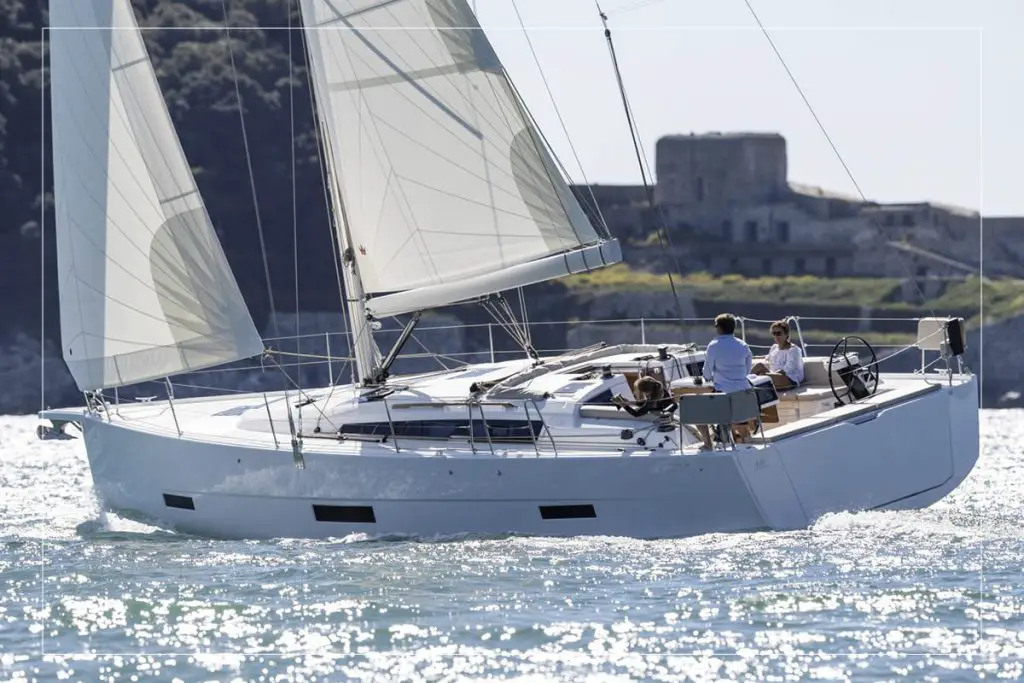
To fully appreciate and understand sailboats, it's important to familiarize yourself with their various parts and components.
There are several vital parts to a sailboat that help it function smoothly on the water. These components can be broadly divided into the hull, the sailing hardware, and the living quarters.
Understanding each component's role in maintaining the boat's speed, stability, and maneuverability will enhance your sailing experience and allow you to tackle various challenges out on the water.
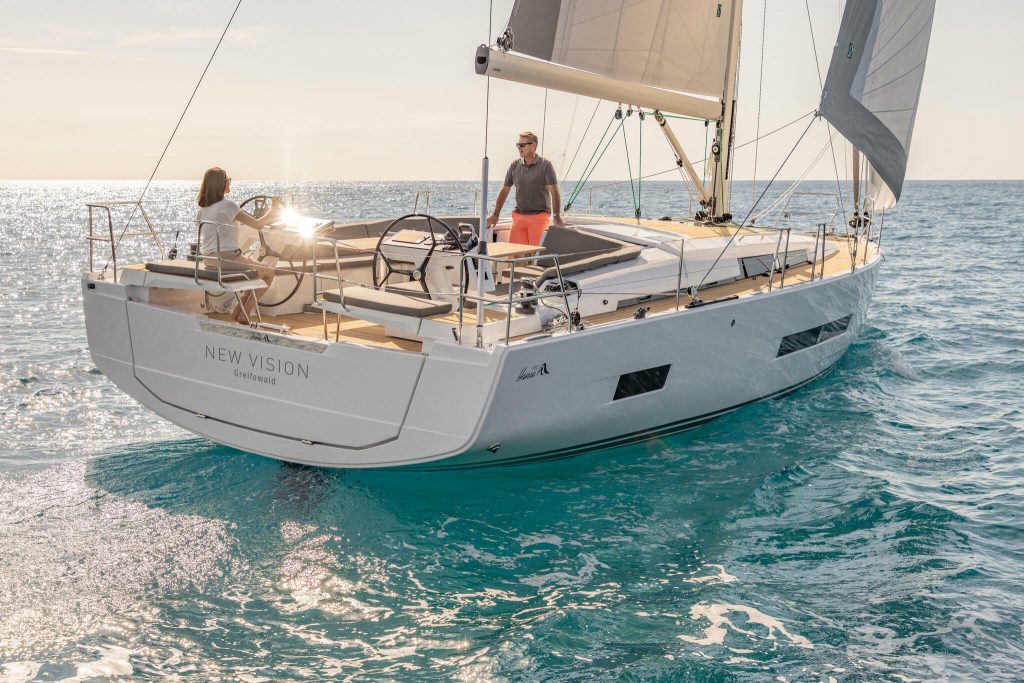
Key Takeaways
- Understanding sailboat anatomy is essential for appreciating the art of sailing
- Knowledge of rigging, sails, stability, and navigation is crucial for a smooth sailing experience
- Sailboats vary in types and size, each with its own unique characteristics and requirements
Sailboat Anatomy
The hull is the main body of a sailboat, providing buoyancy and stability in the water. It's crucial for keeping us afloat and is typically made of materials like fiberglass, wood, or metal 1 .
The shape and design of the hull can vary, depending on the type of sailboat.
There are various parts of the hull that are essential to know, such as the bow (forward part), stern (aft part), waterline, bilge, and rudder 1 .
The deck is the horizontal surface that covers the hull of a sailboat. It's where I walk, sit, and operate the boat.
The deck is an essential part of the sailboat because it provides structural strength and supports features such as the mast, rigging, and winches 2 .
Some key deck components include the bow, stern, lifelines, cleats, and hatches for accessing the cabin below.
The cockpit is the area where I control and steer the boat, usually located towards the stern 3 .
It can be either an open or enclosed space, depending on the boat's design and intended use.
Key components I find in the cockpit are the helm, tiller, or wheel for steering, as well as the navigation and communication instruments. The cockpit also usually contains the primary winches, lines, and clutches for sail control 3 .
The cabin is located below the deck and is the living space on a sailboat 4 .
It offers shelter from the elements and is typically where I find berths for sleeping, a galley for cooking, a head for bathroom facilities, and storage for personal belongings.
The cabin layout and size can vary greatly depending on the boat's size and design 4 .
Rigging Components
The mast is the tall vertical spar that supports and extends the sails on a sailboat . It stands on the boat's hull, usually at its center, and serves as the backbone of the sailboat's rigging system.
In my experience, there are various types of mast s, such as single masts, double masts, and even triple masts, depending on the design and size of the sailboat.
The boom is the horizontal, supporting spar that attaches to the foot (bottom edge) of the mainsail and runs perpendicular to the mast.
It helps control the shape and angle of the sail relative to the wind, enhancing the boat's performance.
I always make sure that the boom is securely attached to the mast and that all necessary hardware is in good working condition.
Standing Rigging
Standing rigging refers to the set of fixed components that support the boat's mast and keep it properly aligned and positioned.
The primary components in this category are the stays and shrouds.
Stays are the wires or rods that run forward, aft, or diagonally from the mast, while shrouds run from the mast to the sides of the sailboat.
These components are crucial to the structural integrity of the rigging, so I always check them for wear and tear, and proper tension.
- Stays : These can be further divided into forestays, backstays, and side stays.
- Shrouds : These include upper, intermediate, and lower shrouds, depending on their position.
Running Rigging
Running rigging encompasses the adjustable components of a sailboat's rigging system that help me control the sails' position and tension.
Key elements of running rigging are halyards, sheets, and blocks.
- Halyards : These are the lines (ropes) used to hoist (raise) and lower the sails. On my sailboat, I use a mainsail halyard, jib halyard, and a spinnaker halyard when needed.
- Sheets : They are the lines I use to control the angle of the sails relative to the wind, adjusting their trim for optimal efficiency. The mainsheet, jib sheet, and spinnaker sheet are the most common ones I encounter.
- Blocks : Blocks or pulleys are essential for making my work easier when handling the rigging. They help redirect the force in the lines and provide mechanical advantage when I need to tension the sails or handle the sheets.
Sails and Sail Handling
The mainsail is the primary sail on a sailboat and is attached to the mast and boom. It plays a crucial role in propelling the boat forward by capturing the wind.
The mainsail consists of three edges: the luff , which is the forward edge, the leech , the aft edge, and the foot , the bottom edge.
To control the shape of the mainsail, I can use the following techniques:
- Adjust the tension on the outhaul , which controls the foot tension.
- Adjust the tension on the halyard to control the luff tension.
- Modify the boom vang tension to control the leech tension.
Headsails are the sails located in front of the mast. They include the jib and the genoa .
A jib is a smaller sail, which is easier to handle and suitable for moderate to strong wind conditions. The genoa is a larger headsail that provides more power in lighter winds. Both these sails feature a luff, leech, and foot similar to the mainsail.
When using a jib or genoa, I can trim the sail by adjusting the sheet (the line that controls the angle of the sail relative to the wind) and the lead position (which is where the sheet attaches to the sail).
By properly trimming the headsail, I can optimize its performance and maintain a balanced sail plan. The guide to sail anatomy is helpful for understanding specific parts of a sail.
A spinnaker is a specialized sail designed for sailing downwind, away from the wind's source. It is a large, lightweight, and billowing sail, constructed from a thin fabric that captures the wind from behind and propels the boat forward.
When setting up a spinnaker, I handle the sail by using:
- Tack line : A line that controls the sail's lower corner, where it meets the bow of the boat.
- Halyard : A line that hoists and lowers the sail.
- Sheet : The line that controls the angle of the sail relative to the wind.
Spinnakers can be challenging to handle due to their size and sensitivity to wind gusts. However, with practice and proper sail handling techniques, I can use the spinnaker effectively to enhance my downwind sailing performance and enjoyment.
Keel and Stability
There are several types of keels that serve different purposes and provide varying levels of stability to a sailboat. The most common types of keels are fin keels , bulb keels , wing keels , bilge keels , and lifting keels .
- Fin keels are quite popular and extend straight down from the hull. They provide a great balance between stability, performance, and ease of movement in the water. You can read more about fin keels in this Illustrated Guide .
- Bulb keels consist of a fin keel with a heavy bulb at the bottom to lower the center of gravity and improve the boat's stability.
- Wing keels feature horizontal "wings" to enhance the sailboat's ability to sail close to the wind and minimize drift.
- Bilge keels are twin keels that run parallel along the port and starboard sides of the hull, typically found on smaller sailboats.
- Lifting keels are adjustable keels that can be retracted upwards to decrease the boat's draft, making it easier to navigate shallow waters.
Some sailboats also have canting keels , which can pivot from side to side to provide maximum stability when sailing at extreme angles.
A critical component of keel design is the ballast, which is typically made of heavy materials like lead or iron. The main purpose of the ballast is to provide stability by lowering the sailboat's center of gravity and counteracting the heeling forces generated by the wind on the sails.
Different types of keels have varying ballast configurations. For example, fin keels have ballast concentrated in a narrow fin, while bulb keels have the ballast located in a bulb at the bottom of the keel. In each case, the ballast ensures that the sailboat remains stable and upright, even in challenging sailing conditions.
In some smaller sailboats, such as dinghies, it's common to find a centerboard design instead of traditional keels. A centerboard is a retractable plate that provides lateral resistance, allowing the boat to sail upwind. In this case, the sailboat relies on the weight of the crew as ballast to maintain stability.
Steering System
The rudder is one of the essential components of a sailboat's steering system. It's mounted vertically on the stern (rear) of the boat and functions as the primary means of steering by deflecting water flow, which in turn changes the boat's direction.
There are different types of rudders such as the spade rudder, which is a common type used in modern sailboats. A spade rudder is fully submerged in water and not connected to the hull, giving it better maneuverability and control.
The tiller is a simple and traditional method for controlling the rudder. It is essentially a long lever attached directly to the top of the rudder.
I find that using a tiller offers me direct and immediate feedback from the rudder, making it easier to feel the boat's response to my steering inputs. Tiller steering is often preferred by many sailors on smaller sailboats due to its simplicity and connection with the sailing experience.
Larger sailboats tend to have wheel steering systems in place of a tiller. As a helmsman , I use the wheel to control the direction of the boat by turning it clockwise or counterclockwise.
The wheel is connected to a system of cables and pulleys, which in turn steer the rudder, allowing me greater leverage and control over the boat's steering.
Various parts of a sailboat's steering system:
| Component | Function | Preferred on |
|---|---|---|
| Rudder | Primary means of steering by deflecting water flow | All types of sailboats |
| Tiller | Direct lever attachment to the rudder, providing immediate feedback | Smaller sailboats |
| Wheel | Steering system that provides greater leverage and control | Larger sailboats |
Navigation and Safety Equipment
As a sailor, I rely on my compass to navigate and maintain a steady course.
There are two main types of compasses on sailboats, the fixed-mount compass and the handheld compass .
The fixed-mount compass is typically installed near the helm , providing me with continuous bearing information. Meanwhile, having a handheld compass on board serves as a backup in case the main compass fails or is damaged.
Safety is paramount when I am sailing, and having secure lifelines around the deck is essential.
Lifelines are made of stainless steel wire and are attached to the stanchions around the boat. I use them to minimize the risk of falling overboard while moving on the deck, particularly in rough seas or strong winds. They are crucial for my safety and the safety of my crewmates, ensuring we all stay onboard and secure.
When anchor ing my sailboat, I rely on an anchor and a windlass to secure the boat in place.
There are different types of anchors, such as the CQR , Danforth , and Bruce anchors, each with their unique design that suits different seabed conditions.
I typically use a windlass to deploy and retrieve the anchor. A windlass is a mechanical device that makes handling heavy anchors more manageable.
It is essential to regularly inspect and maintain the windlass and anchor to ensure they function as expected when anchoring in various weather conditions and locations.
In addition to the anchor, I also make use of a chain and rode , which connect the anchor to the sailboat:
- Chain: The chain attaches to the anchor and adds weight, helping the anchor dig into the seabed.
- Rode: The rode connects the chain to the boat and can be made of rope or a combination of rope and chain.
Sailing Hardware
Winches are an essential part of a sailboat. They help control the lines and sheets by providing mechanical advantage.
I find that winches are most commonly used for tightening or loosening the jib sheets and the mainsheet. They consist of a drum, a handle, and gears that allow for smooth operation.
The sailboat hardware available on the market today includes different types and sizes of winches to suit various boats and sailing needs.
When using a winch, it's important to wrap the line around the drum in a clockwise direction, making sure there are no overlaps or twists.
To control the tension, I always ensure that the winch handle is in the "ratchet" position. This allows me to easily apply force in one direction and hold the line in place when not turning.
Cleats are another vital piece of sailing hardware that come in various shapes and sizes. Their primary function is to secure lines, particularly when adjusting tension on sails.
I often use cleats on my boat to ensure that sheets and halyards stay in place while sailing.
Horn cleats are the most common type, with two projecting horns that allow the line to be passed around them in a figure-eight pattern.
Cam cleats, on the other hand, have two spring-loaded jaws that grip the line. This allows for easy adjustment and quick release if necessary.
In my experience, blocks are critical components of a sailboat's rigging system. They serve as pulleys that help redirect lines and reduce friction, making it easier to control sails.
Blocks are available in various materials such as stainless steel or aluminum . They also come with different configurations like single, double, or triple sheaves depending on the specific application.
For instance, I use a mainsheet block system in conjunction with a vang to control the tension and angle of the mainsail. Similarly, topping lift lines may pass through blocks to help raise and lower the boom easily.
Auxiliary Systems
One important auxiliary system in a sailboat is the motor . Sailboats often have an inboard or outboard engine , which provides extra maneuverability when needed.
This is particularly useful when the wind conditions aren't favorable. The motor's main components include the engine, transmission, and propeller . These work together to move the boat through the water when there's limited or no wind available.
A boat's electrical system is responsible for powering various devices onboard. The critical aspects of this system include the battery, alternator, and wiring, which connect different electronic components.
Some common devices that rely on the electrical system are navigation systems, LED lights, electronic sensors, and communication equipment.
In addition to navigation and communication, the electrical system also powers the bilge pump .
The bilge pump is a vital piece of equipment that helps remove water accumulated in the boat's bilges, preventing the vessel from flooding.
Here's a simple list of typical electrical system components:
- Switches and fuses
- Electronic devices (navigation, communication, etc.)
A sailboat's plumbing system usually consists of a freshwater system and a wastewater system.
The freshwater system supplies water to the boat's faucets, showers, and sometimes engine cooling. It includes a water tank, water pump, and piping to distribute the water.
The wastewater system, on the other hand, deals with disposing of used water and waste.
This generally includes a black water tank for toilet waste and a grey water tank for water from sinks and showers. These tanks need to be regularly emptied and maintained to prevent foul odors and maintain the boat's sanitation.
To recap, the plumbing system's main components are:
- Black water tank (toilet waste)
- Grey water tank (sink and shower waste)
Living Quarters
The galley is the sailboat's kitchen, where food is prepared and cooked. It's typically a small, compact area in order to maximize space and efficiency.
In most sailboats, the galley features a stove, sink, refrigerator, and storage.
Storage space, such as cabinets and drawers, is crucial because every inch of space is valuable on a sailboat.
To ensure user-friendly access to the utensils, cookware, and food items, sailboats may have organized storage solutions .
As for the saloon , it serves as the primary living area on a sailboat. This is where the crew gathers to relax, dine, and socialize.
The saloon usually features comfortable seating, a dining table, and additional storage space s.
I often find that this space is customizable, allowing for the conversion of tables into extra sleeping areas when necessary.
Natural light is also an essential aspect of the saloon, so it often has hatches and windows to allow sunlight in while providing a view of the surroundings.
Berths are the sleeping quarters on a sailboat. These designated areas, often equipped with cushions or mattresses, provide the crew with a place to rest during extended voyages.
Berths come in various sizes and configurations , ranging from single to double or bunk beds, depending on the size of the sailboat and the number of crew members.
As with other spaces on the sailboat, thoughtful design and attention to maximizing storage space is key.
In many berths, additional storage areas can be found under the beds or in nearby compartments.
Types of Sailboats
A monohull sailboat , as the name suggests, consists of a single hull. This design is common and comes in various forms, including cruising sailboats and racing sailboats .
One advantage of monohulls is that they generally have better upwind performance compared to multihulls.
A cruising sailboat is versatile and well-suited for long-distance sails, equipped with amenities to make life on board comfortable.
In contrast, racing sailboats prioritize speed and performance and often feature lightweight materials and specialized designs.
Multihull sailboats include both catamarans and trimarans, featuring two or three hulls connected by a central platform.
Catamarans have a pair of parallel hulls, which provides a wide and stable platform that reduces heeling. According to this guide , catamarans are known for their speed, comfort, and spaciousness, making them popular choices for vacationing and cruising.
Trimarans, on the other hand, have three hulls - a central hull flanked by two smaller outriggers.
The trimaran design offers a balance between stability, speed, and maneuverability, resulting in a quick, agile, and comfortable sailing experience.
A dinghy is a smaller sailboat , usually less than 15 feet in length.
Dinghies are simple, easy to maneuver, and relatively affordable. They can be used for various purposes, such as recreational sailing, sailing lessons, or as a tender for a larger sailboat.
Dinghies can have one or two sails and either a centerboard or a daggerboard to provide lateral resistance to the water.
Many beginners start their sailing journey with a dinghy because it's an excellent way to learn essential sailing skills before venturing onto larger sailboats.
Frequently Asked Questions
What are the different components of a sailboat's rigging?
The rigging on a sailboat consists of a system of ropes, wires, and chains that support the mast and sails. It can be divided into two main categories: standing rigging and running rigging.
Standing rigging includes the shrouds and stays, which are responsible for providing support to the mast.
Running rigging comprises all the lines used to control the sails, such as halyards, sheets, and outhauls.
Rigging components help sailors effectively control the sailboat and its movements.
How do the various parts of a sailboat function together?
The different parts of a sailboat work together to provide an efficient sailing experience.
The hull is the main body of the boat, while the keel provides stability and prevents sideways motion. The rudder is responsible for steering.
The mast and sails capture wind energy and enable propulsion. Rigging is crucial for controlling the position of the sails and ensures the boat's maneuverability.
This helpful guide offers an illustrated explanation of sailboat parts and their functions.
Can you name the sails typically found on a sailboat?
A common type of sailboat is the sloop, which has two sails: the mainsail and the jib.
Other sails that can be found on sailboats include the spinnaker, a large, lightweight sail used for downwind sailing, and the genoa, a larger version of the jib for increased sail area in light wind conditions.
You can read more about sail types in this comprehensive guide .
What is the purpose of the keel on a sailboat?
The keel is a critical component of a sailboat as it provides stability and prevents the boat from moving sideways in the water.
It acts as a counterbalance to the forces exerted by the wind on the sails and ensures directional control. The keel also contributes to the boat's hydrodynamic properties, reducing drag and promoting smooth movement through the water.
How is the mast of a sailboat structured and what are its key parts?
The mast is a vertical pole on a sailboat responsible for supporting the sails and rigging.
It is typically made of aluminum or carbon fiber for strength and lightness. Key parts of the mast include the spreaders, which help distribute the load along the shrouds, and the tangs, which are attachment points for stays and shrouds. Masts also have fittings for halyards and other rigging components essential to sail control.
What are the common features found in a sailboat's cockpit?
The cockpit is the central area of a sailboat where the crew controls the boat's operation. It typically includes the steering wheel or tiller (connected to the rudder), engine controls, and instruments for navigation and communication.
Additionally, the cockpit may feature winches and cleats for handling the sheets and other lines. You might also find seating or benches for the crew as well as storage compartments. More details on sailboat features can be found in this informative article .
Related Articles

Circle of Death: Boating Accidents and Prevention Strategies
Top 10 Used Boats for Sale: Expert Picks for Every Budget
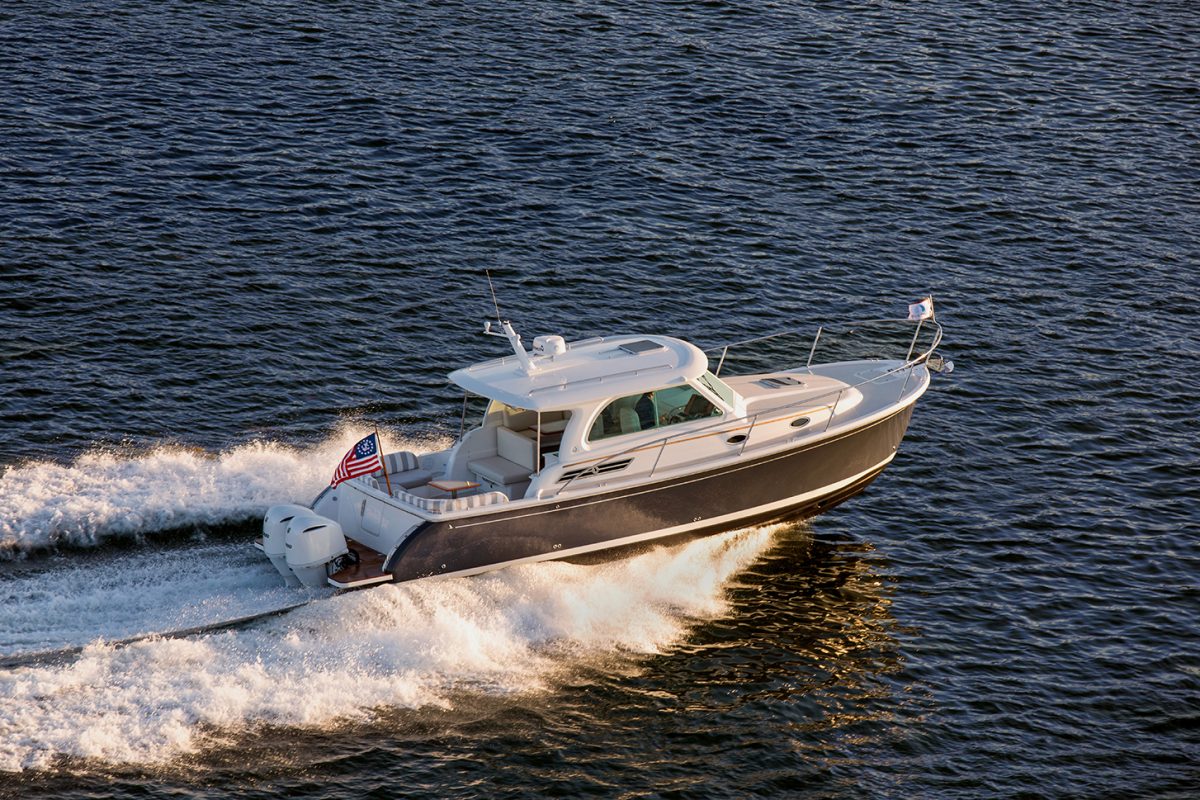
Back Cove 34 Outboard: What's New and Exciting in 2023

Malibu Wake Boat: The Ultimate Ride for Surf Junkies and River Rats
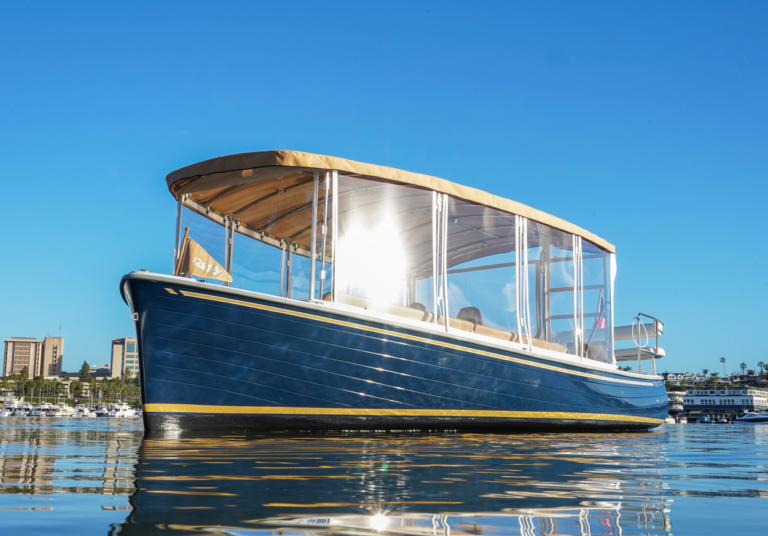
Duffy Boat: The Eco-Friendly Way to Cruise Coastal Waters
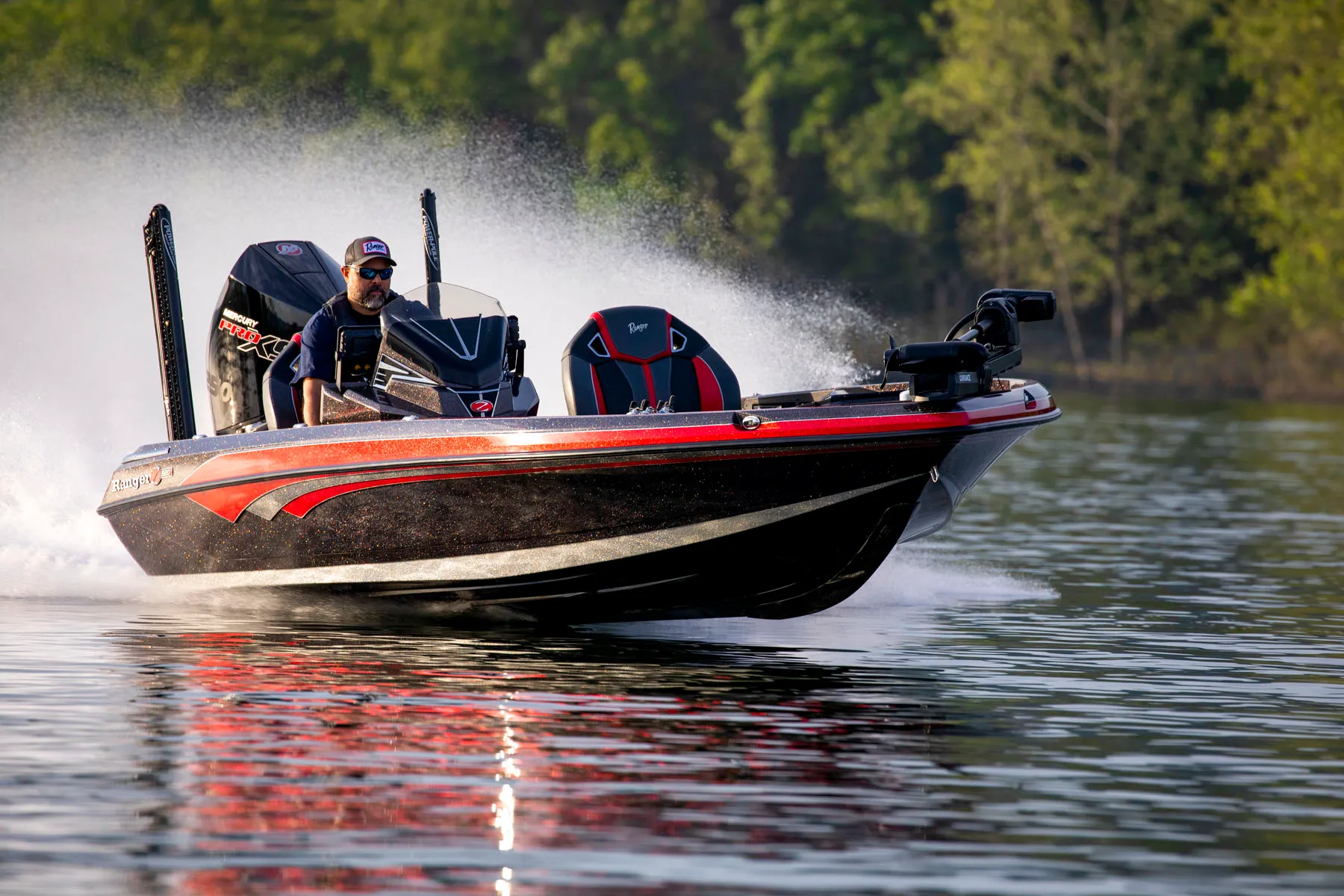
Bass Boat Brands 2024: Top Picks for Anglers This Year

Boat Slip Essentials: Maintenance and Safety Tips
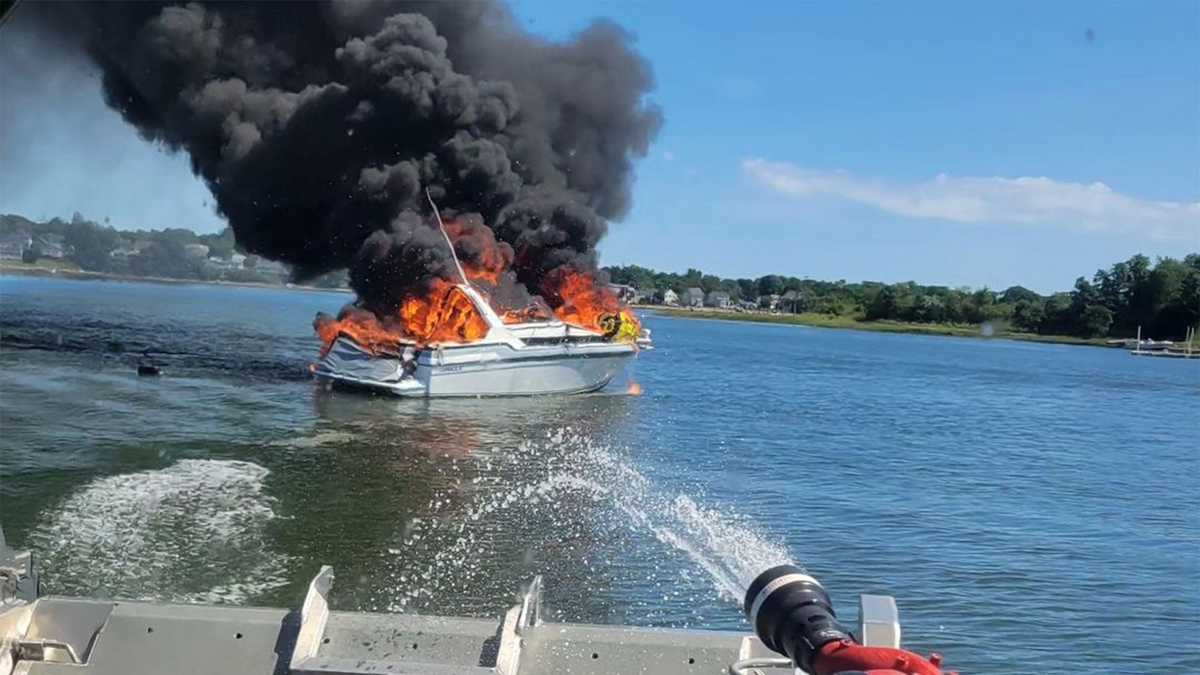
What Should You Do if a Fire Breaks Out in the Front of Your Boat? Essential Steps for Safety

- News & Views
- Boats & Gear
- Lunacy Report
- Techniques & Tactics
CRUISING SAILBOAT RIGS: Sloops, Cutters, and Solent Rigs
In our previous episode in this series we discussed what I like to call split rigs–ketches, yawls, and schooners–where a sailplan is divided among two or more masts. Cruising sailors once upon a time preferred such rigs, at least on larger cruising boats, because each separate sail requiring handling was smaller and thus more manageable. These days, however, by far the most popular rig for both racing and cruising sailboats is the simple sloop rig. This has a single mast supporting a single Marconi mainsail with a single headsail supported by a single headstay flying forward of it.
Its advantages are manifest: there are only two sails for the crew to handle, each of which can be hoisted with a single halyard and trimmed with a single sheet. While sailing, there are normally only two lines–the jib sheet and mainsheet–that need to be controlled at any given moment. And because there is but one headsail flying forward of the main, tacking a sloop is easy, since the headsail, even if it is a large overlapping genoa, can pass easily through the open foretriangle.
Sloop rigs are highly efficient to windward, thanks to the so-called “slot effect” created by the interaction of the mainsail and headsail. How this actually works is a matter of some debate. The traditional theory is that airflow in the narrow slot between the sails is accelerated, which decreases air pressure on the leeward side of the mainsail, thus increasing the lift the sail generates.
The revisionist theory is that air deflected from the headsail actually works to decrease airflow in the slot, increasing pressure on the windward side of the headsail, thus increasing the lift it generates. Since increasing the lift generated by one sail seems to necessarily decrease that generated by the other, others believe a single Marconi sail must be just as aerodynamic, if not more so, than two sails. This last proposition, however, is contradicted by real-world experience, as no one has yet created a single-sail rig that is as fast and closewinded as a double-sail sloop rig.
The almighty slot in action. Its effects are salubrious, but no one can really explain why
The primary disadvantage of a sloop rig is that the sails must be relatively large. They are therefore harder to handle in that they are heavier (making them harder to hoist) and generate larger loads when flying. Much of this difficulty, however, is obviated by modern winches and roller-furling gear, which is why sloop rigs are now so popular, and deservedly so. In light to moderate sailing conditions, which is what most sailors normally encounter, a sloop is by far the fastest, most easily handled rig currently available.
In heavier conditions sloops do present some challenges. To reduce sail area forward of the mast, if the headsail is hanked on to the headstay, which was the traditional practice, you must change the sail for a smaller one. This requires crew to work for extended periods on the bow of the boat, where conditions can get wild and wet. If the headsail is on a modern roller-furler, the sail can be easily roller-reefed from the cockpit, but past a certain point a roller-reefed headsail’s shape becomes inefficient. You either must live with this or unroll the sail and change it for another smaller one. The stronger the wind gets, the more distorted the roller-reefed sail becomes, and the more important it is to change it. Changing a sail on a furler in a strong wind, however, is an awful chore. The very first thing you must do (unroll the sail) greatly increases sail area right when you most want to decrease it. Then you must somehow control a large headsail as it comes off a furling rod with its luff unrestrained in strong wind.
Coastal cruisers are never likely to sail in strong conditions for very long. On the few brief occasions their boats are pressed hard they are normally willing to limp along on an ugly scrap of roller-reefed genoa. They are also more likely to have to short-tack their boats in confined areas, thus the ease of tacking a sloop makes it the rig of choice on coastal boats. Bluewater cruisers, on the other hand, may sail in strong weather for days on end, so there are advantages to cutting up the sail area in the foretriangle into smaller more manageable pieces. Bluewater cruisers traditionally therefore often prefer a cutter rig, which has a single mast and a headstay like a sloop, but also an inner forestay behind the headstay from which a smaller intermediate staysail can be flown.
Modern cutter-rigged cruiser sailing under a staysail and a reefed mainsail
The big advantage of a cutter rig is that in a big blow the jib on the headstay can come right off (or be rolled up) and the smaller staysail can carry on alone, more inboard and lower in the rig, where it balances better against the reduced area of a deeply reefed mainsail. Cutters are also efficient to windward, though some claim they are not as efficient as sloops. Personally, I’ve found cutters are sometimes actually more closewinded than sloops, at least in moderate to strong winds, as the sheeting angles on a pair of smaller, flatter headsails can be narrower than the angle on one larger, more full-bodied sail. In very heavy conditions, with just a staysail and reefed mainsail deployed, I believe a cutter is almost always more efficient to windward than a sloop.
On anything from a beam reach to a tight closehauled angle, a cutter can also fly both its headsails unobstructed. Sailing on a broad reach, however, the staysail blocks air from reaching the jib, reducing the rig’s effective sail area just when the decrease in apparent wind speed caused by the wind blowing from behind the boat demands that sail area instead be increased. Another problem is that a cutter requires extra standing rigging–not only the inner forestay, but also, very often, either an extra set of swept-back aft shrouds or a pair of running backstays to help support the inner forestay from behind. This adds complexity and increases rig weight well above the deck.
The biggest disadvantage of a cutter rig is that there are two headsails to tack (or jibe) across the boat instead of just one. There is an extra set of sheets to handle, plus the jib quarrels with the inner forestay every time it comes across the foretriangle. This is less of a problem if the jib is small and high-cut (these are called yankee jibs) so that it slips more easily through the narrow gap between the inner forestay and headstay. When flying a large genoa, however, crew must often go forward to help horse the sail around the inner forestay. If you don’t have enough crew for this, you may have to roll up part of the genoa (assuming it’s on a roller-furler) before tacking or jibing and unroll it again afterward, which is a bother. Also, if the wind grows strong again, but not so strong that you can sail on the staysail alone, you either have to change your genoa for a smaller sail or roller-reef it into an inefficient shape, which is (theoretically) precisely the conundrum that drove you to favor a cutter rig in the first place.
On a true cutter specifically designed to accommodate a staysail, the mast is usually farther aft than it would be on a sloop and/or there is a bowsprit to enlarge the foretriangle. This allows for a larger, more useful staysail and should enlarge the gap between the headstay and inner forestay so a jib can tack through more easily. A larger foretriangle also allows the jib to be larger without overlapping the mainsail, but a big overlapping genoa will still present problems when tacking or jibing.
A “true” cutter under sail. With the mast aft the foretriangle is bigger, which allows for a bigger, more useful staysail. As on this boat, a true cutter often flies a high-cut yankee jib forward of the staysail
The staysail can also be made club-footed with its own boom. Such a spar, known as a jib-boom, can be controlled by a single sheet that need not be adjusted when tacking. When short-tacking in enough breeze for the boat to sail under main and staysail alone this is the height of convenience. You can shift the helm back and forth without ever touching a line. A jib-boom, however, unless sheeted tight, will flail about the foredeck whenever its sail is luffing while being hoisted, doused, or reefed. It may harm crew on the foredeck during an accidental jibe, as it can sweep suddenly across the boat with some force unless restrained by a preventer.
A cutter-rigged cruiser with a club-footed staysail
Bear in mind, too, that enlarging the foretriangle, particularly on a boat without a bowsprit, usually means mainsail area must be reduced commensurately. In many cases the mainsail is then too small and/or too far aft for the boat to sail and maneuver under main alone. When attempting to dock, anchor, or moor under sail this can be a significant disadvantage. (Note, however, that many sloops are also often unable to maneuver under mainsail alone.)
One variation increasingly popular with bluewater cruisers is a sloop/cutter hybrid, sometimes called a slutter rig, where a removeable inner forestay is installed on what would otherwise be a straight sloop rig. The removable stay normally has some sort of quick-release mechanism at deck level that makes it easy to set up and tension the stay and to loosen and remove it. When stowed, the removeable stay is brought aft to the mast and secured.
Example of an inner forestay with a retro-fitted inner forestay with a quick-release fitting that allows the stay to be moved out of the way when desired
To a large extent, the slutter rig does offer the best of both worlds. In light to moderate winds you can stow the inner forestay and sail the boat as a straight sloop with one large genoa passing through an open foretriangle. In heavy conditions, you can set up the inner forestay, hank on a staysail, roll up or douse the large genoa, and sail the boat under main and staysail alone. Since setting up an inner forestay and hanking on a staysail is normally less taxing than stripping a large genoa off a furling rod and hoisting a smaller working jib and/or storm sail in its place, this is a viable practice.
Sometimes you see true cutters that have been converted to slutters. Here the foretriangle is normally large enough to fly two headsails simultaneously if desired, which is often not possible on a converted sloop. The downside to this arrangement is that making the inner forestay removable makes it impossible to install either a roller-furling staysail (currently a popular arrangement on cutter rigs) or a club-footed staysail.
Another variation that has appeared more recently is the so-called solent rig, where a solent stay is installed directly behind a boat’s headstay. The headstay carries a big genoa (usually on a roller-furler) that is flown in light to moderate wind, and the solent stay carries what is effectively a smaller working jib (or a “blade jib,” as some like to call them now) to fly in stronger conditions. The solent jib (which is normally larger than a staysail) can be rigged permanently on its own roller-furler, or it can be on a removable stay, as is seen on slutters and some cutter rigs.
The huge problem with a permanent solent rig is that the genoa forward on the headstay is normally so close to the solent stay that it cannot be pulled through the gap between the stays, but must be entirely rolled up and unfurled again every time the boat is tacked. In some cases the solent stay actually isn’t terribly close to the headstay, but still the top of the stay is always very close to the top of the headstay and tacking is thus always problematic. For this reason, personally, I strongly favor removable solent stays.
Typical solent rig with the two stays quite close together
On this example, the two stays are farther apart, until you get up to the masthead
One recent innovation that has made the handling of removable sails much easier are sails with torque-rope luffs that are mounted on continuous-line furlers. These were developed first on shorthanded ocean-racing boats, but are now leaking on to cruising boats with increasing frequency. For these to work the sail must usually be a lighter laminated sail rather than straight Dacron. A length of high-modulus rope especially designed to resist twisting, a torque rope so called, is sewn into the luff of the sail, which is then mounted on a removable lightweight continuous-line furling drum. Once the sail is hoisted with its torque rope tensioned it can be furled up on its own luff. It can also be taken down and stowed in a bag this way, all rolled up on itself. And it can be hoisted again while still rolled up. Handling the sail is thus very easy, as the only time it is unrolled and flying free is when you are actually flying it.
The great flexibility of a torque-rope sail actually gives you two different options if you are trying to create a solent rig. The smaller solent sail can be made a removable torque-rope sail, in which case you will be setting and flying it inside the headstay. Or you can keep a small working jib on your headstay and set up a larger removable genoa-size torque-rope sail forward of it. Sails like this have all sorts of names–Code Zero sails, screechers, gennakers, etc. The most important thing, if you are ordering one, is not what you call it, but rather that it is cut flat enough to sail efficiently to windward. Also, when flying such a sail you’ll need some sort of bowsprit forward of your headstay to carry it, and the sprit must be strong enough to carry the rig’s full headstay load when the sail flying.
The headsail arrangement on my cutter-rigged boat Lunacy . A triple-headsail sloop you might call it. The headstay and the inner forestay are permanently rigged. The screecher, as I call it, flies on its own luff forward of the headstay and is controlled with a removable continuous-line furler. The bowsprit and the plate under it were added to carry the big load the sail generates. When the screecher is flying the headstay goes slack and the screecher’s torque rope is what’s holding up the front of the mast
An IMOCA Open 60 flying a staysail on a continuous-line furler
A continuous-line furler up close and personal, removed from the rig with sail furled
Yet another option is to make the staysail in a cutter rig a removable torque-rope sail. I have seen these on shorthanded racing boats, but never on a cruising boat. I wonder sometimes if I should try it on my boat. If anyone has tried it on their boat, I do wish they would get in touch!
Related Posts

NICK SKEATES ON WYLO II: The Ultimate Barebones Cruiser and his Ultimate Dirt Simple Boat

NORTHBOUND LUNACY: Atlantic City, NJ, to Portland, ME
My last two boats–a Bristol 39 and a Warwick 47–have been sloops with inner forestays. The present Warwick has a r/f forstaysail so it’/s more or less permanent. This is a great heavy weather and offshore rig–perfect for the ocean and he Caribbean, the Med not so much. The forestayail is pretty small so it takes a considerable blow to make it the right choice.
Go easy on the torque rope idea unless a) the mast is beefed up for it b) the winches, lead blocks and the deck under the winch base on which the halyard lays are beefed up. You need to plan on having a halyard lock for the top of the torque rope AND a robust purchase to load the bottom end. THIS is how the race boats are set up Coop

Leave a Reply Cancel Reply
Save my name, email, and website in this browser for the next time I comment.
Please enable the javascript to submit this form

Recent Posts
- MAINTENANCE & SUCH: July 4 Maine Coast Mini-Cruz
- SAILGP 2024 NEW YORK: Lifestyles of the Rich and Famous
- MAPTATTOO NAV TABLET: Heavy-Duty All-Weather Cockpit Plotter
- DEAD GUY: Bill Butler
- NORTHBOUND LUNACY 2024: The Return of Capt. Cripple—Solo from the Virgins All the Way Home
Recent Comments
- Fred Fletcher on TIN CANOES & OTHER MADNESS: The Genius of Robb White
- Brian on THE BOY WHO FELL TO SHORE: Thomas Tangvald and Melody (More Extra Pix!)
- cpt jon on NORTHBOUND LUNACY 2023: Phase Two, in Which I Exit North Carolina via Oregon Inlet
- Sanouch on A PRINCE IN HIS REALM: The Amazing Life of Thomas Thor Tangvald
- January 2024
- December 2023
- November 2023
- October 2023
- September 2023
- August 2023
- February 2023
- January 2023
- December 2022
- November 2022
- September 2022
- August 2022
- February 2022
- January 2022
- December 2021
- November 2021
- October 2021
- September 2021
- February 2021
- January 2021
- December 2020
- November 2020
- October 2020
- September 2020
- August 2020
- February 2020
- January 2020
- December 2019
- November 2019
- October 2019
- September 2019
- August 2019
- January 2019
- December 2018
- November 2018
- October 2018
- September 2018
- August 2018
- February 2018
- January 2018
- December 2017
- November 2017
- October 2017
- September 2017
- August 2017
- February 2017
- January 2017
- December 2016
- November 2016
- October 2016
- September 2016
- August 2016
- February 2016
- January 2016
- December 2015
- November 2015
- October 2015
- September 2015
- August 2015
- February 2015
- January 2015
- December 2014
- November 2014
- October 2014
- September 2014
- August 2014
- February 2014
- January 2014
- December 2013
- November 2013
- October 2013
- September 2013
- August 2013
- February 2013
- January 2013
- December 2012
- November 2012
- October 2012
- September 2012
- August 2012
- February 2012
- January 2012
- December 2011
- November 2011
- October 2011
- September 2011
- August 2011
- February 2011
- January 2011
- December 2010
- November 2010
- October 2010
- September 2010
- August 2010
- February 2010
- January 2010
- December 2009
- October 2009
- Boats & Gear
- News & Views
- Techniques & Tactics
- The Lunacy Report
- Uncategorized
- Unsorted comments
- Anchoring & Mooring
- Boat Anatomy
- Boat Culture
- Boat Equipment
- Boat Safety
- Sailing Techniques
Navigating the high seas: Three mast sailing ships
Vessels such as three mast sailing ships have been an integral part of maritime history and have played a pivotal role in the growth and development of trade and exploration.
From the earliest wooden vessels to great clippers, sailing ships have evolved over the centuries, adapting to changing needs and improving technology. The many types of sailing vessels existing are less iconic than the three mast sailing ship.
These majestic vessels form a rich legacy in maritime history—a legacy born out of their impressive design specifications and construction processes, their unique daily life on board for crew members, some famous ships that are still remembered today, and much more.
This article will explore the fascinating history of three masted sailing ships.
Key Takeaways
- There are two main types of three-masted ships: square-rigged sailing ships and fore-and-aft rigged sailing ships.
- Three-masted ships were used for long-distance voyages and coastal trading and fishing, while fore-and-aft rigged sailing ships were mainly used for shorter trips.
- The design and construction of three-masted ships were critical to their success, and shipbuilders used various materials, including wood, metal, and natural fibers.
- Daily life on board a three-masted ship was challenging, with cramped living conditions and limited food rations.
- Navigating a sailing ship was complex, requiring understanding of stars, winds, currents, and tides, as well as the use of instruments such as sextants, compasses, maps, and charts.
- The evolution of sailboats, including Schooner, Ketch, and Yawl boats, has been driven by the needs and desires of sailors and has led to faster, more aerodynamic vessels with added amenities for comfort.
Types of three masted ships
Square Rigged Sailing Ships are large, rectangular vessels characterised by large sails and yards suspended from masts. These ships are known for their stability and efficiency in windy conditions, making them ideal for long-distance voyages.
Common types of Three-Mast Square Rigged Sailing Ships include the Bark, Barque, and Brig – all renowned for their durability, cargo capacity, and efficiency in rough seas.
Fore-and-aft rigged sailing ships are the opposite of square-rigged vessels; they have smaller and more flexible sails set parallel to the keel, making them more agile but slower than square-rigged boats. These ships were primarily used for shorter trips, such as coastal trading and fishing, with examples including Schooners, Ketches, and Yawls.
The primary purpose of these three mast sailing ships was to facilitate trade or exploration on long ocean voyages. Their ability to reach high speeds combined with their large cargo capacity made them ideal for travelling far distances safely.
On the other hand, fore-and-aft rigged sailing ships were used mainly for coastal trading or fishing due to their smaller size and agility when navigating narrow channels or shallow waters.
Design and construction of three mast sailing ships
The design and construction of three mast sailing ships were critical to their success. Shipbuilders used various materials for sails and ropes, including wood, metal, and natural fibres. Wood was the most commonly used material, with different types of wood used for other parts of the ship. Metal was used for reinforcing key areas such as the rudder and keel, while sails and ropes were made from natural fibres such as hemp or flax.
The design of three mast sailing ships incorporated several vital features, including the keel, rudder, and deck. The keel served as the ship’s backbone, providing stability, while the rudder allowed for steering. The deck was the main work area for storing supplies, handling cargo, and performing daily tasks.
Shipbuilding yards were typically located near waterways; constructing a ship could take several years. Skilled artisans, including carpenters, blacksmiths, and riggers, worked together using traditional techniques passed down over generations.
Life on a three mast sailing ship
Daily life on board a three-mast sailing ship was harsh and challenging , with cramped living conditions and limited food rations. The sailors worked long hours performing various tasks, including hoisting and trimming sails, steering the ship, and performing maintenance tasks.
Accommodations were limited, with most crew members sleeping in hammocks in the cramped quarters below deck. Meals were often simple and repetitive, consisting of salted meat, hardtack, and dried fruits and vegetables. However, the cook and stewards were still essential members of the crew responsible for feeding the crew and maintaining morale during long voyages.
The crew was divided into several distinct roles, each with its responsibilities and duties. The captain and officers were responsible for the overall operation, including navigation, voyage planning, and discipline. At the same time, sailors and deckhands formed the ship’s backbone and were responsible for hoisting sails, keeping watch, and other physical tasks.
Navigation and voyage planning
Navigating a sailing ship was an intricate and complex task requiring understanding the stars, winds, currents, and tides. The captain and officers used instruments such as sextants, compasses, maps, and charts to plan their course and navigate the ship.
Weather patterns were also considered for voyage planning, as storms or rough seas could potentially slow or derail a voyage. The crew had to be prepared for any possible danger, including shipwrecks or attacks by pirates; therefore, careful precautions had to be taken.
Ports of call during a voyage were welcomed opportunities for rest, resupply, and trade. Sailing ships often carried goods, including spices, textiles, and precious metals, which they traded in ports along their journey.
Famous three mast sailing ships
The Cutty Sark – Built-in 1869 in Scotland, The Cutty Sark was one of the last clipper ships to be built. It was designed for speed and used to transport tea from China to Britain in just over 80 days. The Cutty Sark is now preserved in a dry dock in London and serves as a museum where visitors can explore the ship and learn about its history.
The Flying Dutchman – A legendary ship said to be cursed and doomed to sail forever without making port; The Flying Dutchman has captured the imagination of people throughout centuries. Its tale of adventure has inspired many works of fiction, including the famous opera by Richard Wagner.
The Star of India – Built in 1863 on Ramsey, Isle of Man, this beautiful three-mast sailing ship was initially used for cargo transportation between England and India before becoming a training ship for the British Merchant Navy. Nowadays, she is preserved in San Diego, California and is open for public tours.
The HMS Victory – Launched in 1765, is best known as Admiral Horatio Nelson’s flagship at the Battle of Trafalgar in 1805. It now serves as a museum ship in Portsmouth, England.
Still sailing: the legacy of three mast sailing ships
The legacy of three-mast sailing ships is still evident today, and many have been preserved and restored to serve as museums and tourist attractions. These ships are a symbol of maritime history and provide a glimpse into the life and times of sailors. They also remind us of the importance sailing ships had in global trade, commerce, and international relations during the 16th to 19th centuries.
These ships were built for long voyages and could carry a high volume of cargo, making them particularly suited to transporting goods between countries. They played an instrumental role in establishing trade routes and bringing new markets together, thereby contributing to the growth of economies and industries.
Three mast sail ships also served another purpose: representing the power and prestige of their countries through flagships . Their voyages enabled the exchange of goods, ideas, and cultures across continents – essential for maintaining diplomatic relationships between nations when long-distance communication relied solely on sea transportation.
Significance in cultural and social history
Three mast sailing ships have had an immense influence on cultural and social history. They were involved in some of the most significant moments of exploration and colonial expansion, often resulting in far-reaching consequences that continue to be felt today.
Moreover, they have captured the imagination of artists, writers and filmmakers since ancient times; their romantic image has been depicted in countless works of art, literature and popular culture.
On top of that, these ships played a crucial role in developing seafaring technology and navigational practice. Their used advanced science and navigation, while their sailors’ experiences contributed to the emergence of new techniques and tools for sea travel. The legacy they left behind is now revered as a symbol of a bygone era – with many being used as educational resources to teach the history and science of maritime travel.
Modern-day uses of three mast sailing ships
Even though their use has declined, three-mast sailing ships remain a part of maritime heritage. They are used for various purposes, such as recreation and tourism. They make excellent tourist attractions, sometimes being restored and converted into museums – providing visitors with a unique insight into the world of seafaring.
Moreover, these ships are also utilised in educational programs wherein traditional sailing techniques and navigation are taught hands-on. These courses allow participants to experience life on the sea and learn about its rich history and culture.
Finally, three mast sailing ships are essential in preserving our maritime history and culture. Many organisations and groups strive to protect them by ensuring their continued maintenance – so that future generations can benefit from their legacy.
Evolution of schooner, ketch, and yawl boats
Throughout history, the evolution of sailboats has been driven by the needs and desires of sailors. From the three-mast ships of the early days to today’s modern Schooner, Ketch, and Yawl boats, the design and construction of these vessels have undergone a remarkable transformation.
In particular, the 19th and 20th centuries showed a significant shift in the use of sailboats – as they moved away from being primarily used for commercial purposes towards leisure and recreation. As such, boat designers began to pay more attention to making them aerodynamic to increase speed while adding cabins and other comforts to make them more suitable for leisurely outings.
Today’s Schooner, Ketch, and Yawl boats are among some of the most popular sailboats used; they are designed with speed and convenience in mind but also provide plenty of amenities for comfort. Thanks to lighter materials and advanced technology, these boats offer a faster sailing experience than ever – along with added strength and durability.
In short – these boats represent a symbol of how far sailing technology has come in terms of design and utility – creating an unparalleled sailing experience for all who step onboard.
The three-masted sailing ships of our maritime past were undeniably impressive vessels in terms of design and functionality. They served as a primary means of transportation for goods and people for centuries, setting the standards for sailing vessels worldwide. Their construction and design techniques were intricate processes that drew on elements of tradition, innovation, and skill.
Today, these ships continue to captivate us with their sheer size and power while providing an exciting glimpse into the seafaring world. While they may not be used as often nowadays, they will always serve as a reminder of the legacy they left behind – demonstrating the strength, resilience, and hard work of sailors who persevered through difficult times and dangers to explore, trade, and spread culture throughout the world.
Boom Vang Sailing Fundamentals
Reach new heights on a boat with a bosun chair, related posts, yacht vs boat: what is the difference, rib (rigid inflatable boat): a comprehensive guide, sib boat: a comprehensive guide.
- Cookie Policy
- Privacy Statement
© 2023 TIGERLILY GROUP LTD, 27 Old Gloucester Street, London, WC1N 3AX, UK. Registered Company in England & Wales. Company No. 14743614
Welcome Back!
Login to your account below
Remember Me
Retrieve your password
Please enter your username or email address to reset your password.
Add New Playlist
- Select Visibility - Public Private

- Forums New posts Unanswered threads Register Top Posts Email
- What's new New posts New Posts (legacy) Latest activity New media
- Media New media New comments
- Boat Info Downloads Weekly Quiz Topic FAQ 10000boatnames.com
- Classifieds Sell Your Boat Used Gear for Sale
- Parts General Marine Parts Hunter Beneteau Catalina MacGregor Oday
- Help Terms of Use Monday Mail Subscribe Monday Mail Unsubscribe
Triple Spreader Mast
- Thread starter Russf
- Start date Nov 30, 2011
- Forums for All Owners
- Ask All Sailors
I understand that a triple spreader mast requires a great deal more effort and skill to tune than a double spreader and offers no advantages for a 36 foot coastal cruiser. Appreciate some comments on this. Thanks.
DianaOfBurlington
They start to get pretty common on 44' and above race boats depending on the vintage of the design
Russf said: I understand that a triple spreader mast requires a great deal more effort and skill to tune than a double spreader and offers no advantages for a 36 foot coastal cruiser. Appreciate some comments on this.Thanks. Click to expand
Sandy Stone
On many cruiser-racers, multiple spreaders are used to allow a narrower shroud base to adequately support the mast. This in turn allows the jib to be sheeted in closer and hopefully let the boat point higher upwind. That being said, triple spreaders on anything but a racing boat is getting pretty extreme.
For the amount and type of use a normal coastal cruiser sees I can't see any reason for more than a double spreader rig. If you want very high performance characteristics then that is a different story. In that case you need to know how to maintain that system or it will use up much or your cruising capital. Ray
Triple spreader rigs are quite uncommon on CRUISING boats with less than a '65ft' (so called ICW) mast. As another poster stated the advantage is 'less weight aloft' (less mast 'stiffness needed) to lessen the 'roll period', to 'pre-bend' as needed for 'high performance' sailing etc. The disadvantage is the high cost and time of maintenance of the wire/terminals that are more prone to fatigue failure. For a high performance boat with a 'bendy rig' (rake and pre-bend - on the fly) tapered carbon fiber masts with less spreaders seem to be a distinct advantage over aluminum with more spreaders ... for even 'higher' cost. I have one on an ILYA Scow boat and I can on-the-fly add about 3+ ft. of fore/aft 'bend' that can flatten the mainsail to look like a 'flat sheet of plywood' ... instead of 'reefing' when going 'upwind'.
- This site uses cookies to help personalise content, tailor your experience and to keep you logged in if you register. By continuing to use this site, you are consenting to our use of cookies. Accept Learn more…
- Cruise search
- Atlantic Coast, Azores & Madeira
- Northern Europe
- Mediterranean Sea
- Canaries & Morocco
- Caribbean – Lesser Antilles & Grenadines
- Bahamas & Florida
- Costa Rica & Central America
- Transatlantic Crossing
- Service package
- Special offer
- Private charter
- Special occasion
- SEA CLOUD II
SEA CLOUD SPIRIT
- Fascinated by windjammer
- Low-impact tourism
- Newsletter subscription
- Feine Privathotels
- Meisterkreis
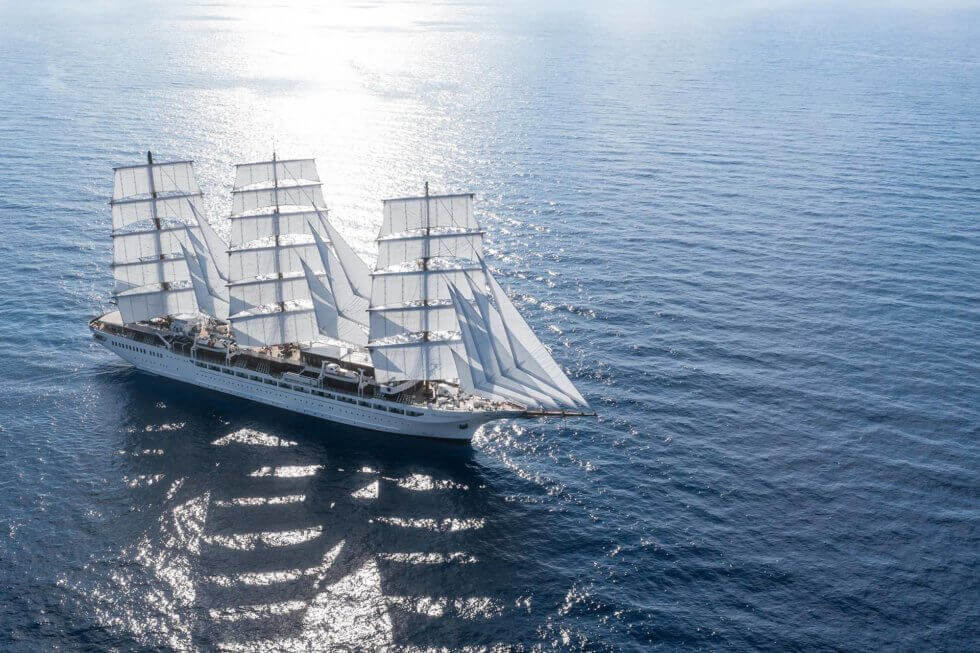
A windjammer that sets new standards among sailors
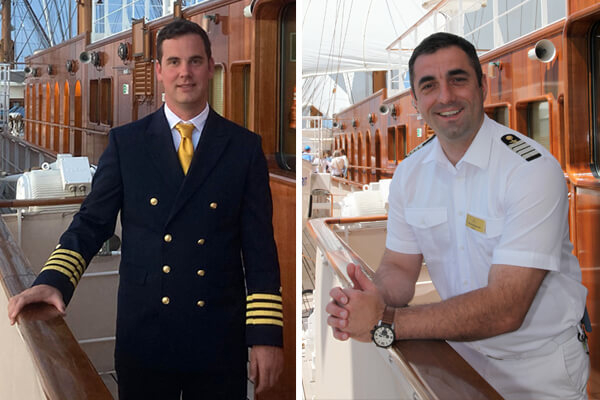
An entire deck with balcony cabins, an exclusive wellness and SPA area, a fitness room with sea view, a bistro on deck as an evening alternative to “fine dining” in the restaurant – the youngest member of the SEA CLOUD family offers plenty of room for individuality in addition to genuine windjammer romance.
Captain Heiner Eilers & Captain Vukota Stojanovic
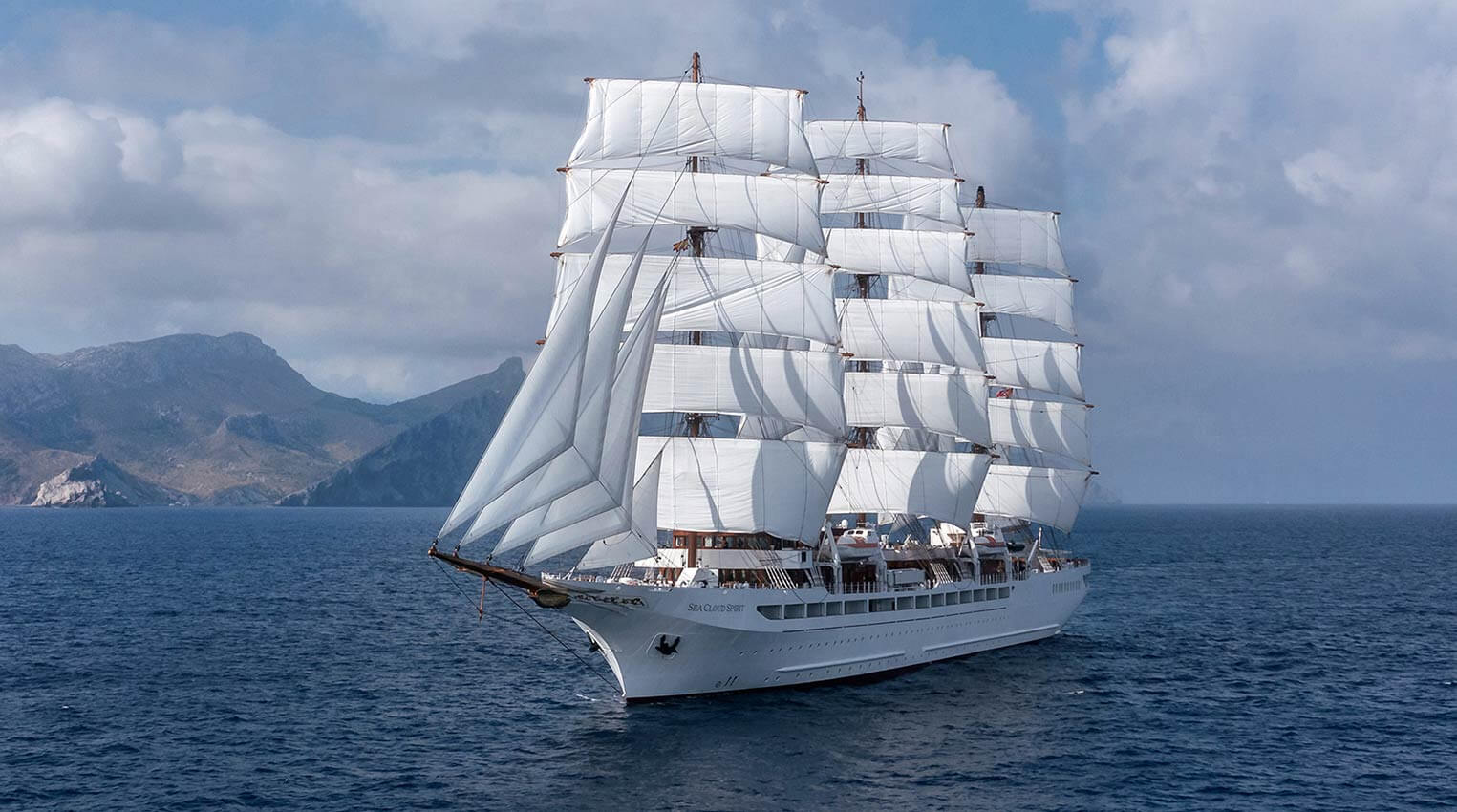
- Public Areas
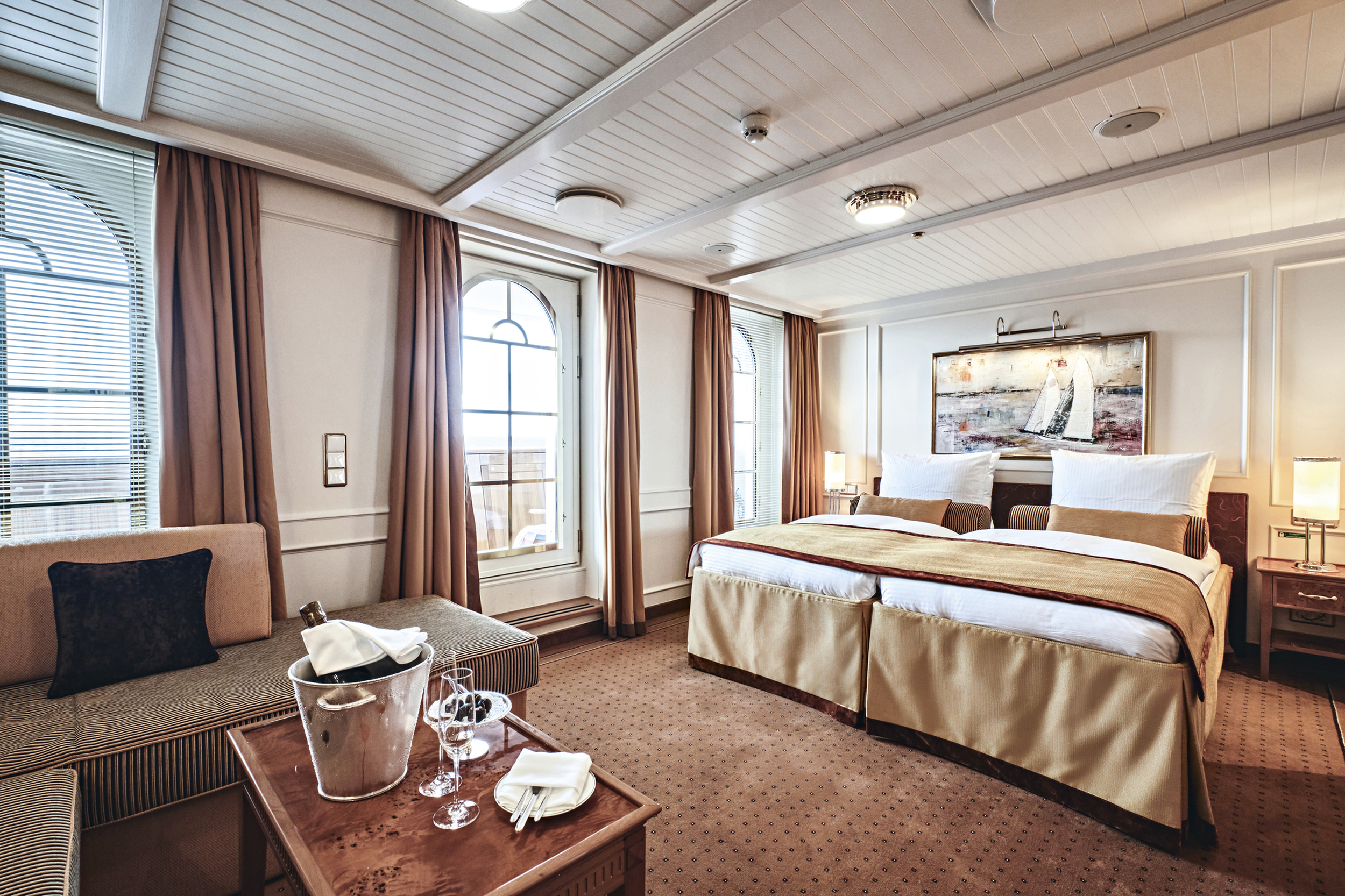
CAT. A Veranda Suites 316
The SEA CLOUD SPIRIT carries the spirit of our legendary flagship into a new era. One of the many places this is reflected is in the upscale ambience of the three suites on the veranda deck. The regal interior design combines with the spaciousness of the rooms to create sophisticated retreats. The feeling of being at the center of an endless ocean expanse is magnified by large windows framing the majestic views. Experiencing the sea is meant literally here — on the large balcony, sailing becomes a special pleasure.
- approx. 301 sq. ft.
- balcony approx. 86 sq. ft.
- marble bathroom with shower, bathtub, and golden fixtures
- California king bed, 71 in. x 83 in. (split king can be separated into 2 twins)
- walk-in closet
- L-shaped sofa with full-sized fold-out bed and table
- dressing table
- WiFi, TV, telephone
- minibar and coffee machine

CAT. A Veranda Suites 317
- approx. 280 sq. ft.
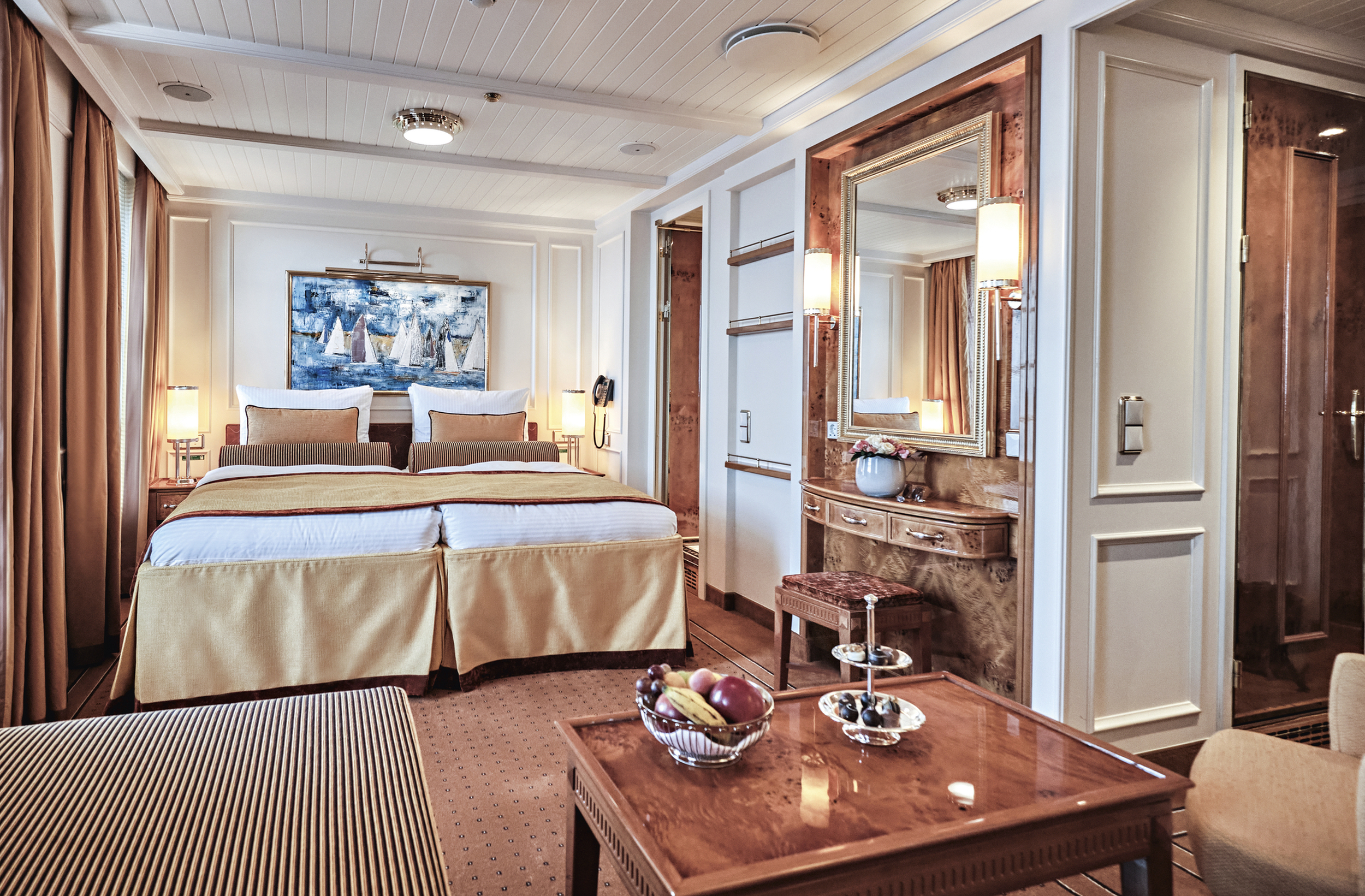
CAT. A Veranda Suites 318

Junior Veranda Suites category b
Our junior suites are also characterised by the elegant interpretation of the SEA CLOUD’s classic design and are designed with love for detail. Their generous character is further enhanced by the fact that they are flooded with light thanks to the panorama windows. Those who are still not satisfied with the view outside the window can enjoy the proximity of the sea from the spacious balcony. These cabins are a must for people who love the sea and above all fresh air. The simple elegance of the classic modern interior corresponds in gentle tension with the maritime atmosphere on board our new ship.
Junior-suite at a glance:
- 19-22 m² (205-237 sq. ft.)
- balcony 6 m² (65 sq. ft.)
- panorama window
- bathroom with bathtub
- double bed 180 cm x 200 cm (Split King) (two separate mattresses)
- walk-in wardrobe
- sitting area (sofa)
- coffee machine

Grand Staterooms category c
The large outside cabins of this category on the lidodeck combine the comfort and personal atmosphere of a five-star hotel room with the maritime, elegant cosiness that only the SEA CLOUD SPIRIT offers. The high panoramic windows can be opened – you can therefore immediately feel the special spirit of a sea voyage aboard the SEA CLOUD SPIRIT in your cabin. Of course, these panoramic windows also offer a wonderful view of the sea at any time of day.
Cabin at a glance:
- 15-18 m² (161-194 sq. ft.)
- panoramic window that opens
- bathroom with shower
- double bed consisting of two single beds 90 cm x 200 cm (Twin XL) each
- small sitting area (chair with table)

Deluxe Staterooms category d
The large portholes give our deluxe staterooms on the cabin deck a special maritime flair. Together with their elegant yacht ambience, these living spaces emphasise the certainty of being on an extraordinary journey with an extraordinary ship. Precious materials and the stylish design give the spacious cabins a cosy atmosphere. And of course this cabin category is also characterised by the combination of the long SEA CLOUD tradition with the modern interpretation of classic elegance.
- 17-21 m² (183-226 sq. ft.)
- min. two large portholes
- small sitting area with table

Superior Staterooms category e
These outside cabins on both sides of the cabin deck are the epitome of cosiness on board the SEA CLOUD SPIRIT. This is where you can retreat, switch off and relax while enjoying the unique luxurious ambience for which our private yachts are famous. Here too, tradition and the future of travel on board a modern tall ship meets in the elegant interior.
- 16-19 m² (172-205 sq. ft.)

Superior Single Staterooms category f
The two cabins in this category are the ideal home for single travellers who want to enjoy the special comfort of the SEA CLOUD SPIRIT. In a slightly smaller space, they offer the same luxury and comfort as the other double cabins on the cabin deck.
- 13 m² (140 sq. ft.)
- integrated single bed (length 287 cm (113 in.), width head end 105 cm (41 in.), width foot end 175 cm (69 in.))
- small sitting area

Guaranteed double cabins (limited allotment; upon request)
Our guaranteed cabins allow you to book our voyages at a lower rate. A specific cabin number or category cannot be selected. You will receive your exact cabin number when arriving on board. On the SEA CLOUD SPIRIT, the range of accommodation starts from Cat. E. The allotment for this category is very limited.

CAT. B Junior Veranda Suites 306
The junior veranda suites are also characterized by the elegant interpretation of the SEA CLOUD’s classic design and furnished with attention to detail. Rays of natural light from twin arched windows fill the space with a cheery, airy ambiance. And a private balcony lets guests get closer to the ocean and feel the sea breezes. With a bright, bold palette, lustrous woods and golden trims, these junior veranda suites epitomize the modern luxury of our newest sailing yacht.
- approx. 215 sq. ft.
- balcony approx. 65 sq. ft.
- California king bed, 71 in. x 79 in. (2 mattresses)
- sofa and chair with table
- WIFI, TV, telephone

CAT. B Junior Veranda Suites 307

CAT. B Junior Veranda Suites 308
- approx. 205 sq. ft.
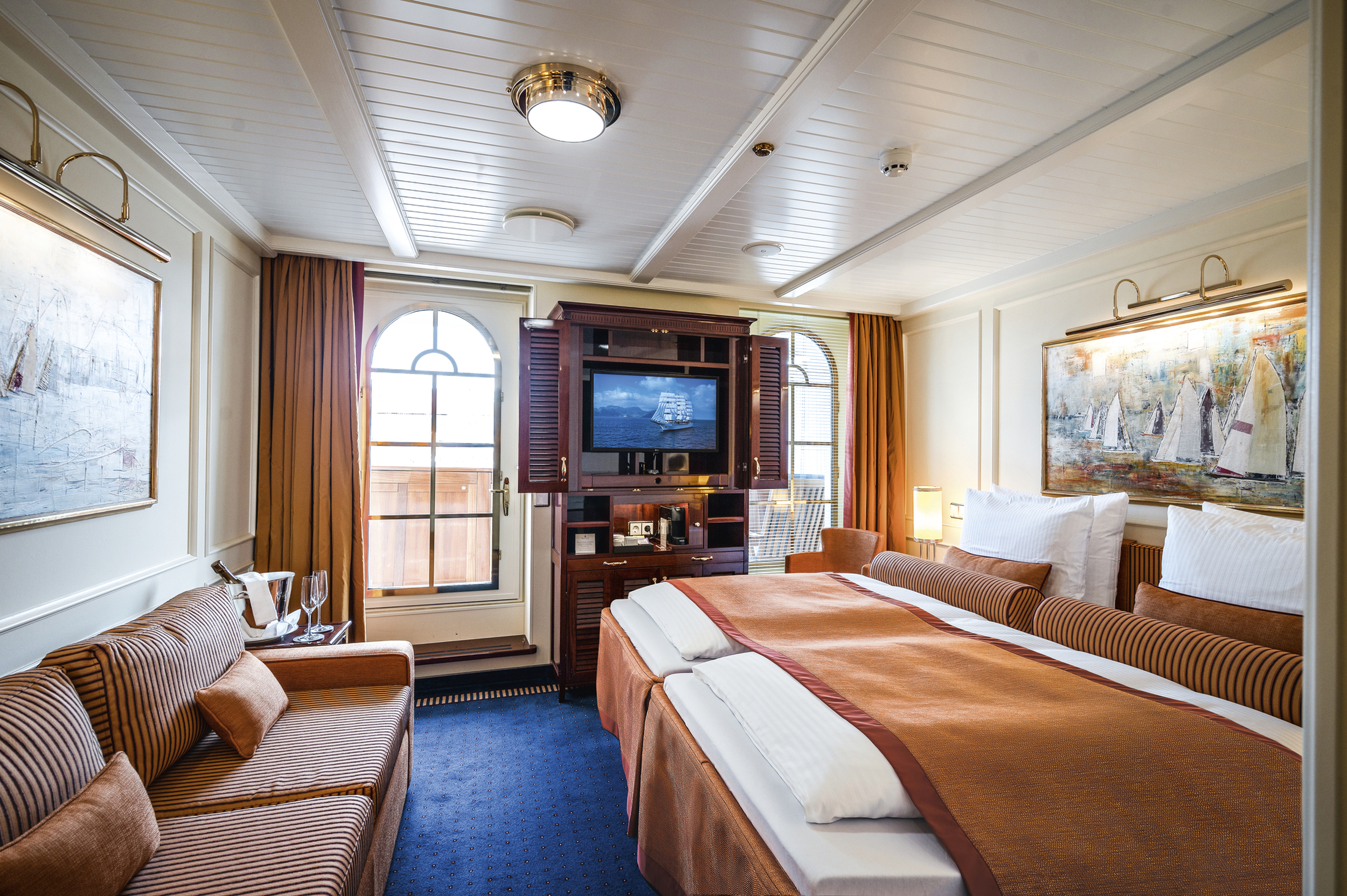
CAT. B Junior Veranda Suites 309
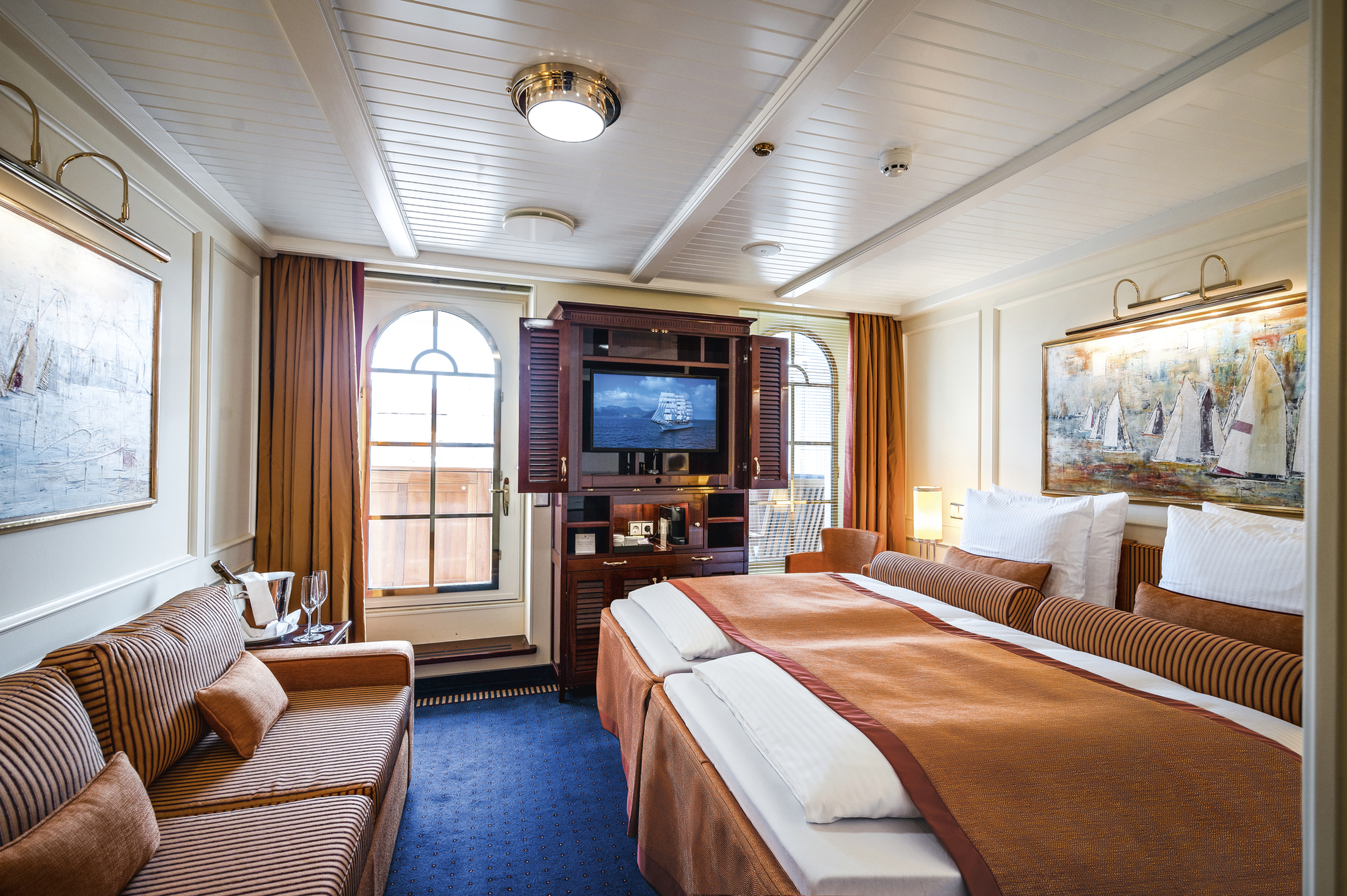
CAT. B Junior Veranda Suites 310
Cat. b junior veranda suites 311, cat. b junior veranda suites 314.

CAT. B Junior Veranda Suites 315
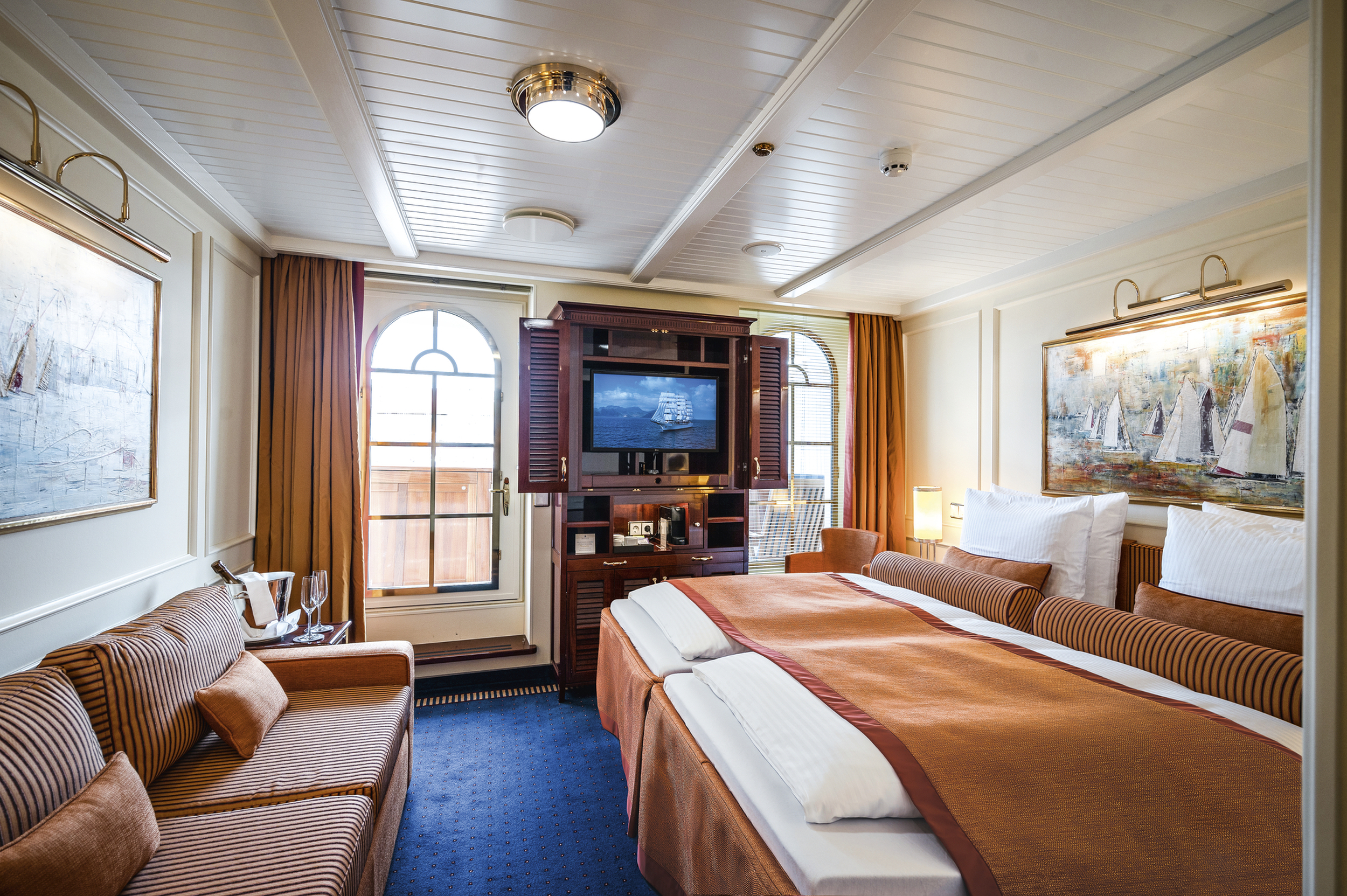
CAT. B Junior Veranda Suites 323
- approx. 226 sq. ft.

CAT. B Junior Veranda Suites 325
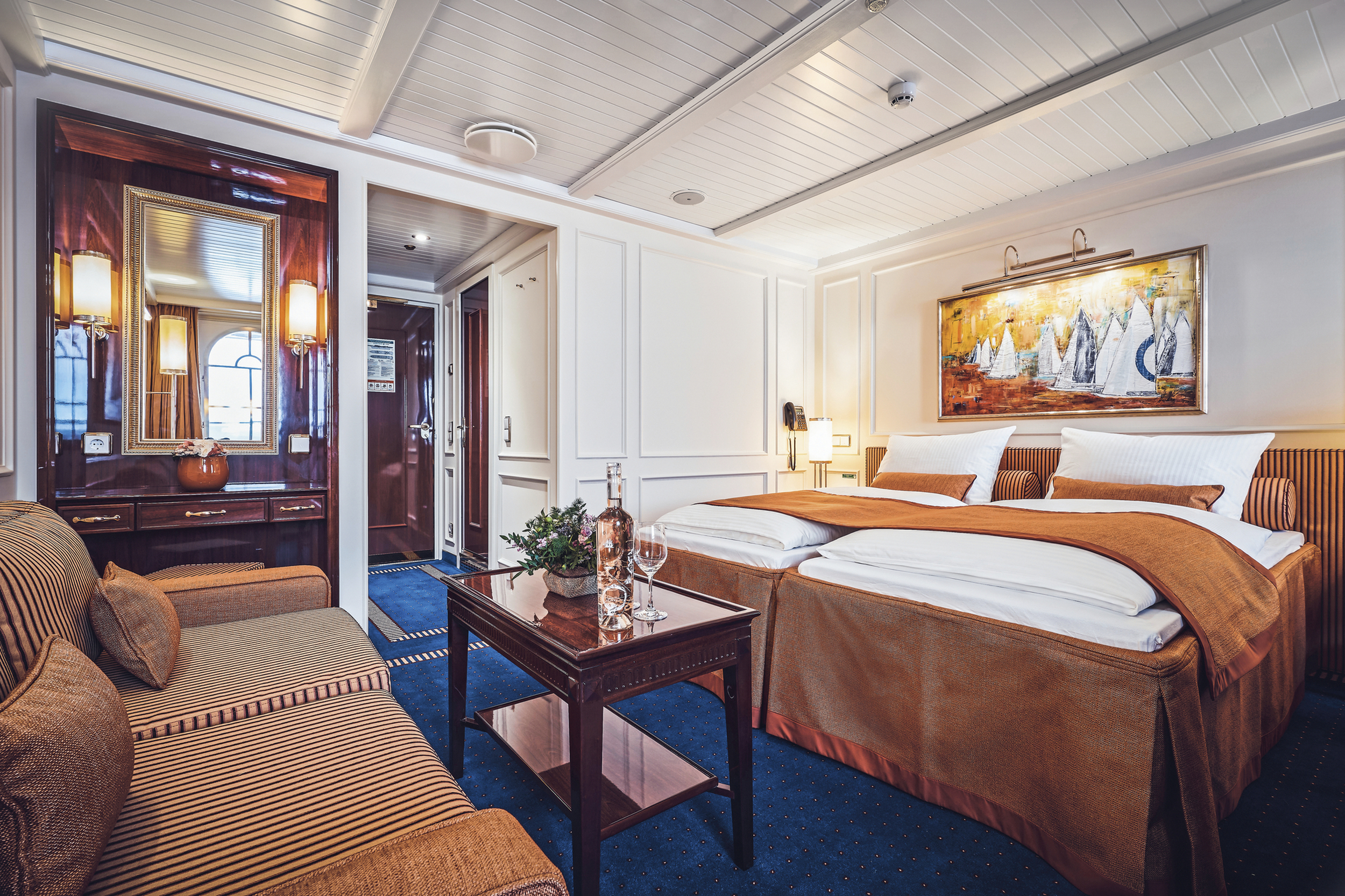
CAT. B Junior Veranda Suites 320
- approx. 237 sq. ft.

CAT. B Junior Veranda Suites 321
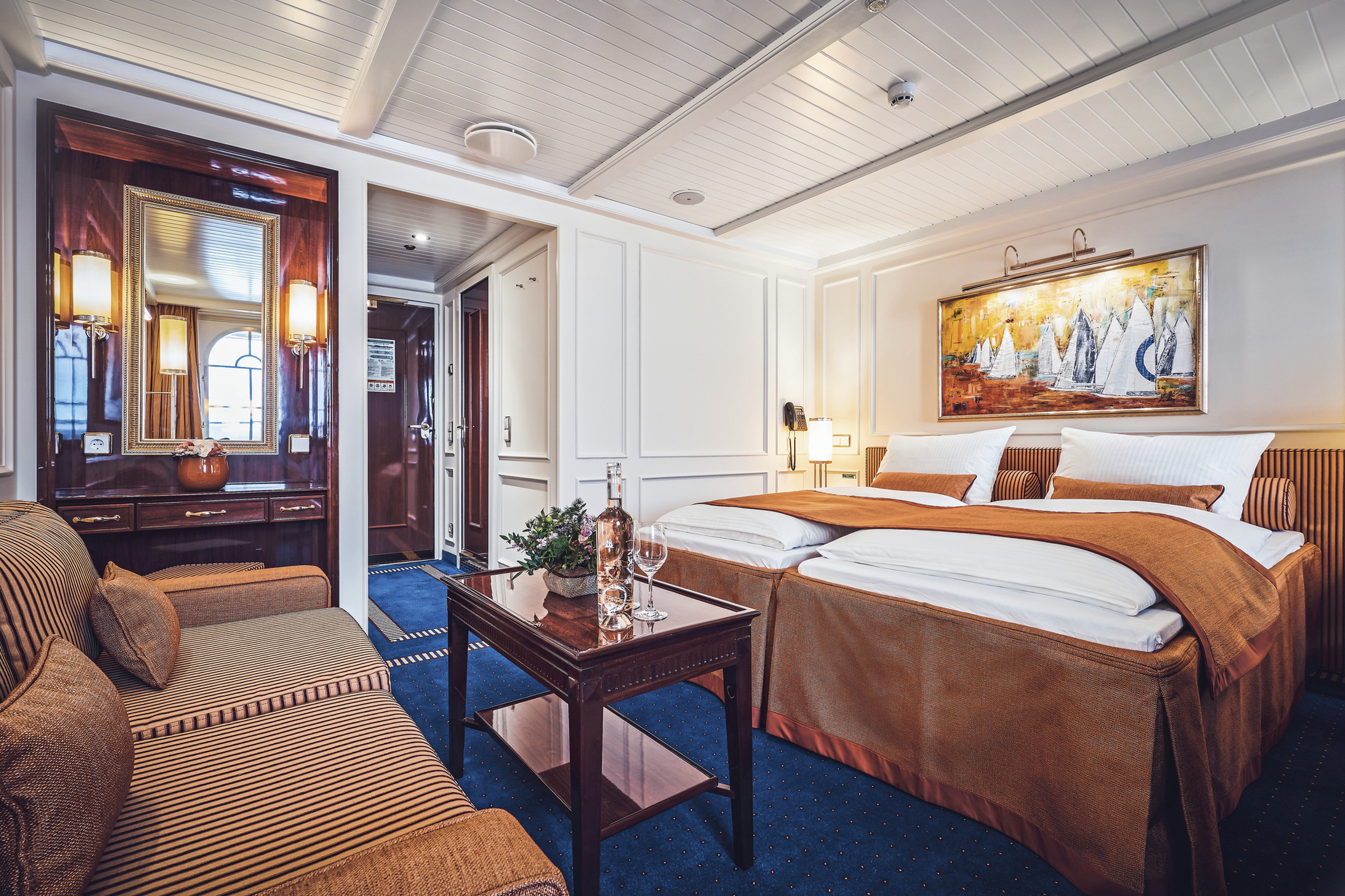
CAT. B Junior Veranda Suites 322

CAT. B Junior Veranda Suites 324
Cat. b junior veranda suites 326, cat. b junior veranda suites 327, cat. b junior veranda suites 329, cat. b junior veranda suites 328.
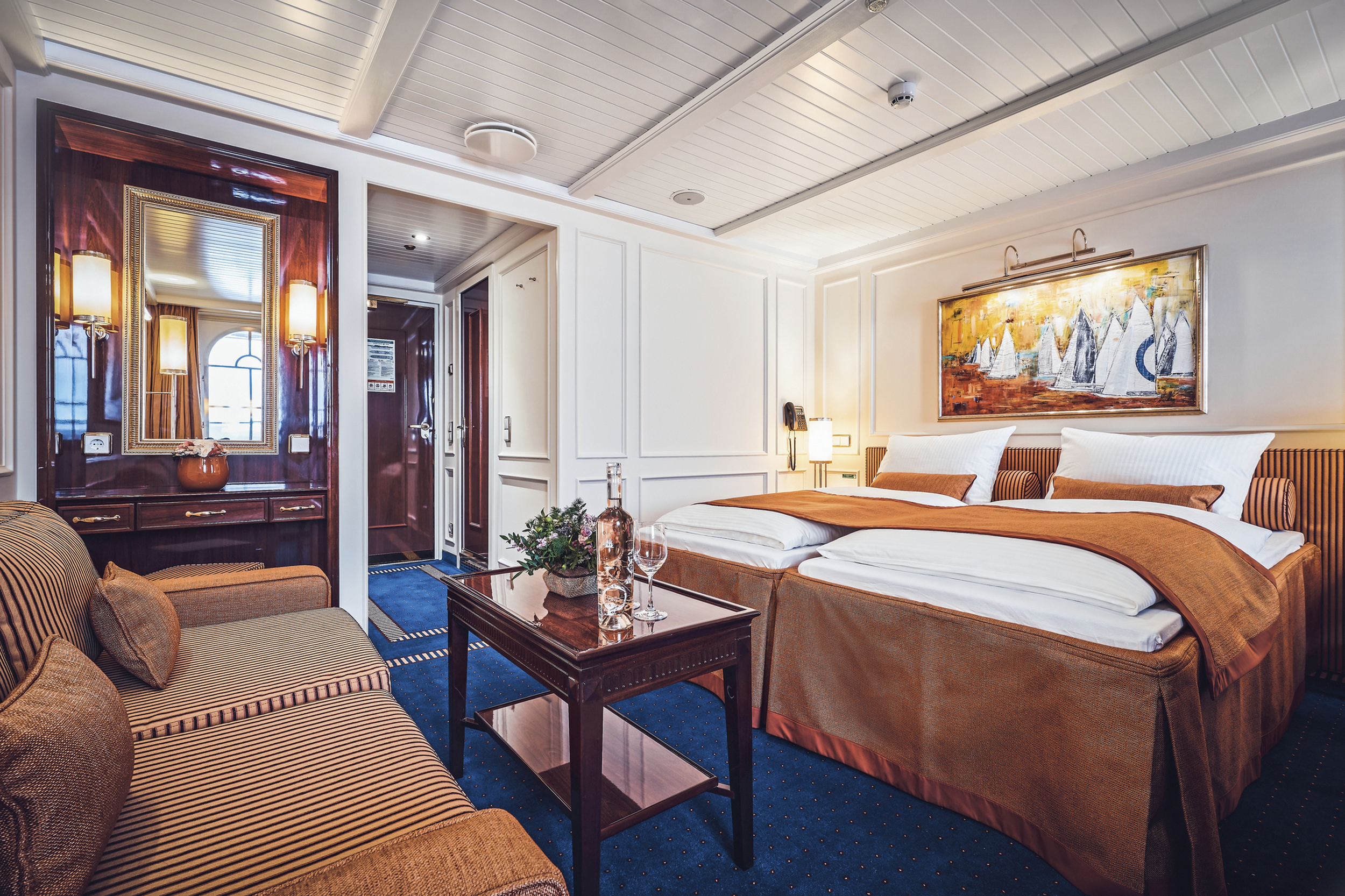
CAT. B Junior Veranda Suites 330

CAT. B Junior Veranda Suites 331

CAT. B Junior Veranda Suites 332
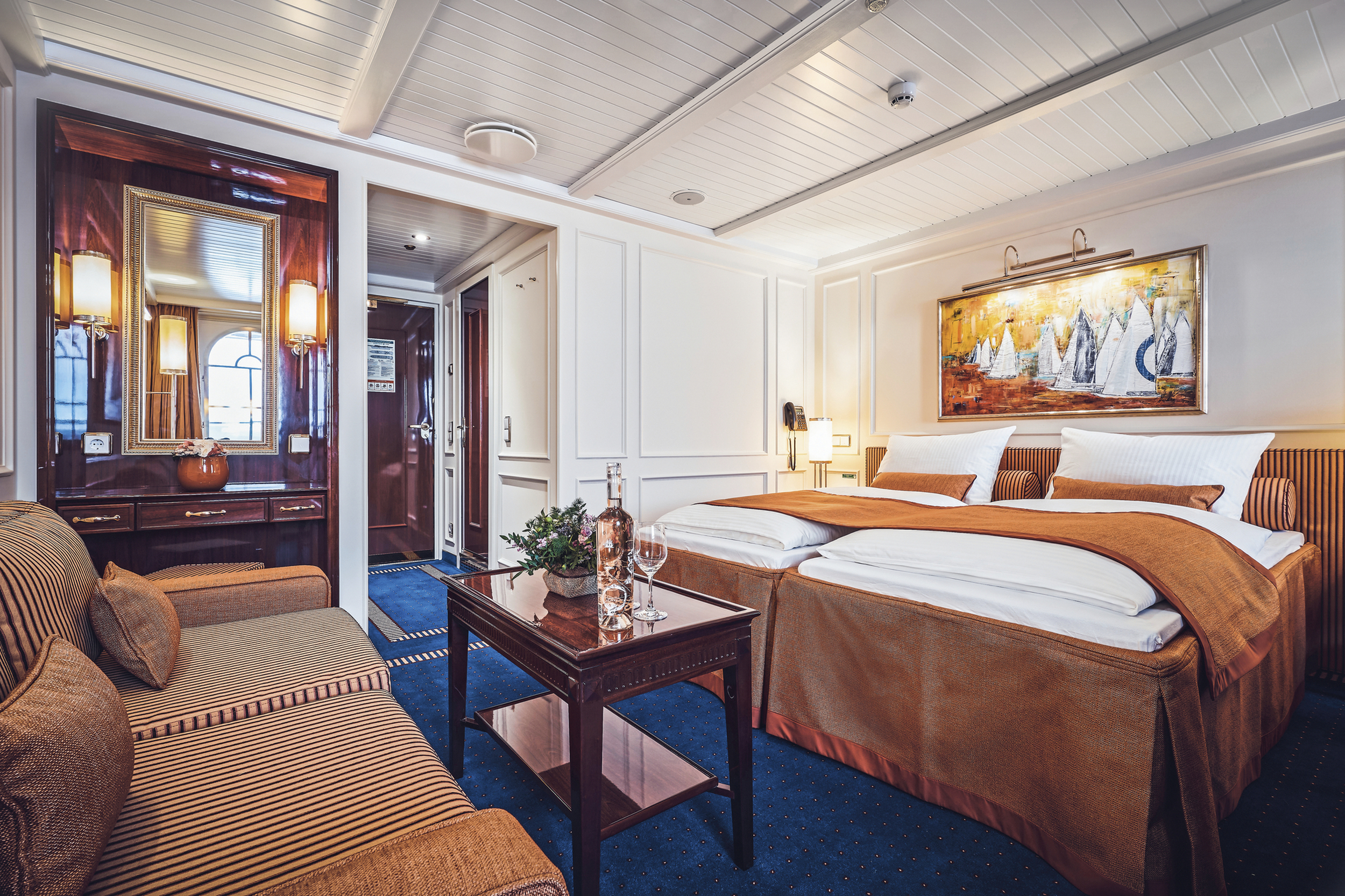
CAT. B Junior Veranda Suites 333
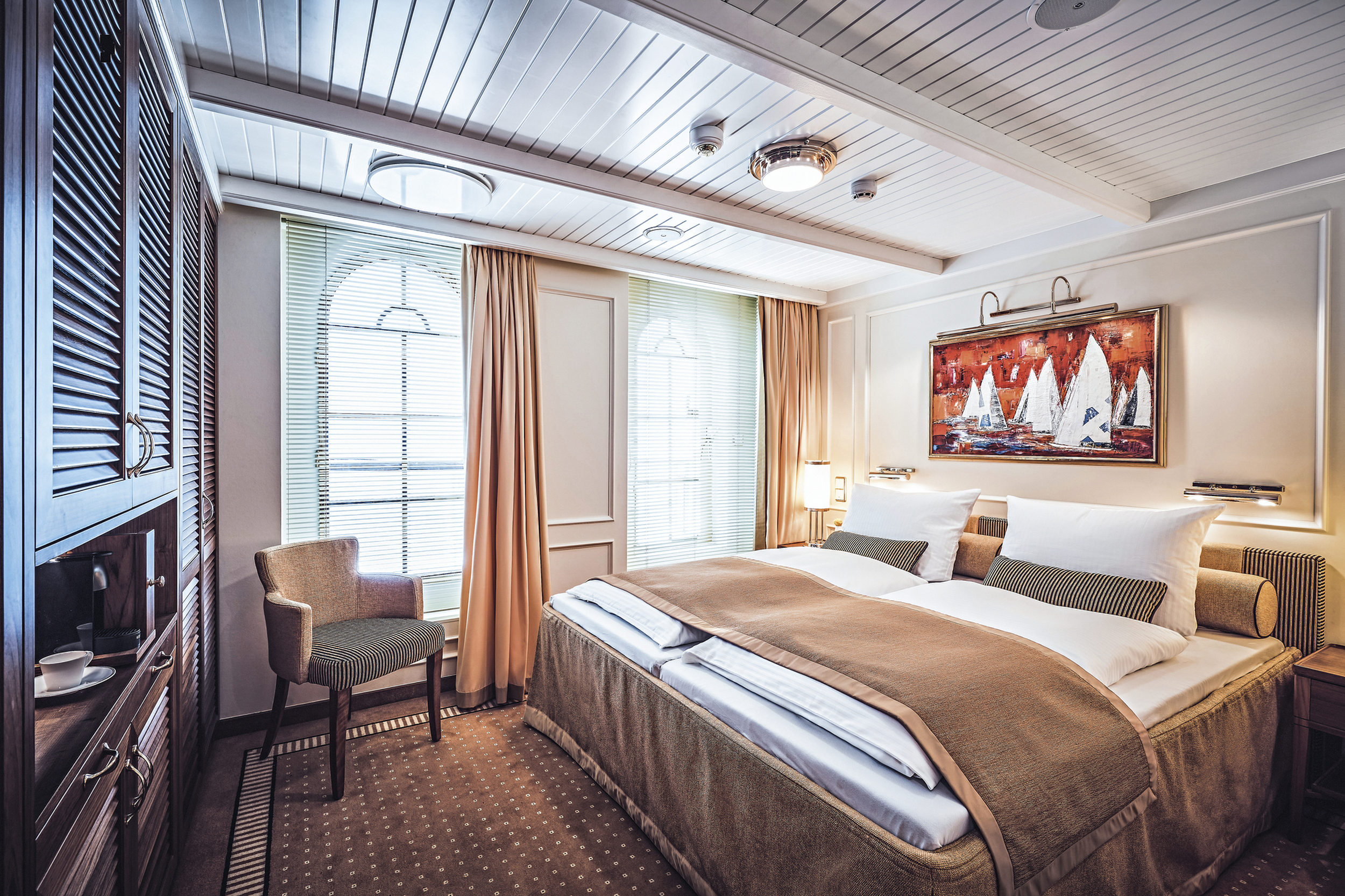
CAT. C Grand Staterooms 401
The grand staterooms on the lido deck combine the modern luxuries of a five-star hotel room with the private yacht ambiance that only the SEA CLOUD SPIRIT can offer. Elegant arched windows open to fill the space with sea breezes and a feeling of adventure. A sunny palette and golden accents create a warm glow setting the tone for a sophisticated sanctuary at sea.
- approx. 161 sq. ft.
- opening windows
- marble bathroom with shower and golden fixtures
- double bed consisting of 2 singles, 35 in. x 79 in.
- chair with table

CAT. C Grand Staterooms 402
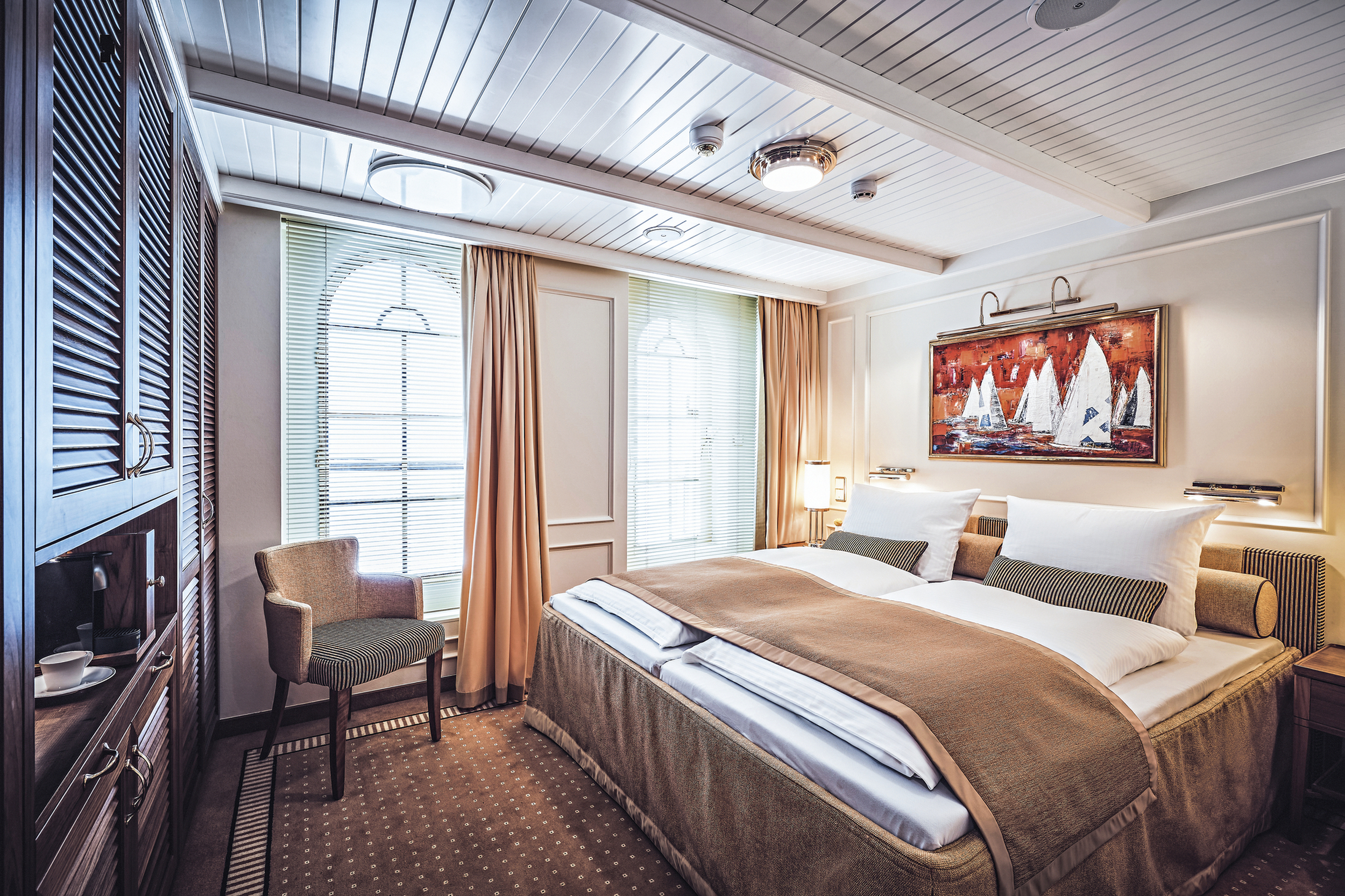
CAT. C Grand Staterooms 403
- approx. 172 sq. ft.
CAT. C Grand Staterooms 404
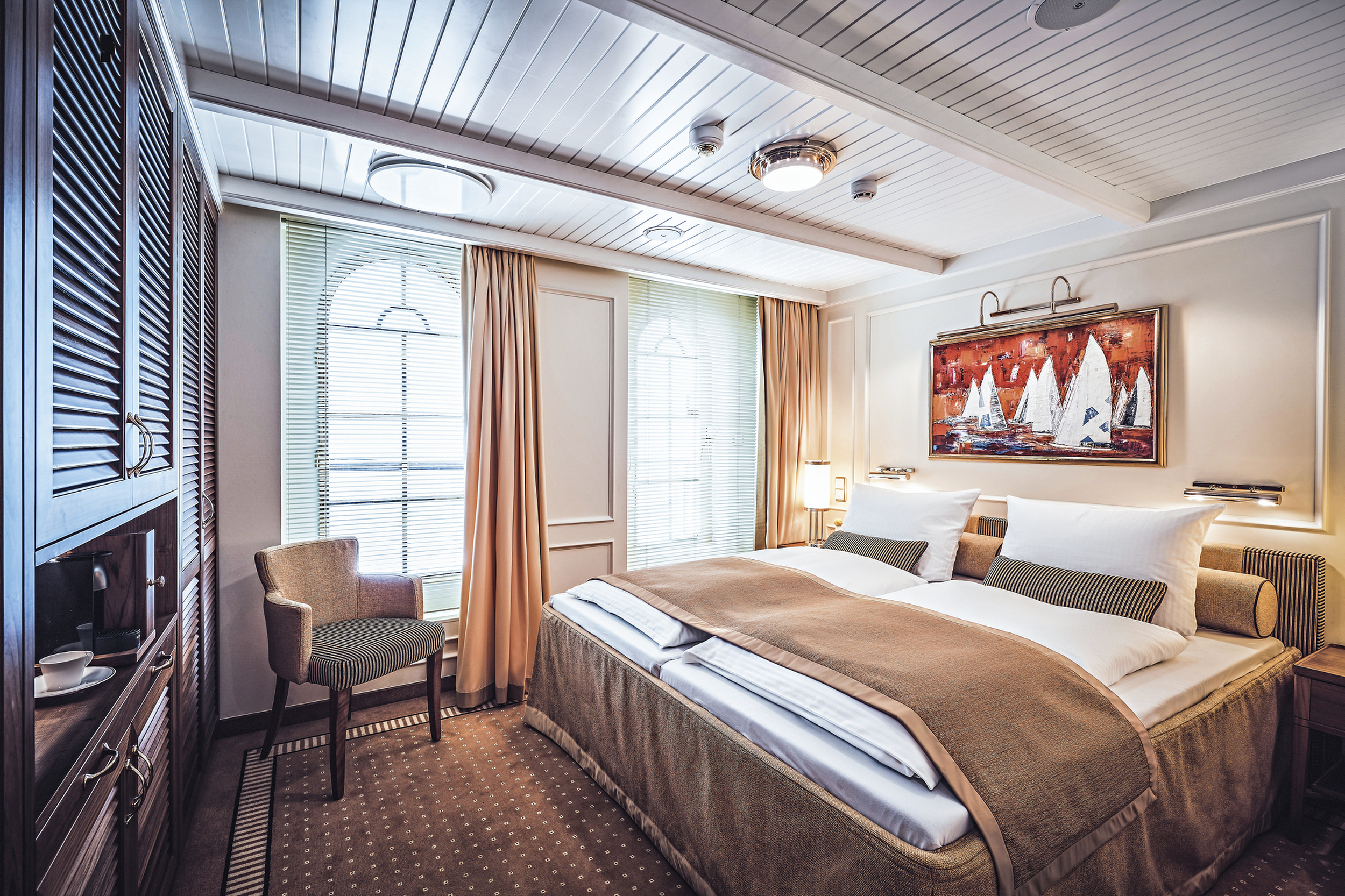
CAT. C Grand Staterooms 405

CAT. C Grand Staterooms 406
- approx. 194 sq. ft.
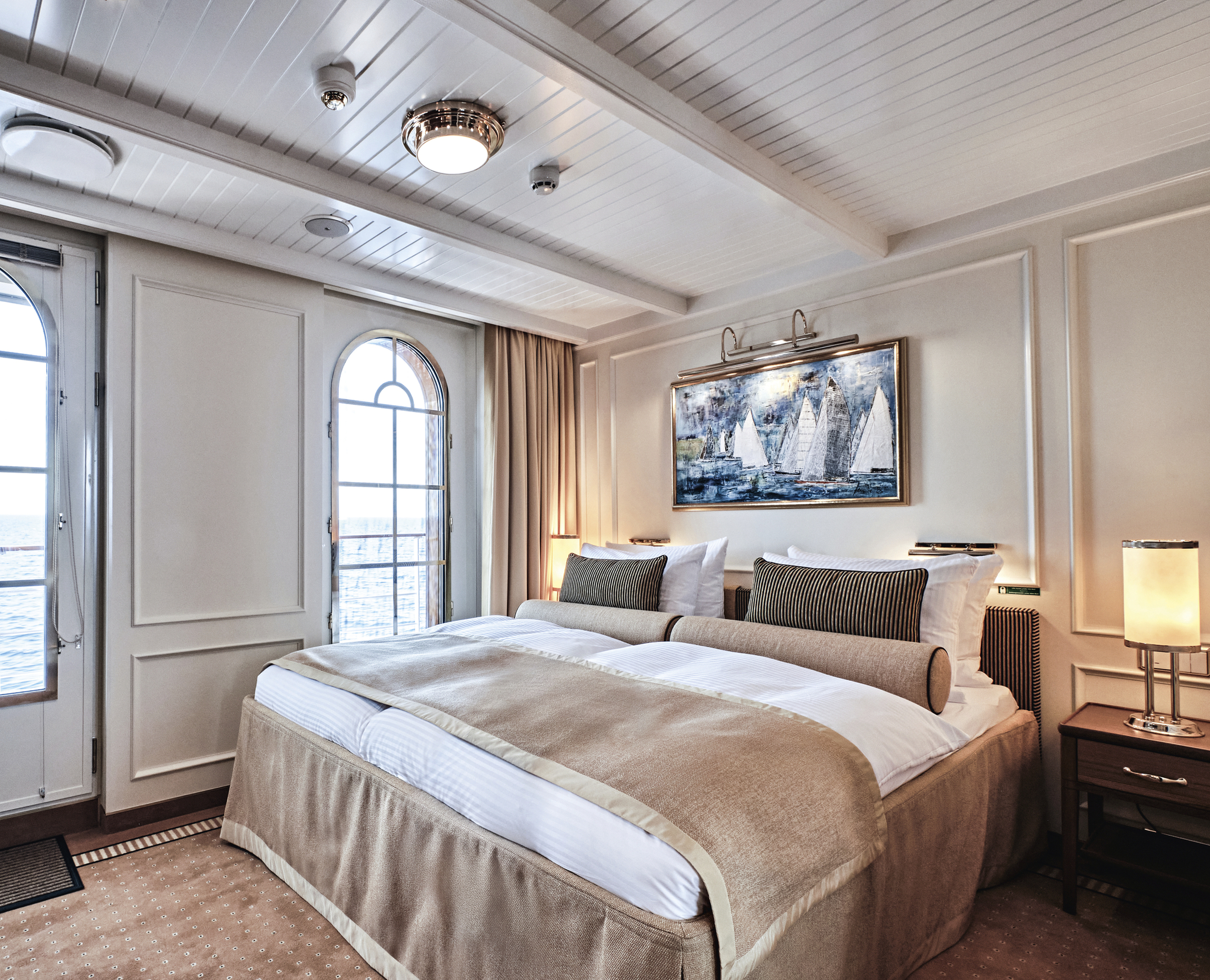
CAT. C Grand Staterooms 408
The grand staterooms on the lido deck combine the modern luxuries of a five-star hotel room with the private yacht ambiance that only the SEA CLOUD SPIRIT can offer. The elegant arched window lets in plenty of light and provides a wonderful view of the ocean at any time of day. Additionally, this stateroom features a panoramic door to the deck, which also provides access to the cabin.
- panoramic window (cannot be opened; access to the stateroom through panoramic door)

CAT. F Superior Single Staterooms 204
The two superior single staterooms charm single travelers who want to enjoy the luxury comforts of the SEA CLOUD SPIRIT. In slightly smaller spaces, they offer the same upscale design and decor as the deluxe staterooms on the stern side of the deck, complete with nautical portholes. And restful nights are guaranteed in the unique built-in bed, with a width of 43 or 47 inches at the head, 63 or 69 inches at the foot and a length of 87 or 91 inches.
- approx. 140 sq. ft.
- built-in single bed
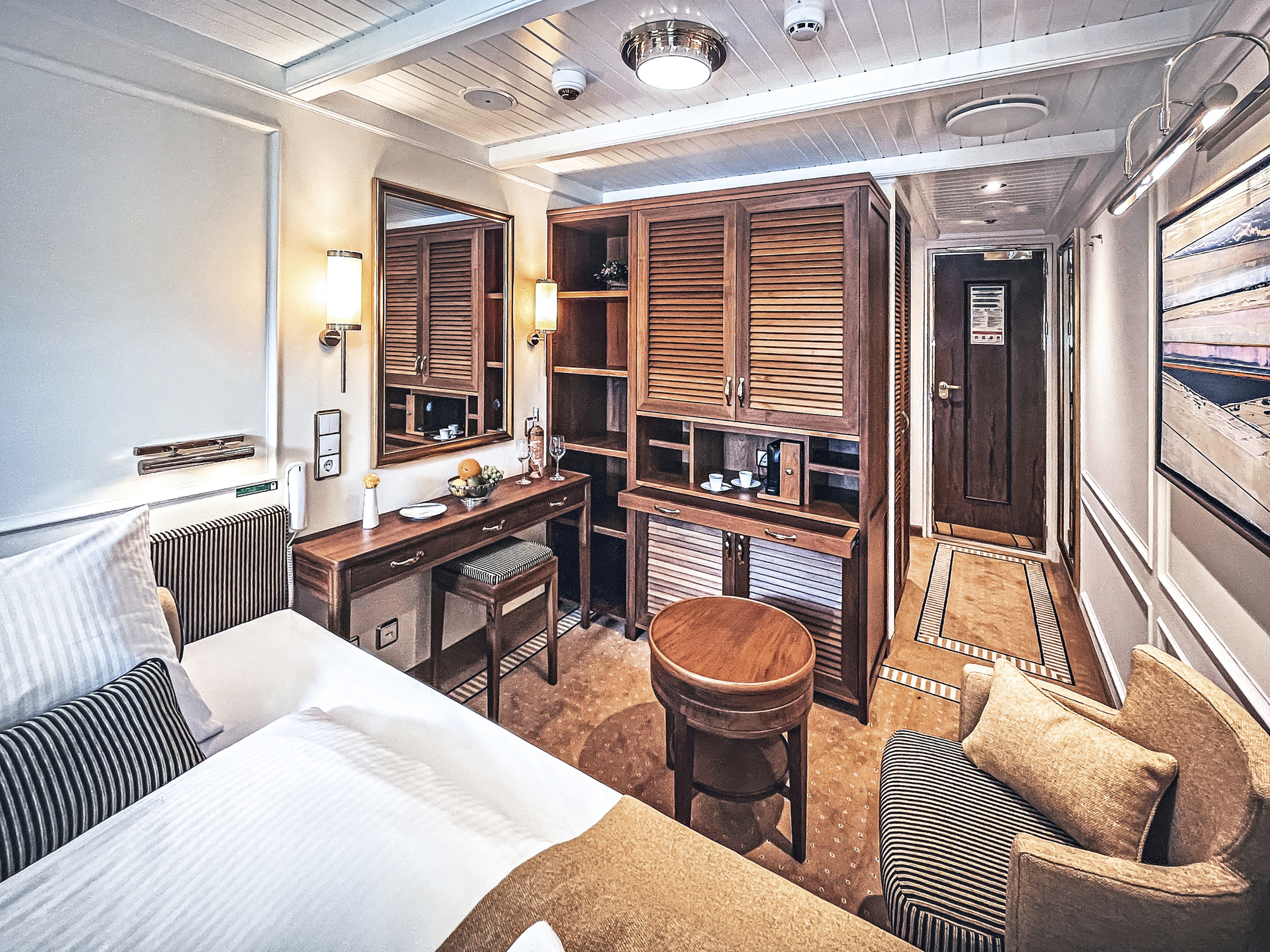
CAT. F Superior Single Staterooms 205

CAT. E Superior Staterooms 206
These outside superior staterooms with large porthole windows are the epitome of nautical luxury on SEA CLOUD SPIRIT. These are exclusive retreats of serenity that have made our sailing yachts famous. Sophisticated style comes in the form of rich wood finishings, Italian marble and golden fixtures.
- California king bed, 71 in.x 79 in. (2 mattresses)
- seating with table
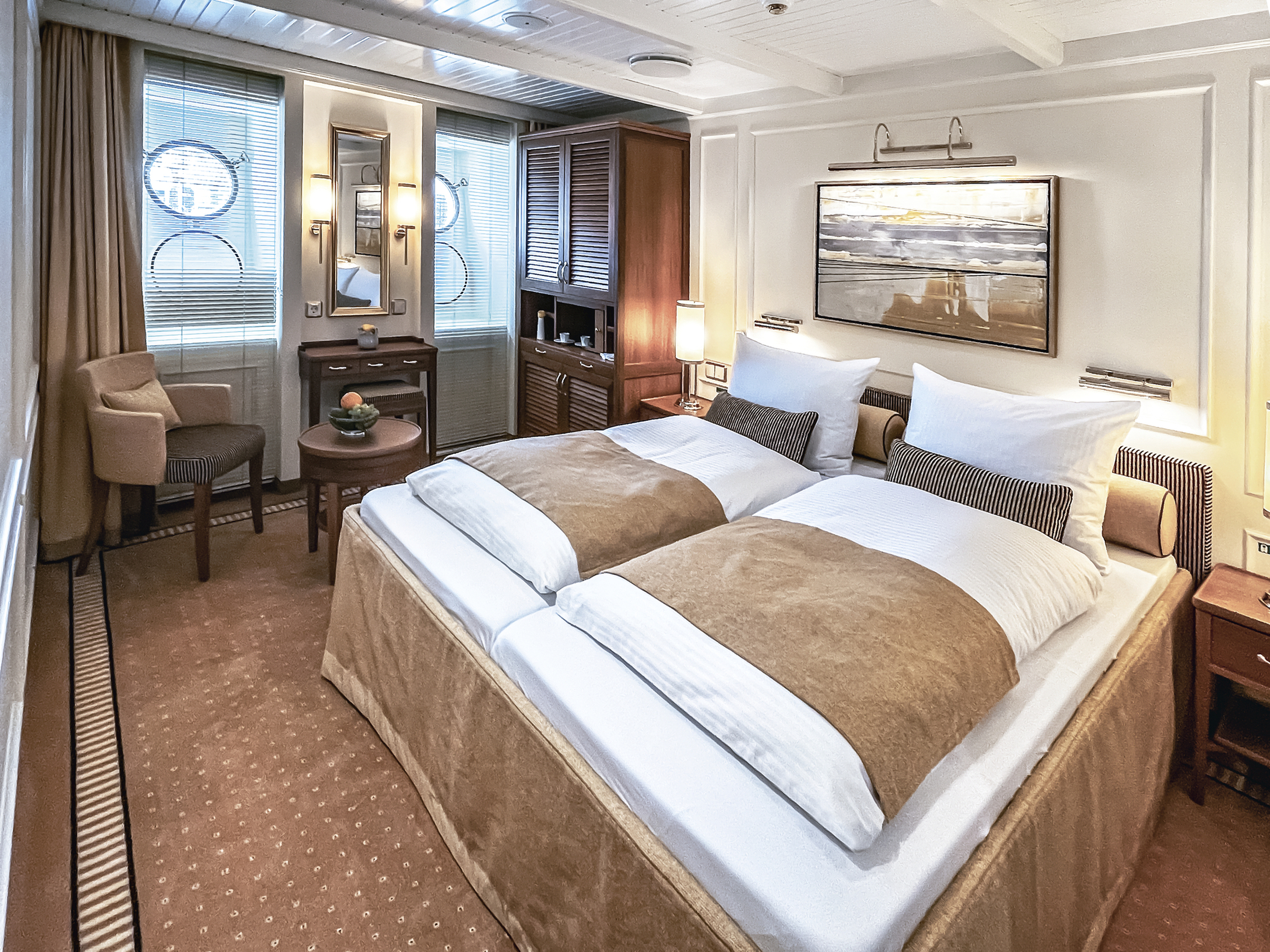
CAT. E Superior Staterooms 207
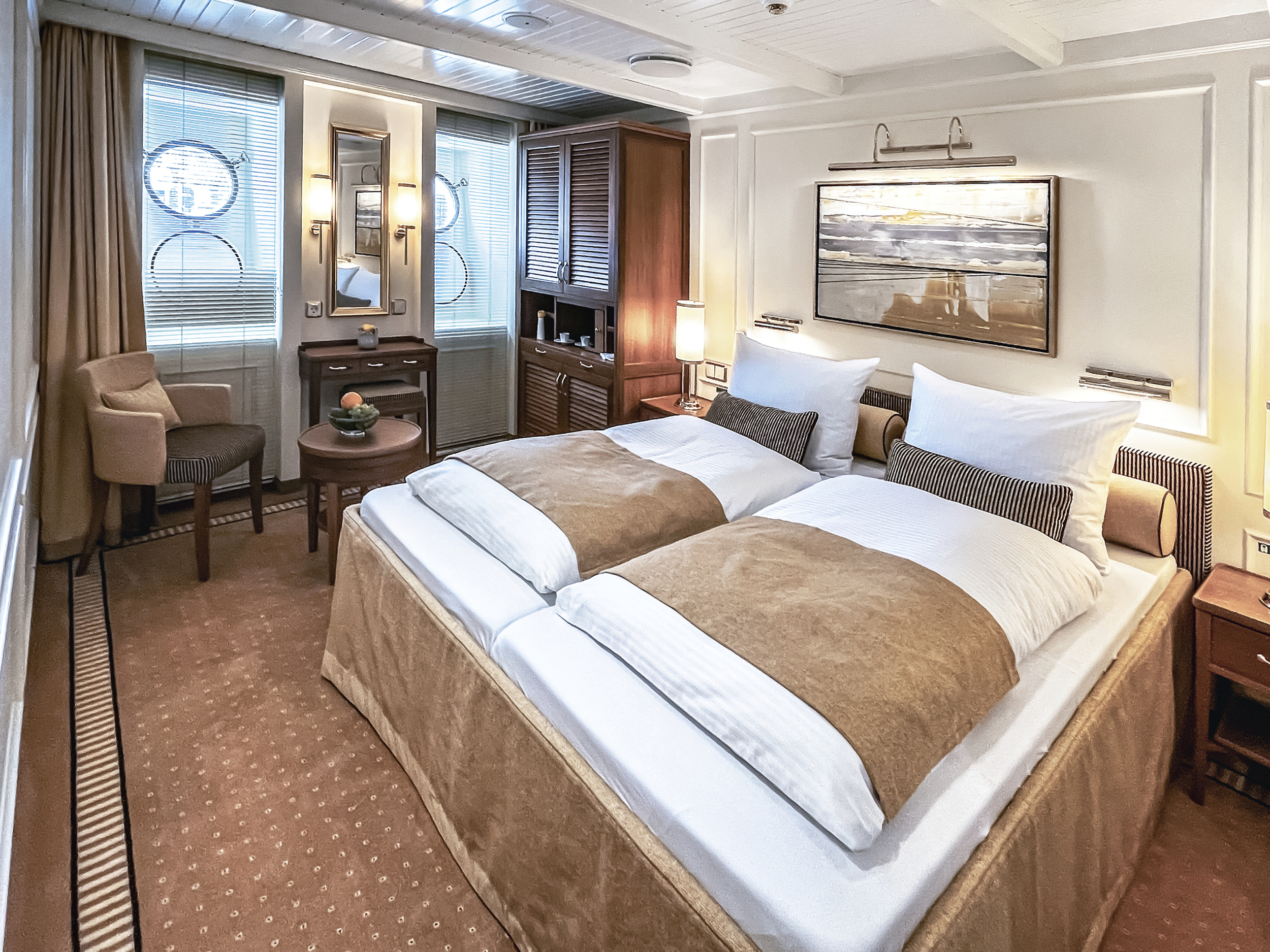
CAT. E Superior Staterooms 210
Cat. e superior staterooms 211.
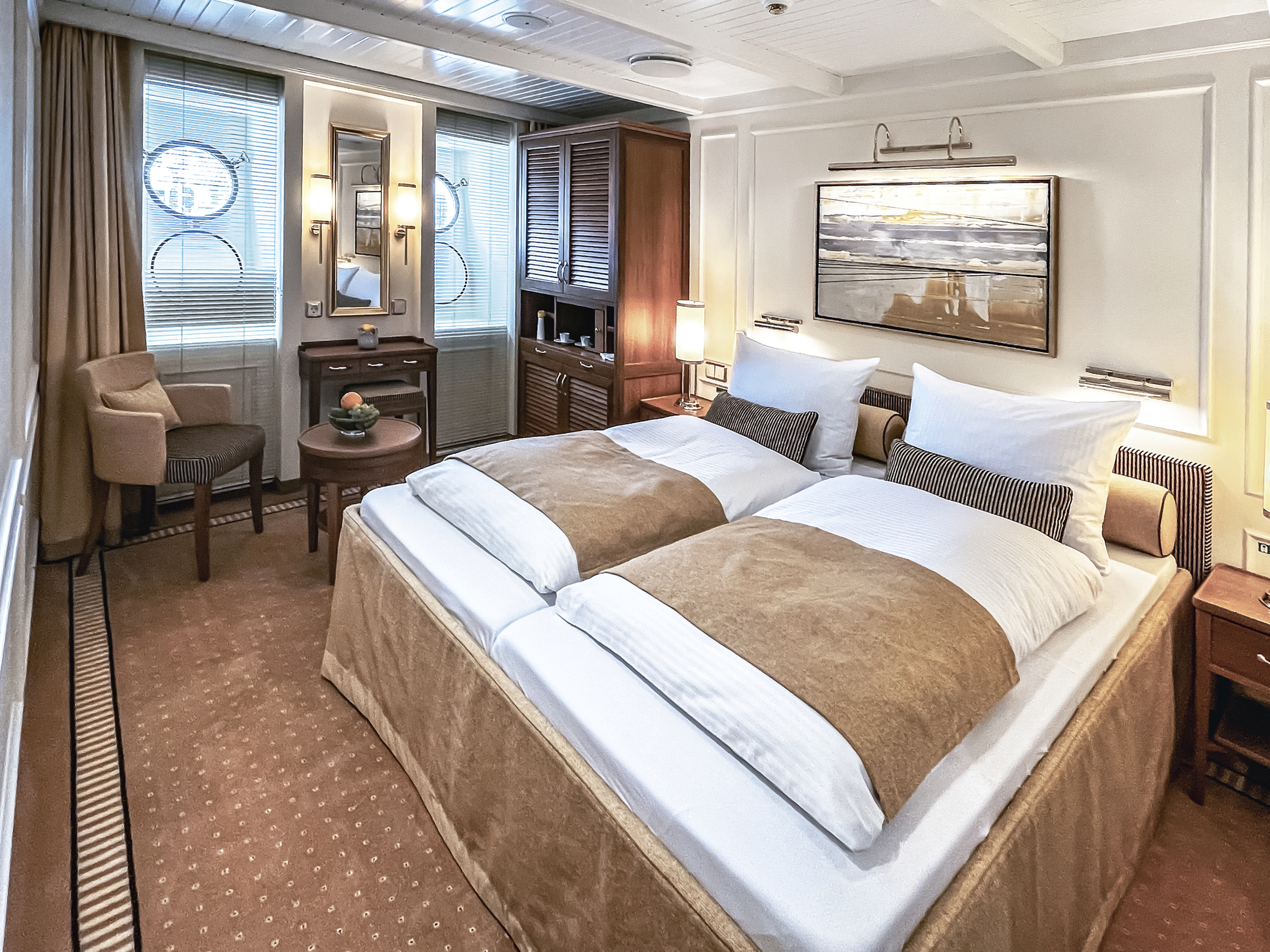
CAT. E Superior Staterooms 208
Cat. e superior staterooms 209.

CAT. E Superior Staterooms 216
- approx. 183 sq. ft.
CAT. E Superior Staterooms 218
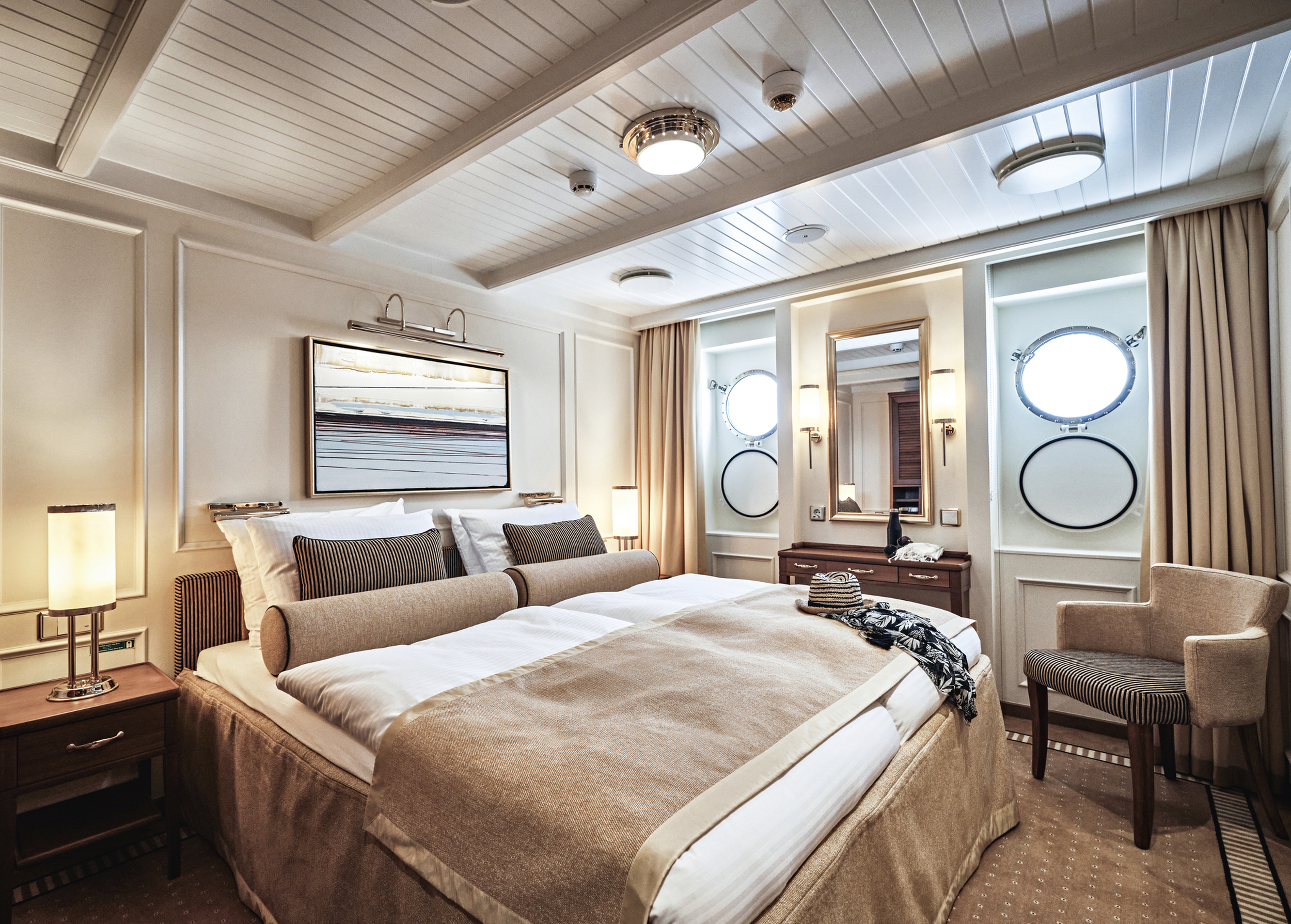
CAT. E Superior Staterooms 223
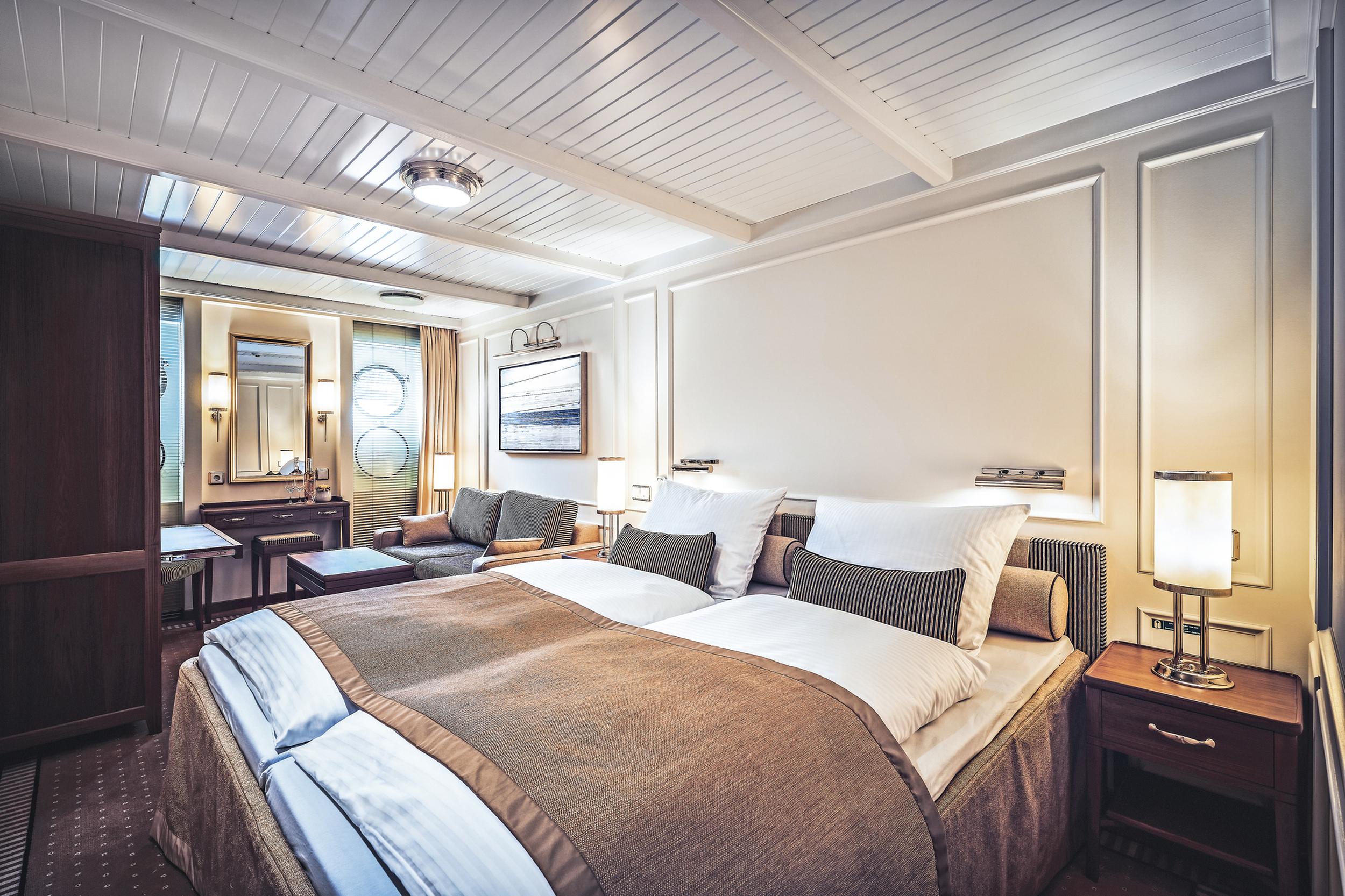
CAT. D Deluxe Staterooms 212
Large porthole windows give these SEA CLOUD II deluxe staterooms a special maritime flair. With a luxurious yacht ambience, these upscale spaces magnify the feeling of being part of an extraordinary journey on an extraordinary ship. The spacious room exudes elevated coziness with sophisticated furnishing and finishings, a glamorous palette and charming sitting area.
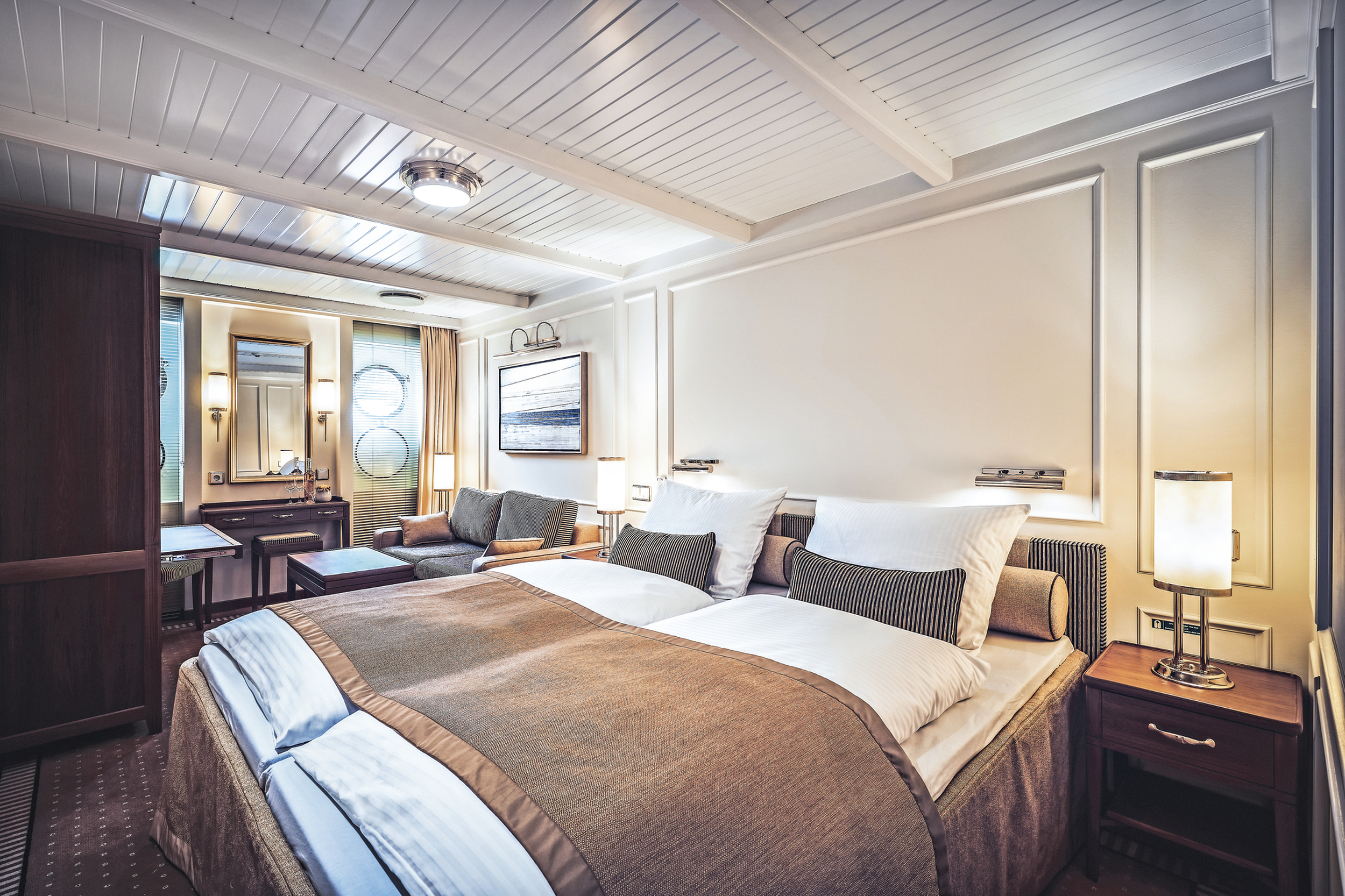
CAT. D Deluxe Staterooms 215

CAT. D Deluxe Staterooms 225
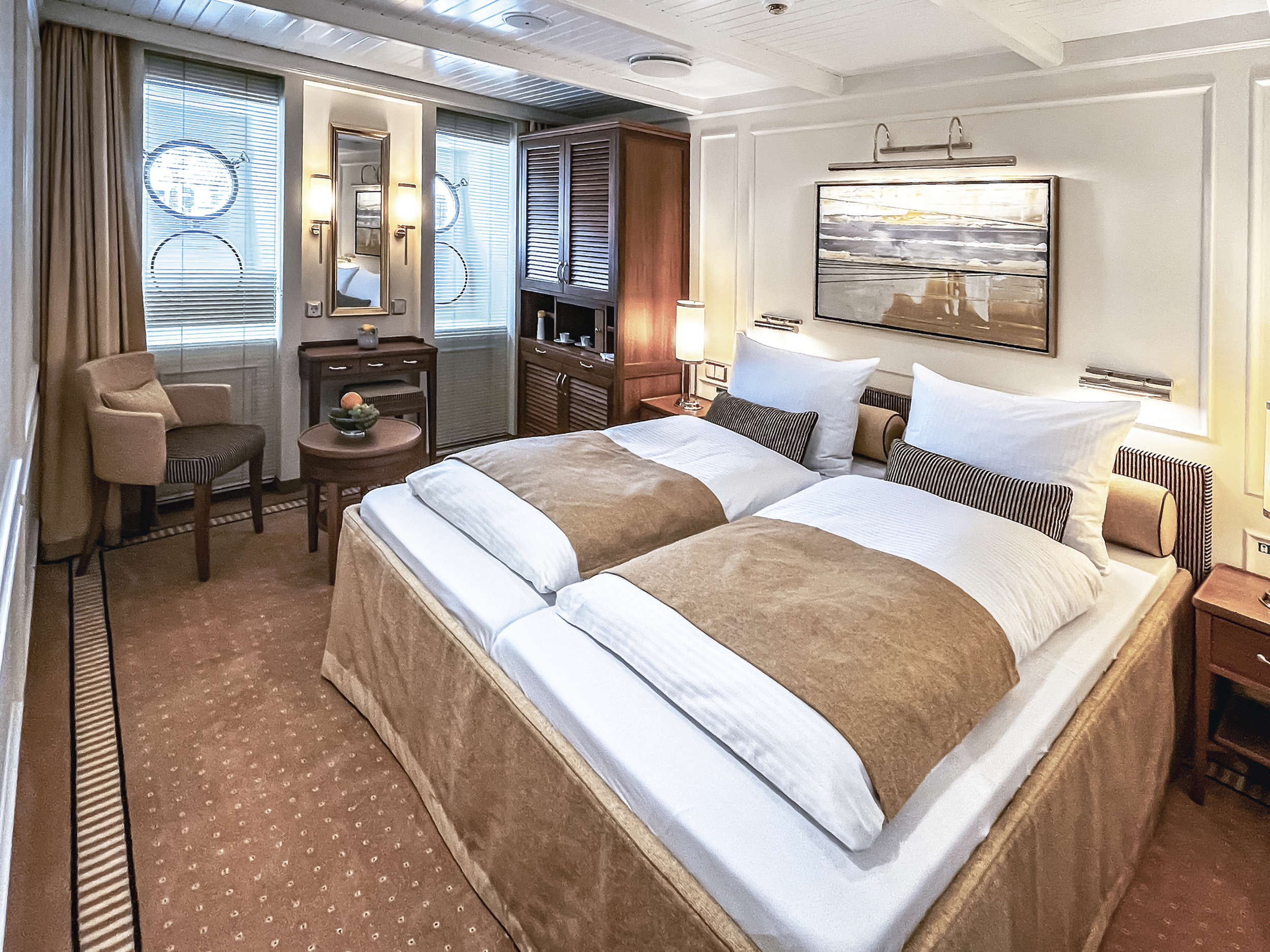
CAT. D Deluxe Staterooms 227

CAT. D Deluxe Staterooms 229
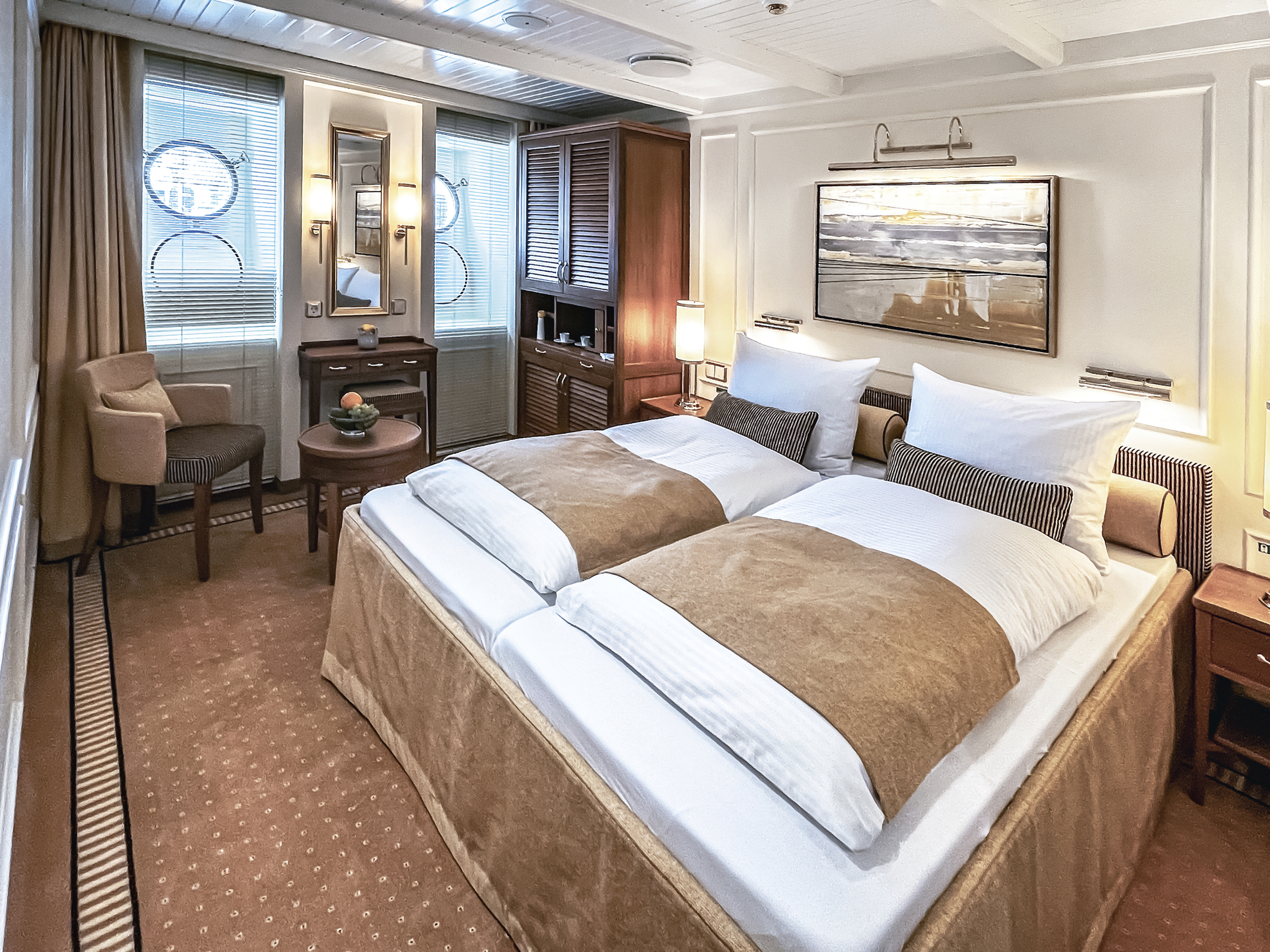
CAT. D Deluxe Staterooms 214
Cat. d deluxe staterooms 217.
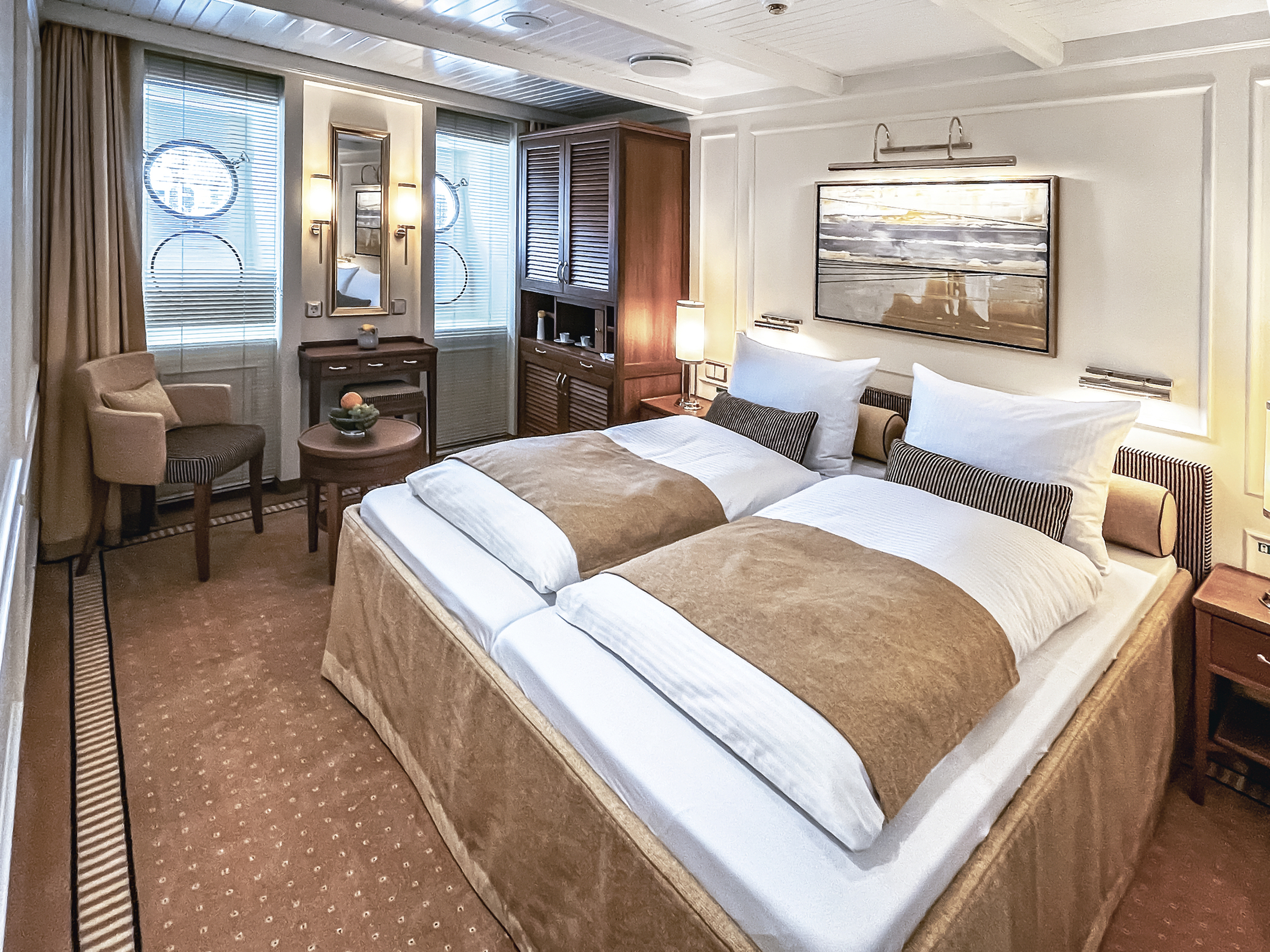
CAT. D Deluxe Staterooms 220
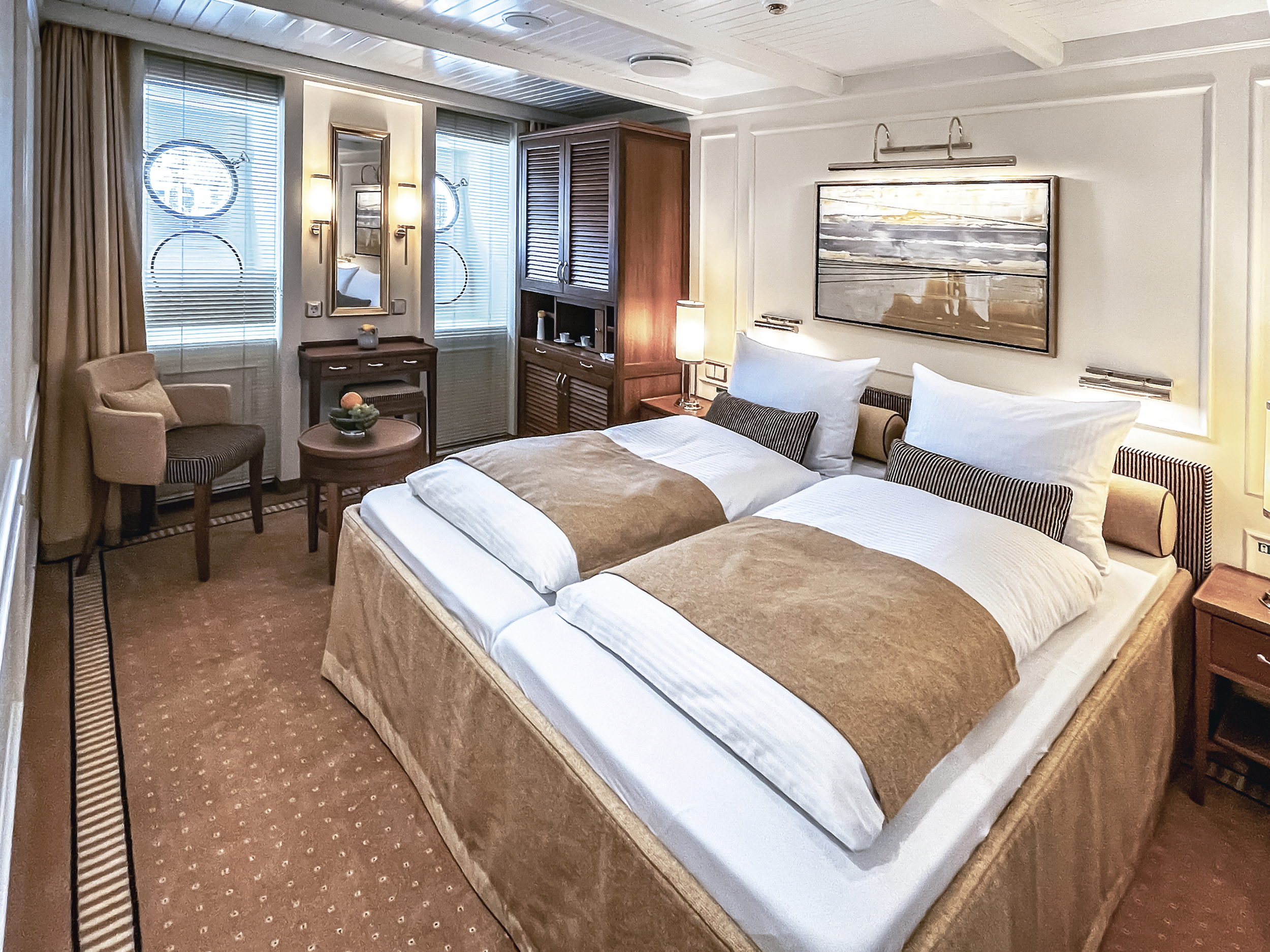
CAT. D Deluxe Staterooms 222
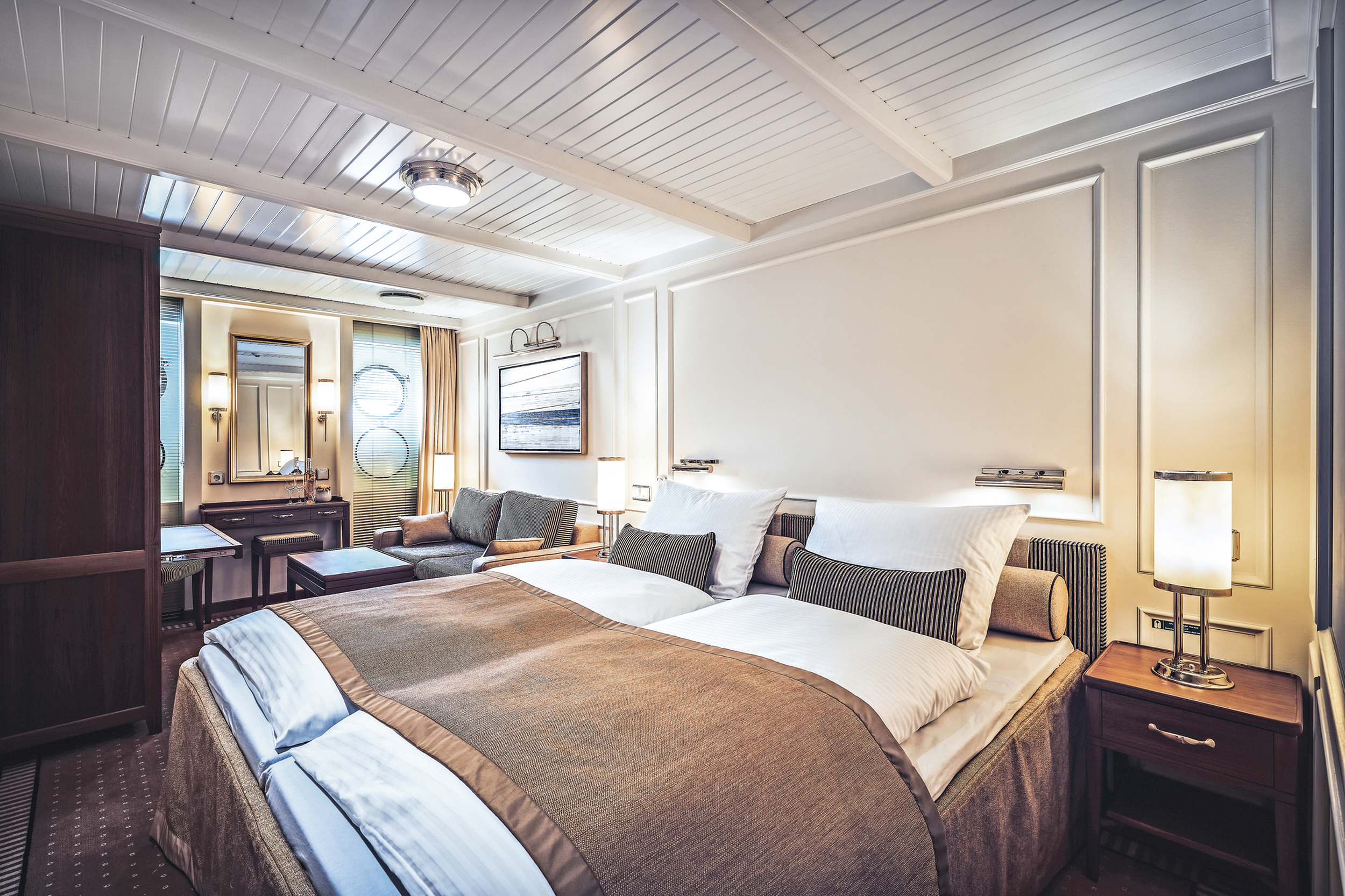
CAT. D Deluxe Staterooms 224

CAT. D Deluxe Staterooms 226
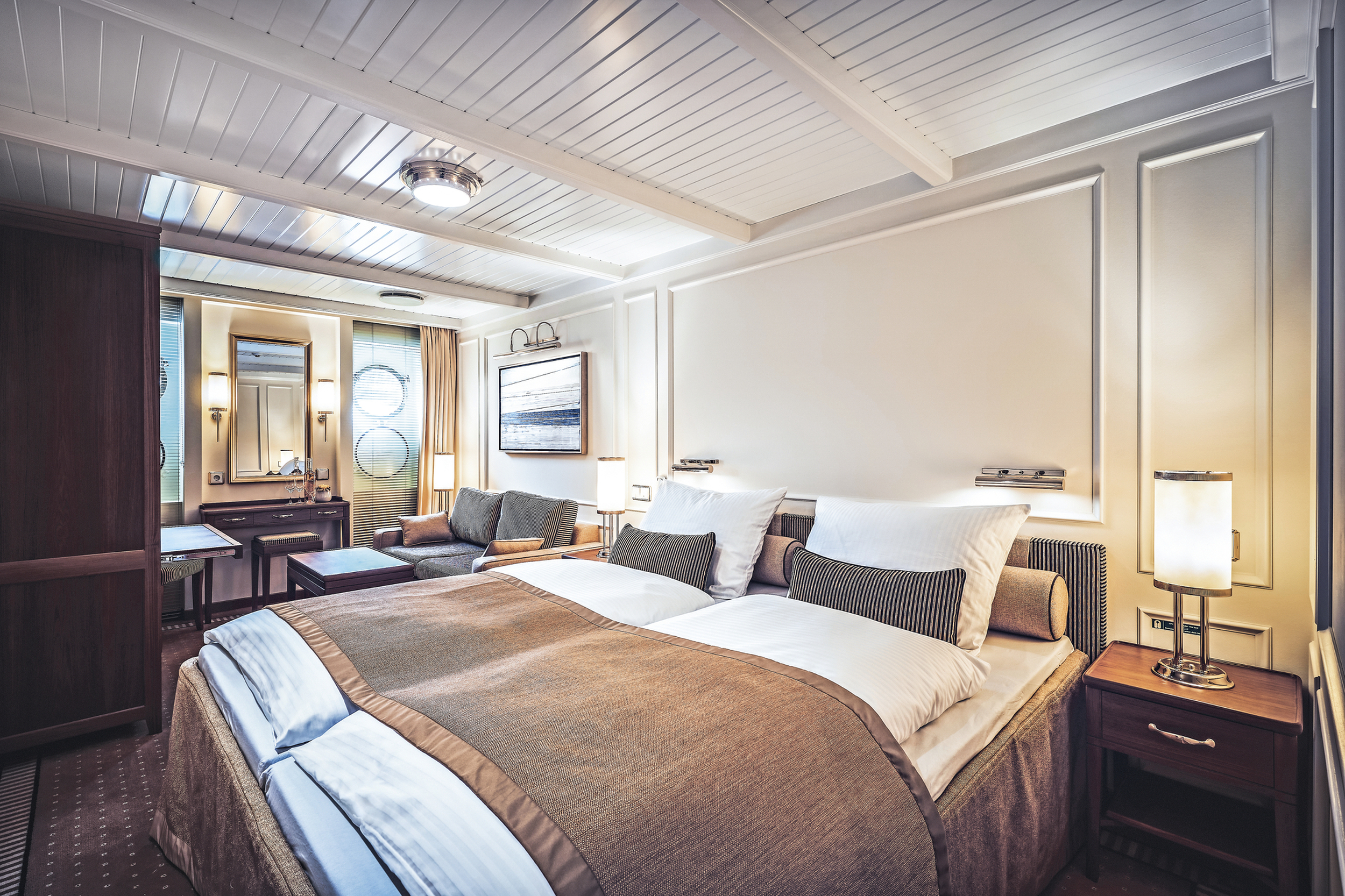
CAT. D Deluxe Staterooms 228
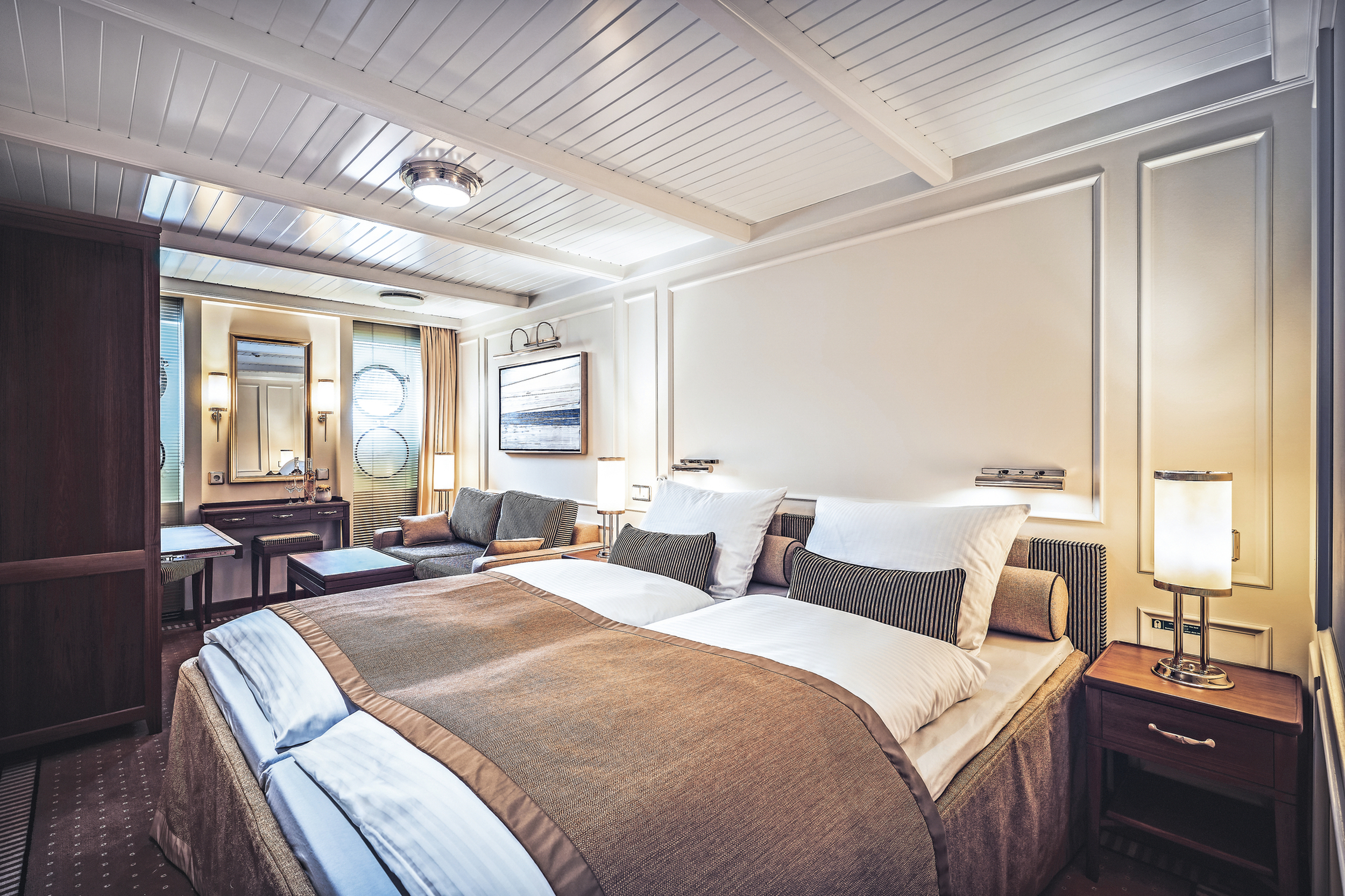
CAT. D Deluxe Staterooms 230
Cat. d deluxe staterooms 232, cat. d deluxe staterooms 234.
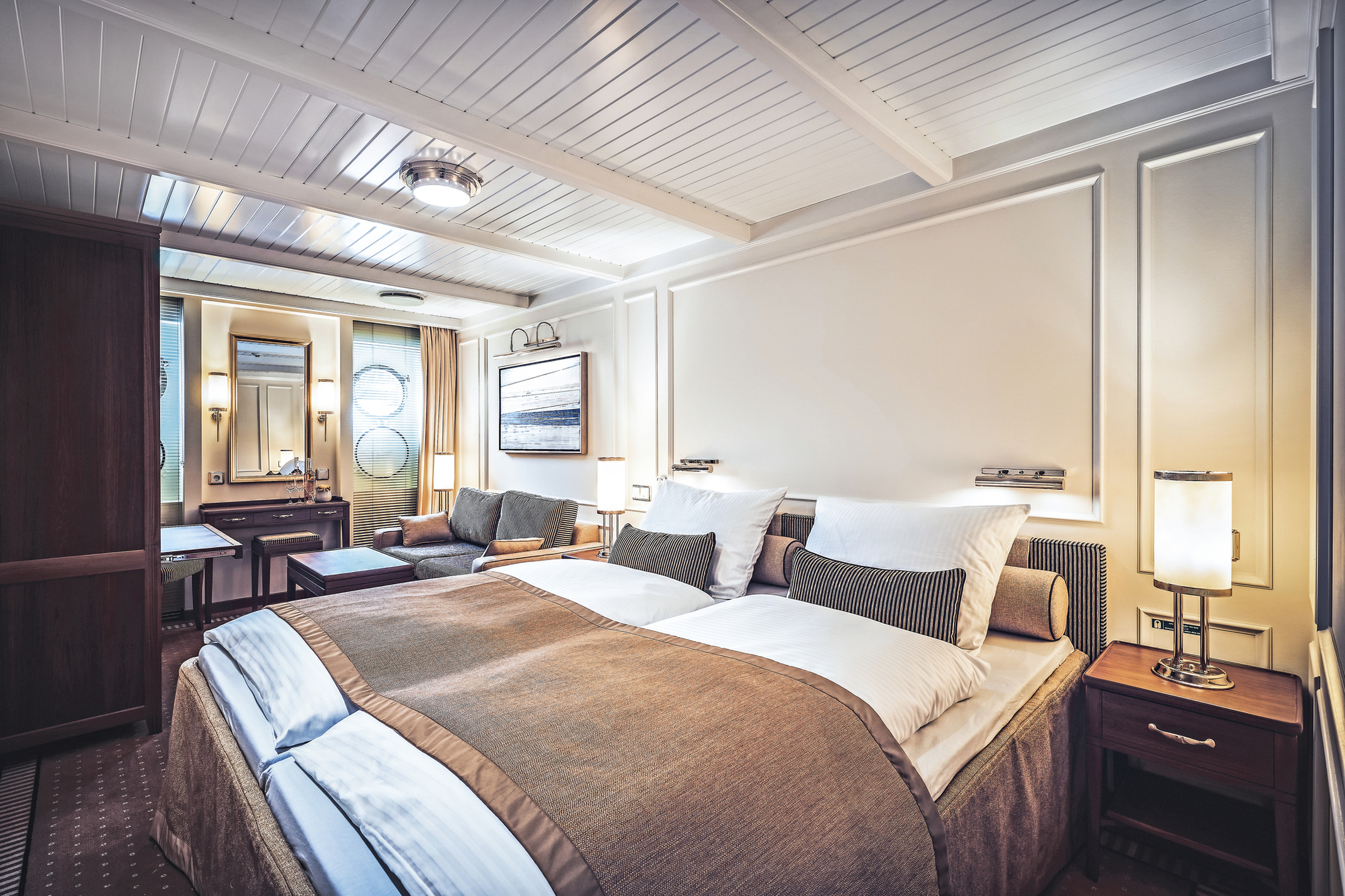
CAT. D Deluxe Staterooms 236
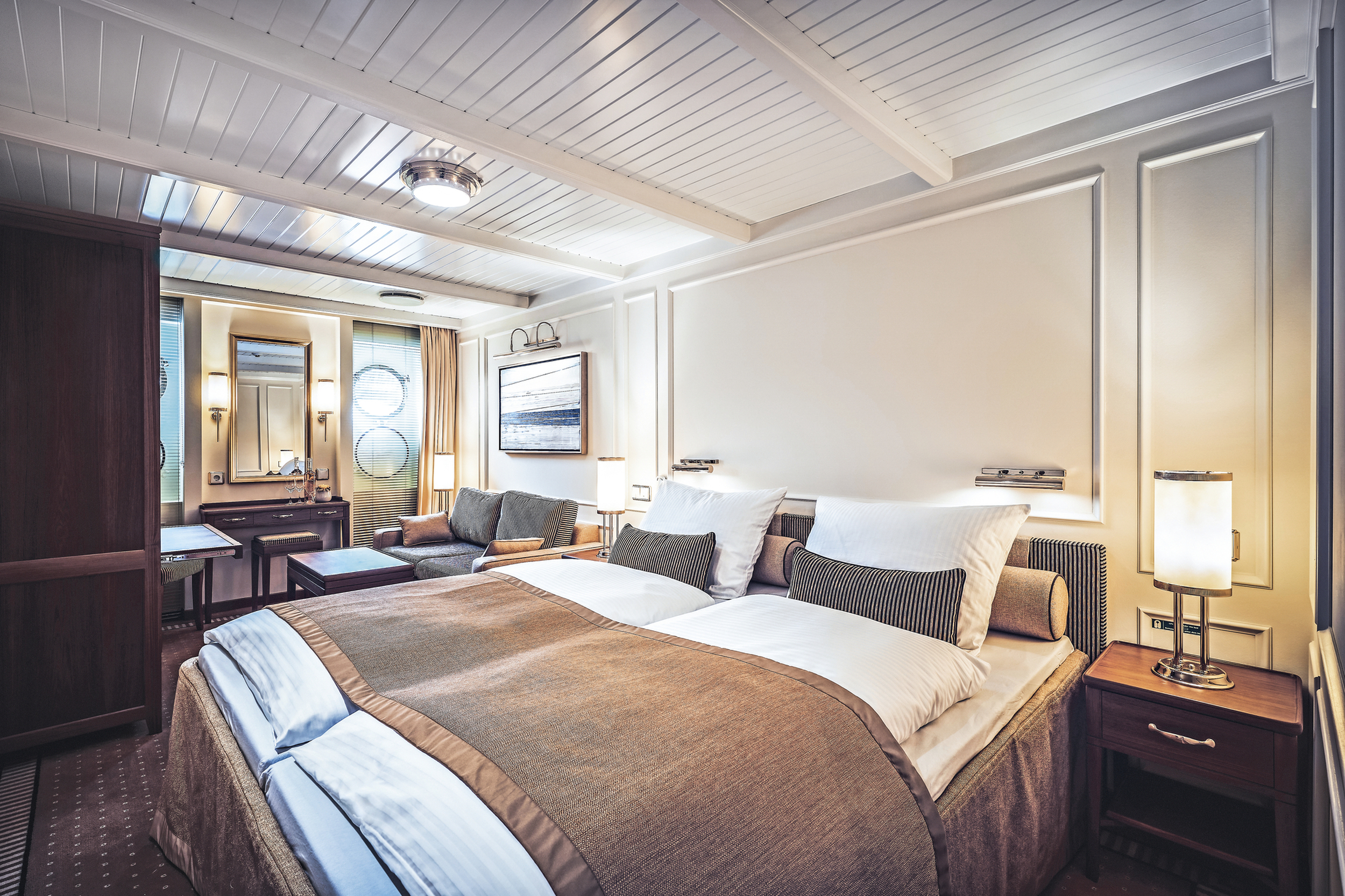
CAT. D Deluxe Staterooms 238
Cat. d deluxe staterooms 240.
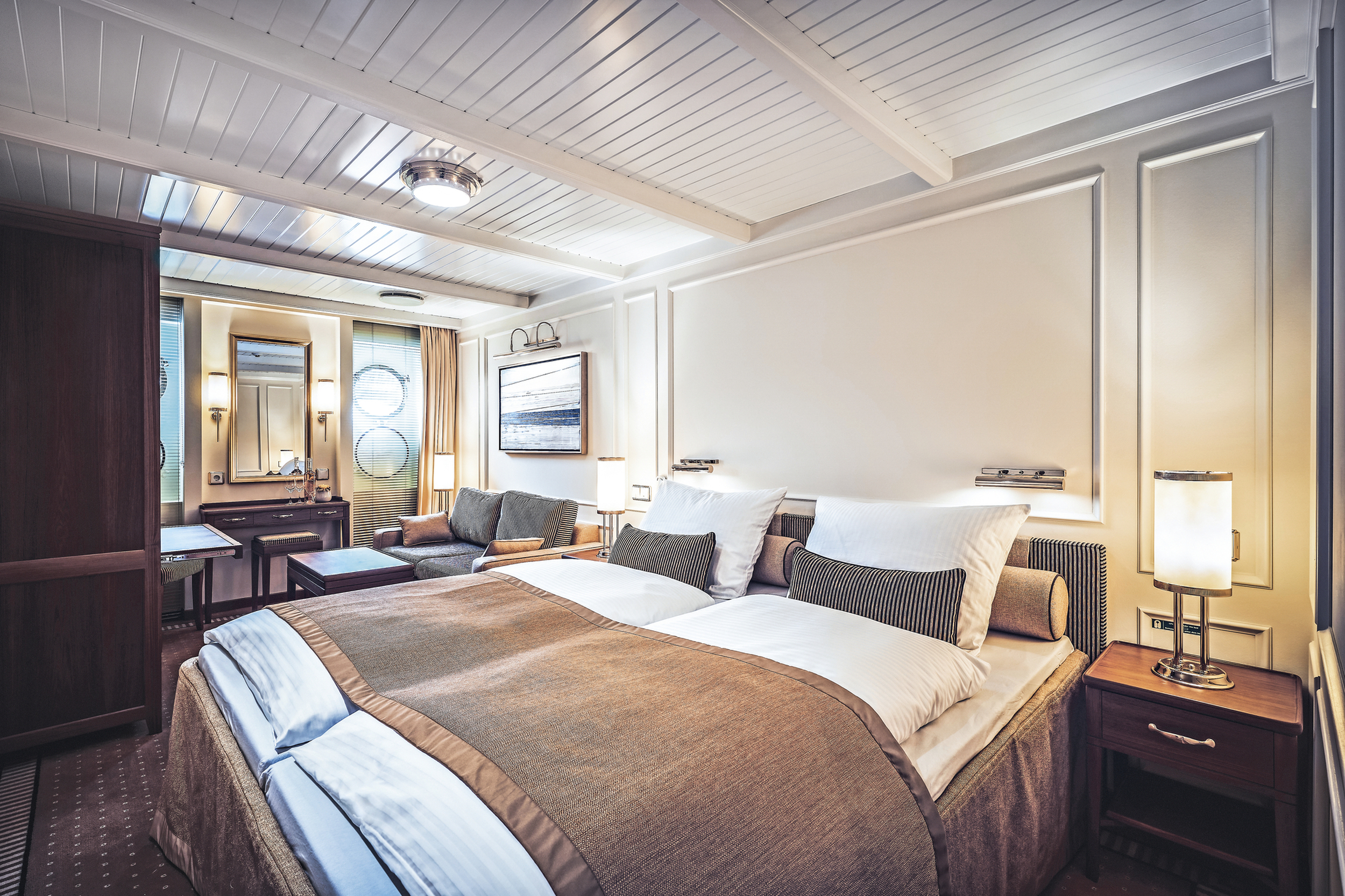
CAT. D Deluxe Staterooms 242
Cat. d deluxe staterooms 231, cat. d deluxe staterooms 233.
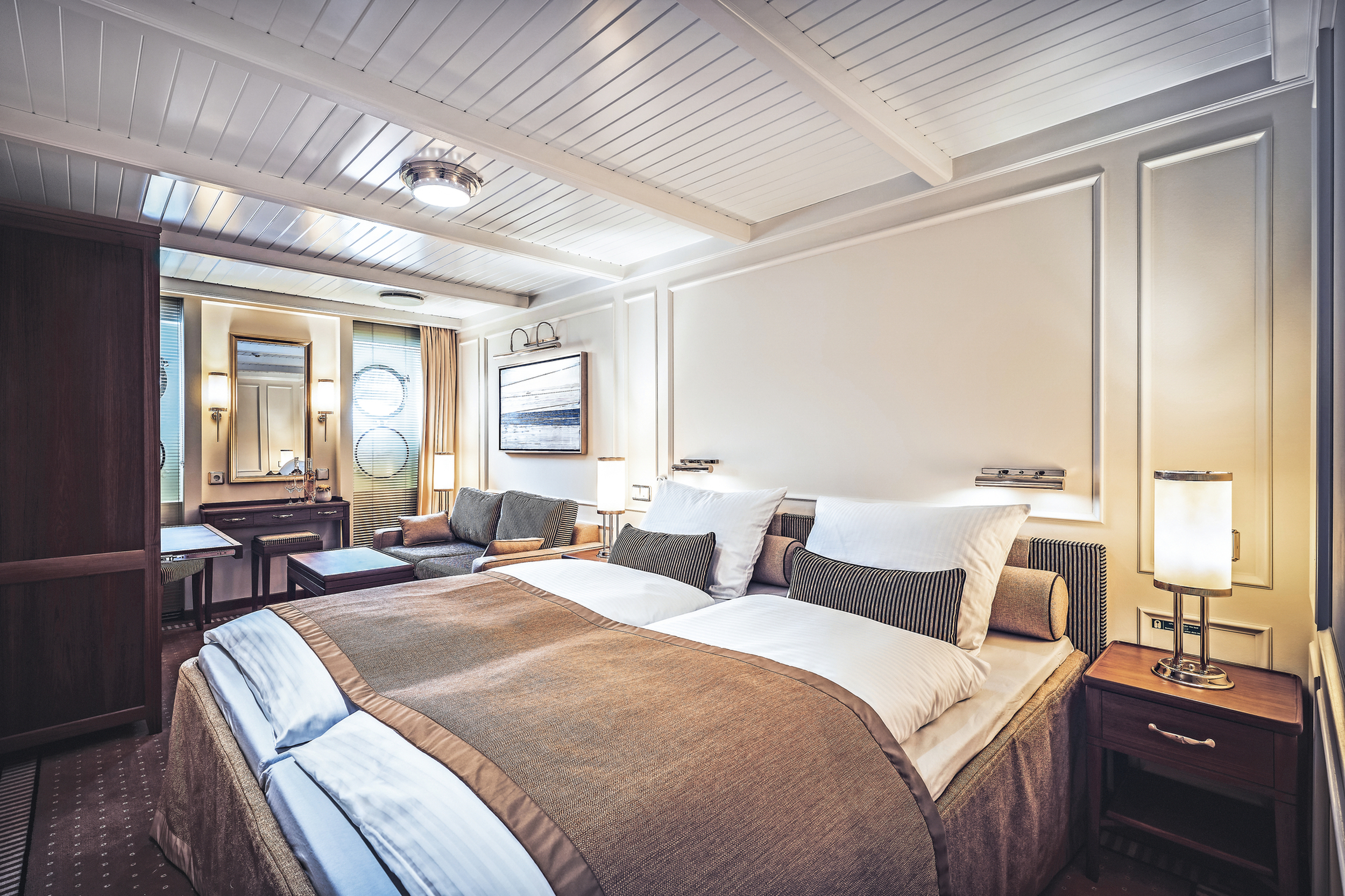
CAT. D Deluxe Staterooms 243
Cat. d deluxe staterooms 235.
- connecting doors on 235/237 and 239/241
CAT. D Deluxe Staterooms 237
Cat. d deluxe staterooms 239, cat. d deluxe staterooms 241.
Guaranteed stateroom: Space is limited. Allocations are at SEA CLOUD CRUISES’ discretion starting in Category E. You will receive your exact stateroom number when arriving on board.
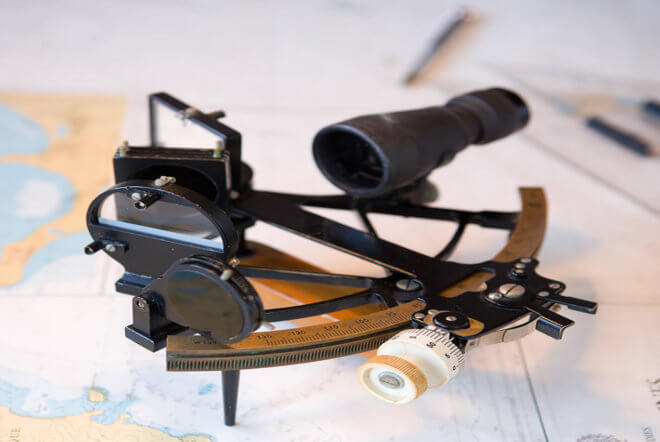
TECHNICAL DATA AND SAIL DIAGRAM
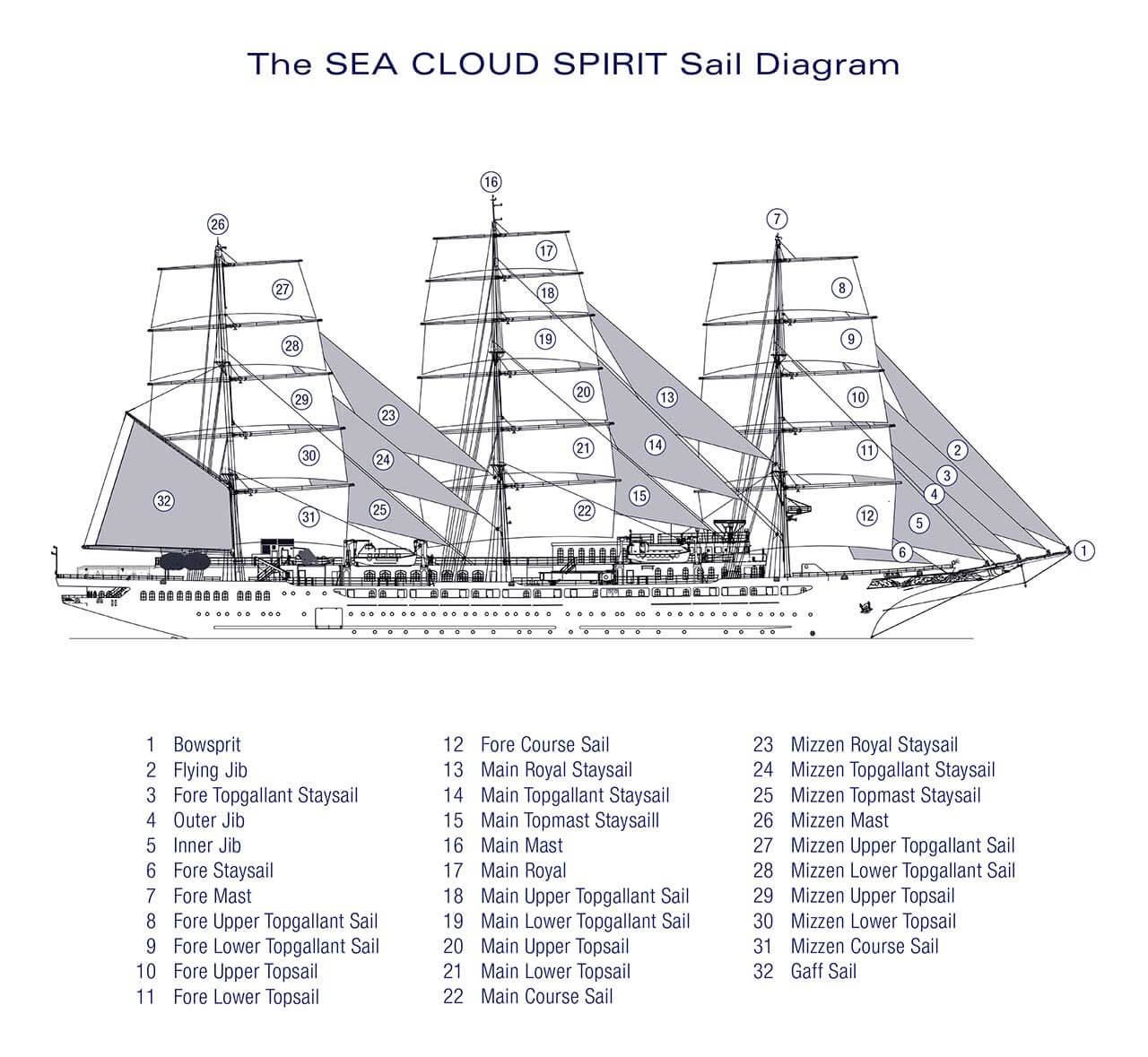
Length overall:
138 m / 452.7 ft
17.20 m / 56.4 ft
5.65 m / 18.5 ft
Height of main mast above waterline:
57.90 m / 190 ft
Total sail area:
approx. 4,100 m² / 44,100 sq ft
Number of sails:
Passengers:
Year of construction:
69 outside cabins (22 junior and 3 owner suites with balconies) and 7 de luxe lido outside cabins with panoramic windows that can be opened
Cabin equipment:
Bathrobes, hair dryer, telephone, adjustable A/C, private safe, minibar, coffee machine, TV with entertainment system, WI-FI, exclusive cosmetics, dressing table, bureau
Public areas:
Restaurant (180° panoramic view) with free seating and one sitting, lido Bar and bistro, lounge with Steinway grand piano, library with comfortable sitting area, sun deck with sunbeds and shower, boutique, hospital, WI-FI
Fitness, wellness & spa
Generous wellness and spa area with two treatment rooms, Finnish sauna, steam bath, relaxation room, multi-sensory shower as well as various massages, beauty parlour and hairdressing salon, fitness area with ocean view and the latest cardio equipment, swim platform, watersports equipment, 4 zodiacs

Watch the “Les Voiles” regatta in St. Tropez

Michelin-star guest chef Michael Collantes and Michelin-star guest sommelier Benjamin Coutts will join this sailing.

Chef Mario Pagan will join this sailing.

- Catalog order
- Legal details
- Privacy information
- Terms and Conditions of Travel and Transportation
- Refund instructions for non-performance of transportation
- EU Regulation
- Disclaimer of liability
- CHF conversion table













IMAGES
COMMENTS
The two-masted rigs are: Lugger - two masts (mizzen), with lugsail (a cross between gaff rig and lateen rig) on both masts. Yawl - two masts (mizzen), fore-and-aft rigged on both masts. Main mast is much taller than mizzen. Mizzen without a mainsail. Ketch - two masts (mizzen), fore-and-aft rigged on both masts.
This distinction refers to the location of the mast step, or where the base of the mast is located. With Keel Stepped, the mast stands on the keel at the bottom of the hull, while Deck Stepped means that the mast stands on the top of the deck. Deck Stepped. The most obvious difference between the two from a livability standpoint is the presence ...
In front of the main mast is called a foremast. The 5 most common two-masted rigs are: Lugger - two masts (mizzen), with lugsail (cross between gaff rig and lateen rig) on both masts. Yawl - two masts (mizzen), fore-and-aft rigged on both masts. Main mast much taller than mizzen. Mizzen without mainsail.
Sailboat masts are the unsung heroes of the sailing world, silently supporting the sails and ensuring a smooth journey across the open waters. Whether you're a seasoned sailor or a novice, understanding the intricacies of sailboat masts is essential for a safe and enjoyable voyage. In this comprehensive guide, we will delve into the world of ...
Full-rigged sailing ship Christian Radich Full-rigged sailing ship Royal Clipper Amerigo Vespucci, full-rigged ship of the Italian Marina Militare. A full-rigged ship or fully rigged ship is a sailing vessel with a sail plan of three or more masts, all of them square-rigged. [1] Such a vessel is said to have a ship rig or be ship-rigged, with each mast stepped in three segments: lower, top ...
Sailboat masts come in various configurations, including single-spreader, double-spreader, and even triple-spreader setups. The number of spreaders - horizontal struts that help support the mast - affects overall stability and rigging options.
Pulling the mast sideways. On our J/35, the mast is stepped belowdecks and must be supported and sealed at the partners. The best way to do this with any mast is by using a pourable rubber called Spartite. With that system, you install the mast, get it positioned perfectly, create a dam with foam and clay at the bottom of the gap between the ...
Welcome aboard the sailing yacht Atlantic. All about one of the most awesome classic yachts of all time, the three mast schooner Atlantic. Long time holder of the world record for the crossing of the Atlantic Ocean under sail, this one hundred and eighty-five foot schooner originally designed by William Gardner in 1903 has been relaunched and is sailing once more.
Sea Eagle II, designed by Dykstra Naval Architects and Mark Whiteley, features an impressive plumb bow and modern Panamax rig by Rondal.With an overall length of 266ft/ 81m, she is the largest yacht built at Royal Huisman's shipyard and joins another Huisman build - Athena - in the top 10 ranking of the world's largest sailing yachts.
Mast. The mast is the tall vertical spar that supports and extends the sails on a sailboat.It stands on the boat's hull, usually at its center, and serves as the backbone of the sailboat's rigging system. In my experience, there are various types of masts, such as single masts, double masts, and even triple masts, depending on the design and size of the sailboat.
more masts. Bark or Barque A sailing vessel with three or more masts: fore and aft rigged on the aftermast, square rigged on all others. Barkentine A 3-masted sailing vessel with square-rigged sails on foremast only. Brig A 2-masted sailing vessel with both masts square rigged. On the stern-most mast, the main mast, there is also a gaff sail.
Cruising sailors once upon a time preferred such rigs, at least on larger cruising boats, because each separate sail requiring handling was smaller and thus more manageable. These days, however, by far the most popular rig for both racing and cruising sailboats is the simple sloop rig. This has a single mast supporting a single Marconi mainsail ...
Three mast sail ships also served another purpose: representing the power and prestige of their countries through flagships. Their voyages enabled the exchange of goods, ideas, and cultures across continents - essential for maintaining diplomatic relationships between nations when long-distance communication relied solely on sea transportation.
Lewis R. French, a gaff-rigged schooner Oosterschelde, a topsail schooner Orianda, a staysail schooner, with Bermuda mainsail. A schooner (/ ˈ s k uː n ər / SKOO-nər) [1] is a type of sailing vessel defined by its rig: fore-and-aft rigged on all of two or more masts and, in the case of a two-masted schooner, the foremast generally being shorter than the mainmast.
Dec 2, 2011. #7. Triple spreader rigs are quite uncommon on CRUISING boats with less than a '65ft' (so called ICW) mast. As another poster stated the advantage is 'less weight aloft' (less mast 'stiffness needed) to lessen the 'roll period', to 'pre-bend' as needed for 'high performance' sailing etc. The disadvantage is the high cost and time ...
That's up for debate. 4. Black Pearl - 106M (348 Ft.) Above: Mega sailing yacht "Black Pearl" moored on July 30, 2019, in Portland harbor, England. The 106-metre, 200 million dollar, mega yacht was designed and built to cross oceans under sail power alone and is owned by Russian billionaire Oleg Burlakov.
SEA CLOUD SPIRIT. Building a three-mast full-rigged ship with traditional rigging in the 21st century may seem a little unusual. For SEA CLOUD CRUISES it is a commitment to true passion for sailing. With her clear, classic line she follows the example of her elegant windjammer sisters, but goes completely new ways. POSSIBILITIES.
The majority of modern boats have their mast raked between 0.75 and 1.5 degrees, with 2 to 2.5 degrees being the conventional upper limit. Some references suggest that fractional rigs should have about twice the rake of a masthead rig, say, 2 to 3 degrees vs. 1 to 2 degrees. Rake is determined and set during design and can help in getting the ...
DAUM'S SAILBOATS. Daum made three different Sailboats designs. The "Regate" was a racing sloop, while the other sailboats were more generic. The single mast design shows a highly curved mast. The three masted sailboat design changed over the years from a 8" tall boat with curved masts, to a 10" tall boat with straighter masts.
I have two masts and they are 28 and 29 metres above deck, she has one, 73 metres above deck." From his own boat, Börner witnessed the loss of Bayesian in the ferocious storm before rescuing 15 ...
Agnes (Russian sailing ship) Alexandria (schooner) USS Alfred. Alma Doepel. Japanese corvette Amagi. American Pride (schooner) Antarctic (ship) SV Argo (1841) Japanese warship Asahi Maru.
The yacht's mast stood 72.27 meters (237 feet) high above the designated water line, just short of the world's tallest mast which is 75.2 meters, according to Guinness World Records.
No one remembers the mast snapping before 56m superyacht Bayesian sunk, says crew. No one recalls seeing the mast snap on board the 56-metre Perini Navi sailing yacht Bayesian which sank off the Italian island of Sicily on 19 August. The eyewitness account of a crewmember on board the vessel, which was obtained by BOAT International, said that the boat was struck by a freak weather event which ...
"It could be that the mast broke, or the anchor at the prow pulled it, I don't know," he said. The seven who weren't rescued included one crew member and six passengers, the coast guard said. The yacht, built in 2008 by the Italian firm Perini Navi, can accommodate 12 passengers in four double cabins, a triple and the master suite, plus ...